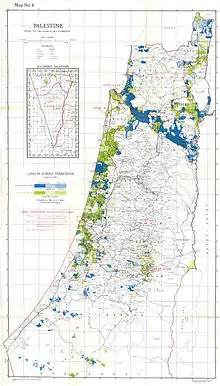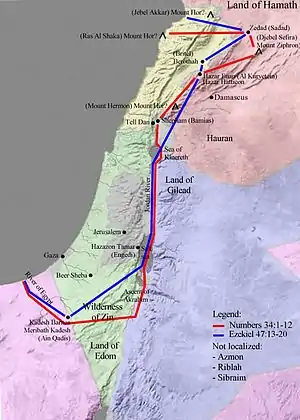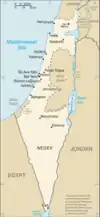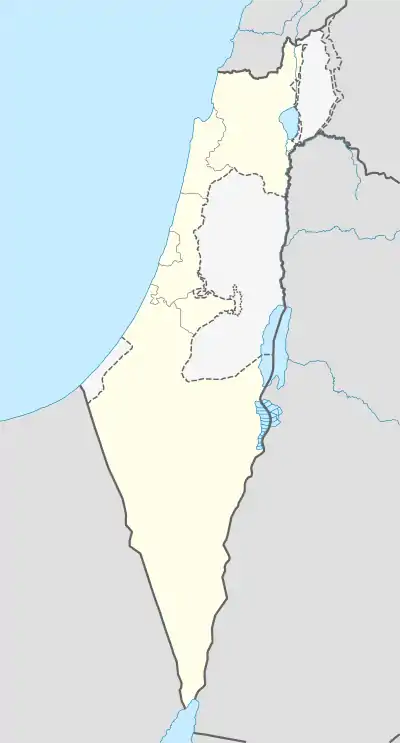History of Palestine
The history of Palestine is the study of the past in the region of Palestine, defined as the territory between the Mediterranean Sea and the Jordan River (where Israel and Palestine are today). Strategically situated between three continents, Palestine has a tumultuous history as a crossroads for religion, culture, commerce, and politics. Palestine is the birthplace of Judaism and Christianity[1] and has been controlled by many kingdoms and powers, including Ancient Egypt, Persia, Alexander the Great and his successors, the Roman Empire, several Muslim dynasties, and the Crusaders. In modern times, the area was ruled by the Ottoman Empire, then the United Kingdom and since 1948 it has been divided into Israel, the West Bank and the Gaza Strip.
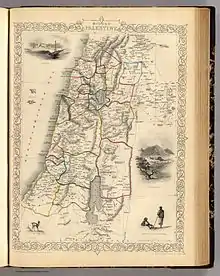
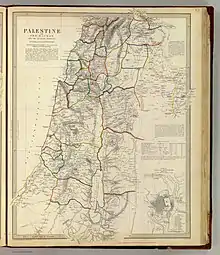
Part of a series on the |
|---|
| History of Palestine |
-Temple_Mount-Dome_of_the_Rock_(SE_exposure).jpg.webp) |
| Prehistory |
| Ancient history |
| Classical period |
| Islamic rule |
| Modern era |
|
|
The region was among the earliest in the world to see human habitation, agricultural communities and civilization. The Canaanites established independent city-states that were influenced by the surrounding civilizations, among them Egypt, which ruled the area in the Late Bronze Age. The Assyrians conquered Palestine in the 8th century BCE, then the Babylonians in c. 601 BCE, followed by the Persians who conquered the Babylonian Empire in 539 BCE. Alexander the Great conquered Palestine in the late 330s BCE, beginning a long period of Hellenization. In the late 2nd century BCE, the semi-independent Hasmonean kingdom conquered most of Palestine but the kingdom gradually became a vassal of Rome, which annexed Palestine in 6 BCE. Roman rule was troubled by Jewish rebellions, which Rome answered with by destroying the Jews' temple. In the 4th century, as the Roman Empire Christened, Palestine became a center of Christianity, attracting pilgrims, monks and scholars.
Following the Muslim conquest of Palestine in 636–640, several Muslim ruling dynaties succeeded each other as they wrestled control of Palestine: the Rashiduns; the Umayyads, who built the Dome of the Rock and the al-Aqsa Mosque in Jerusalem; the Abbasids; the semi-independent Tulunids and the Ikhshidids; the Fatimids; and the Seljuks. In 1099, the Crusaders established the Kingdom of Jerusalem in Palestine, which the Ayyubid Sultanate conquered in 1187. The Crusaders failed to retake Palestine despite further attempts. The Egyptian Mamluks took Palestine from the Mongols (who had conquered the Ayyubid Sultanate) in 1260. The Ottomans captured Palestine in 1516 and ruled it until Egypt took it in 1832. Eight years later, the United Kingdom intervened and returned the region to the Ottomans. Considerable demographic changes happened during the 19th century and with the regional migrations of Druze, Circassians and Bedouin tribes. The emergence of Zionism also brought many Jewish immigrants from Europe, and the revival of the Hebrew language.[2]
During World War I the British government issued the Balfour Declaration, favoring the establishment of a national home for the Jewish people in Palestine. The British captured Palestine from the Ottomans shortly thereafter. The League of Nations gave Britain mandatory power over Palestine in 1922. Jewish mass immigration and colonial rule led to sectarian violence between Jews and Arabs, eventually causing the British government to announce its intention to terminate the Mandate in 1947. The United Nations General Assembly recommended partitioning Palestine into two states; one Arab and one Jewish. However, the situation in Palestine had deteriorated into a civil war between Arabs and Jews. The Arabs rejected the Partition Plan, the Jews ostensibly accepted it, declaring the independence of the State of Israel in May 1948 upon the termination of the British mandate. Nearby Arab countries intervened in the war, but Israel not only prevailed but also conquered far more territory of the Mandate than envisioned by the Partition Plan. During the war, 700,000, or about 80% of all Palestinians fled or were driven out of the territory that Israel conquered, and were not allowed to return, in an event that became known as the Nakba ("Catastrophe") to the Palestinians. Starting in the late 1940s and continuing for decades thereafter, about 850,000 Jews from the Arab world immigrated ("made Aliyah") to Israel.
After the war, only two parts of Palestine remained in Arab control: the West Bank (and East-Jerusalem), annexed by Jordan, and the Gaza Strip (occupied by Egypt), which were conquered by Israel during the Six-Day War in 1967. Despite international objections, Israel started to establish settlements in these occupied territories.[3] Meanwhile, the Palestinian national movement gradually gained international recognition, largely thanks to the Palestine Liberation Organisation (PLO, founded in 1965) under the leadership of Yasser Arafat. In 1993, the Oslo Peace Accords between Israel and the PLO established the Palestinian National Authority (PA) as an interim body to run parts of Gaza and the West Bank (but not East Jerusalem) pending a final solution to the conflict. Further peace developments were not ratified and/or implemented, and in recent history, relations between Israel and Palestinians have been marked by repeated military conflicts, especially with the Islamist group Hamas, which also rejects the PA. In 2007, Hamas won control of Gaza from the PA, now limited to the West Bank. In November 2012, the State of Palestine (the name used by the PA) became a non-member observer state in the UN, allowing it to take part in General Assembly debates and improving its chances of joining other UN agencies.
Prehistoric period
The earliest human remains in Palestine were found in Ubeidiya, some 3 km south of the Sea of Galilee (Lake Tiberias), in the Jordan Rift Valley. The remains are dated to the Pleistocene, c. 1.5 million years ago. These are traces of the earliest migration of Homo erectus out of Africa. The site yielded hand axes of the Acheulean type.[4]
Wadi El Amud between Safed and the Sea of Galilee was the site of the first prehistoric dig in Palestine, in 1925. The discovery of Palestine Man in the Zuttiyeh Cave in Wadi Al-Amud near Safed in 1925 provided some clues to human development in the area.[5][6] Qafzeh is a paleoanthropological site south of Nazareth where eleven significant fossilised Homo sapiens skeletons have been found at the main rock shelter. These anatomically modern humans, both adult and infant, are now dated to about 90–100,000 years old, and many of the bones are stained with red ochre, which is conjectured to have been used in the burial process, a significant indicator of ritual behavior and thereby symbolic thought and intelligence. 71 pieces of unused red ochre also littered the site. Mount Carmel has yielded several important findings, among them Kebara Cave that was inhabited between 60,000 and 48,000 BP and where the most complete Neanderthal skeleton found to date. The Tabun cave was occupied intermittently during the Lower and Middle Paleolithic ages (500,000 to around 40,000 years ago). Excavations suggest that it features one of the longest sequences of human occupation in the Levant. In the nearby Es Skhul cave excavations revealed the first evidence of the late Epipalaeolithic Natufian culture, characterized by the presence of abundant microliths, human burials and ground stone tools. This also represents one area where Neanderthals—present in the region from 200,000 to 45,000 years ago—lived alongside modern humans dating to 100,000 years ago.[7] In the caves of Shuqba in Ramallah and Wadi Khareitun in Bethlehem, stone, wood and animal bone tools were found and attributed to the Natufian culture (c. 12,800–10,300 BCE). Other remains from this era have been found at Tel Abu Hureura, Ein Mallaha, Beidha and Jericho.[8]
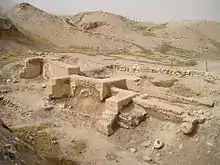
Between 10,000 and 5000 BCE, agricultural communities were established. Evidence of such settlements were found at Tel es-Sultan in Jericho and consisted of a number of walls, a religious shrine, and a 23-foot (7.0 m) tower with an internal staircase[9][10] Jericho is believed to be one of the oldest continuously inhabited cities in the world, with evidence of settlement dating back to 9000 BCE, providing important information about early human habitation in the Near East.[11] Along the Jericho–Dead Sea–Bir es-Saba–Gaza–Sinai route, a culture originating in Syria, marked by the use of copper and stone tools, brought new migrant groups to the region contributing to an increasingly urban fabric.[12][13][14]
Bronze Age
By the early Bronze Age (3000–2200 BCE), independent Canaanite city-states situated in plains and coastal regions and surrounded by mud-brick defensive walls were established relying on nearby agricultural hamlets for their food.[15] The Canaanite city-states held trade and diplomatic relations with Egypt and Syria. Parts of the Canaanite urban civilization were destroyed around 2300 BCE, though there is no consensus as to why. Incursions by nomads from the east of the Jordan River who settled in the hills followed soon thereafter.[12][16]
In the Middle Bronze Age (2200–1500 BCE), Canaan was influenced by the surrounding civilizations of ancient Egypt, Mesopotamia, Phoenicia, Minoan Crete, and Syria. Diverse commercial ties and an agriculturally based economy led to the development of new pottery forms, the cultivation of grapes, and the extensive use of bronze.[12][17] Burial customs from this time seemed to be influenced by a belief in the afterlife.[12][18] The Middle Kingdom Egyptian Execration Texts attest to Canaanite trade with Egypt during this period.[19][20] The Minoan influence is apparent at Tel Kabri.[21]
A DNA analysis published in May 2020[22][23] showed that migrants from the Caucasus mixed with the local population to produce the Canaanite culture that existed during the Bronze Age.[24][25]
New Kingdom (Egypt)
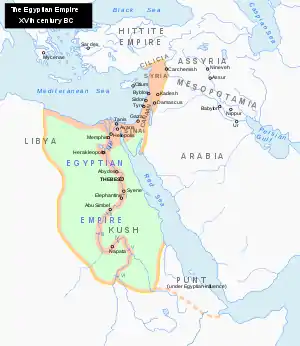
During 1550–1400 BCE, the Canaanite cities became vassals to Egypt as the Egyptian New Kingdom reunited Egypt and expanded into the Levant under Ahmose I and Thutmose I. Political, commercial and military events towards the end of this period (1450–1350 BCE) were recorded by ambassadors and Canaanite proxy rulers for Egypt in 379 cuneiform tablets known as the Amarna Letters.[26] These refer to several local proxy rulers for Egypt such as Biridiya of Megiddo, Lib'ayu of Shechem and Abdi-Heba in Jerusalem. Abdi-Heba is a Hurrian name, and enough Hurrians lived in Palestine at that time to warrant contemporary Egyptian texts calling the people of Syro-Palestinians Ḫurru.[27]
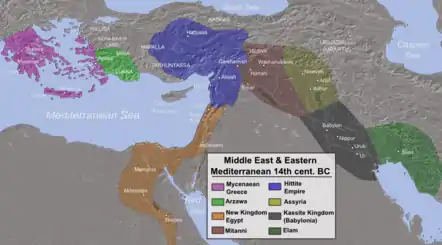
In the first year of his reign, the pharaoh Seti I (ca.1294–1290 BCE) waged a campaign to resubordinate Canaan to Egyptian rule, thrusting north as far as Beit Shean, and installing local vassals to administer the area in his name. A burial site yielding a scarab bearing his name, found within a Canaanite coffin excavated in the Jezreel Valley, attests to Egypt's presence in the area.[28]
Beginning in the late 13th century and continuing to the early 11th century, hundreds of smaller, unprotected village settlements were founded in Palestine, many in the mountainous regions. The number of villages reduced in the 11th century, counterbalanced by other settlements reaching the status of fortified townships.[29]
Iron Age: Canaanites, Israelites and Philistines
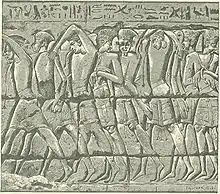
The Iron Age in Palestine stretches from about the 12th century to the 5th century BCE. For long, historians relied on the stories in the Hebrew Bible to create a narrative of the period. These stories have largely been discarded as myths as more archaeological finds have been unearthed that paints a radically different view of the epoch.[30][31]
Sometime in the 12th century, the Philistines occupied the southern coast of Palestine.[32] The Philistines are credited with introducing iron weapons, chariots, and new ways of fermenting wine to the local population.[33] Over time the Philistines integrated with the local population and they, like the other people in Palestine, were engulfed by first the Assyrian empire and later the Babylonian empire.[34] In the 6th century, they disappeared from written history.[35]
Traces of early Israelites appeared at about the same time as the Philistines.[36] The Israelites inhabited Palestine's barren hill country, a loosely defined highland region stretching from the Judean hills in the south to the Samarian hills in the north. The population, at most forty-five thousand, were poor and lived relatively isolated from the Canaanite city-states that occupied the plains and the coastal regions.[37] By the 8th century BCE, the population had grown to some 160,000 individuals over 500 settlements split into the two kingdoms Israel in the north and Judah in the south.[38] Israel was the more prosperous of the kingdoms and developed into a regional power while Judah was economically marginal and backward.[39] In contrast to the Philistines, the Israelites did not eat pork,[40] preferred plain pottery,[41] and circumsized their boys.[42]
The socio-political system during the early Iron Age was characterized by infighting among the chieftains in Palestine as Egypt withdrew from the region. This lasted until around the mid-9th century when local chieftains managed to create large political structures that exceeded the boundaries of those present in the Late Bronze Age Levant.[43]
The Omride kings greatly expanded the Israelite kingdom. In the mid-9th century, it stretched from the vicinity of Damascus in the north to the territory of Moab in the south, ruling over a large number of non-Israelites.[44] In 853 BCE, the Israelite king Ahab led a coalition of anti-Assyrian forces at the Battle of Qarqar that repelled an invasion by King Shalmaneser III of Assyria.[45] Some years later, King Mesha of Moab, a vassal of Israel, rebelled against it, destroying the main Israelite settlements east of Jordan.[46][47]
In the 830s BCE, king Hazael of Aram Damascus conquered the fertile and strategically important northern parts of Israel which devastated the kingdom.[48]
In the late 9th century BCE, Israel under King Jehu became a vassal to Assyria and was forced to pay tribute.[49][50]
Assyrian and Babylonian periods
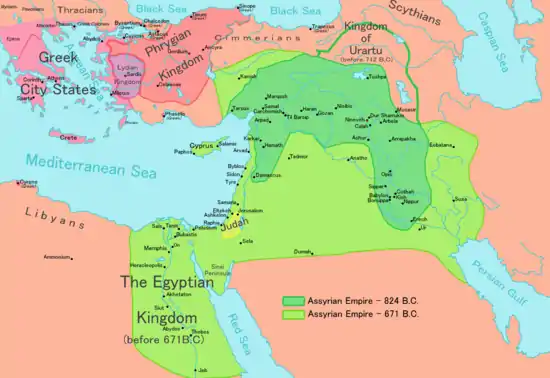
The Assyrian king Tiglath Pileser III was discontent with the empire's system of vassal states and set to control them more directly or even turn then into Assyrian provinces.[51] Tiglath Pileser and his successors conquered Palestine beginning in 734 BCE to about 645 BCE.[52] This policy had lasting consequences for Palestine as its strongest kingdoms were crushed, inflicting heavy damage, and parts of the kingdoms' populations were deported.[53]
Israel was eradicated in 720 BCE as its capital, Samaria, fell.[54] The Assyrian expansion continued southward, gradually conquering Egypt and taking Thebes in 664 BCE.[55] A line of city-states on the Palestinian and Phoenician coast were allowed to remain independent, as well as four small kingdoms in the hill country and Jordan valley; Edom, Judah, Ammon, and Moab. From an Assyrian standpoint, they were weak and nonthreatening.[56]
Struggles over succession following the death of King Ashurbanipal in 631 BCE[fn 1] weakened the Assyrian empire. This allowed Babylon to revolt and to eventually conquer most of Assyria's territory.[57] Meanwhile, Egypt reasserted its power and created a system of vassal states in Palestine that were obliged to pay taxes in exchange for military protection.[58]
In 616 BCE, Egypt sent its armies north to intervene on behalf of the fading Assyrian empire against the Babylonian threat. The intervention was unsuccessful; Babylon took Assyria's Nineveh in 612 and two years later Harran.[59] In 609 the Egyptian pharaoh Necho II again marched north with his army. For some reason, he executed the Judahite king Josiah at the Egyptian base Megiddo and a few months later he installed Jehoiakim as the king of Judah.[60] At the Battle of Carchemish in 605, the Babylonians routed the Egyptian forces, causing them to flee back to the Nile.[61] The next year, the Babylonian king Nebuchadnezzar destroyed the Philistine cities Ashdod, Ekron, Ashkelon, and Gaza.[62] By 601 all the former states in Palestine had become Babylonian colonies.[63]
In 601 BCE Nebuchadnezzar launched a failed invasion of Egypt which forced him to withdraw to Babylon to rebuild his army. This failure was interpreted as a sign of weakness, causing some vassal states to defect, among them Judah.[64] Nebuchadnezzar responded by laying siege to Jerusalem in 598 to end its revolt. He captured the city in 597.[65]
In 587 Nebuchadnezzar again laid waste to Judah and Jerusalem was captured and sacked the next year.[66] The semi-independent kingdoms in southern Palestine, Judah, Gaza, Ashkelon, Ashdod, and Ekron, were dissolved and incorporated into the Babylonian empire as provinces.[67] Judah was moulded into the province Yehud with Mizpah north of Jerusalem as its administrative center.[68]
The Babylonians continued the practices of their predecessors the Assyrians and deported populations that resisted its military might.[69] Many of them were settled in Babylon and were used to rebuild the country which had been devastated through the long years of conflict with the Assyrians.[70] The Judahite king and Jerusalem's aristocracy and priesthood was deported to Babylon in 597.[71] Further waves of deportations took place in 587 and 582.[72]
Persian period
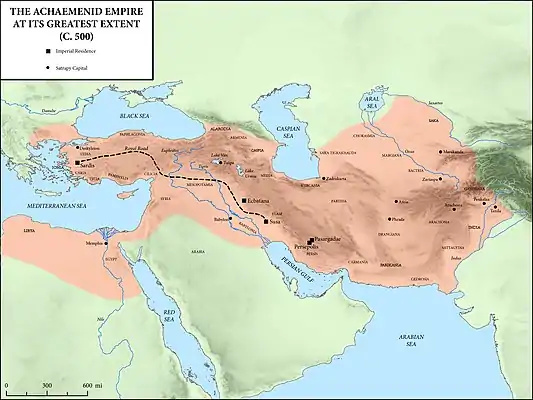
Following Cyrus the Great's conquest of Babylon in 539 BCE, Palestine became part of the Persian empire (also known as the Achaemenid empire).[73]
The Persians' major policy goal in Palestine was to encourage trade and to secure important trade routes, such as the coastal Via Maris road.[74] Another goal was to form political, military, and economic alliances to counter the Greek dominance of the eastern Mediterranean.[74] They therefore established many well-built and planned cities along the Palestinian coast surrounded by forts and administrative centers which became wealthy urban centers.[74] In contrast to their predecessors, the Assyrians and the Babylonians, who ruled by fear and mass-deportations, the Persians resettled exiles in their homelands and rebuilt their temples. This allowed them to present themselves as liberators, gaining them the goodwill of the people in the empire's provinces.[75][76] Many deportees returned, though many choose not to.
Despite the devastating wars between Greece and Persia, Greek cultural influences rose steadily.[77] Greek coins began to circulate in the late 6th and early 5th centuries.[78] Greek traders established trading posts along the coast in the 6th century from which Greek ceramics, artworks, and other luxury items were imported.[79] These items were popular and no well-to-do Palestinian household would have lacked Greek pottery.[80] Local potters imitated the Greek merchandise, though the quality of their goods were inferior to the Greeks'.[81]
At least five Persian provinces existed in Palestine; Yehud, Samaria, Gaza, Ashdod, and Ascalon,[82] in addition to the Phoenician city states in the north and the Arabian tribes in the south.[83][84]
The Phoenician city states, whose war fleets were indispensable to the Persians, were allowed to maintain their existence as vassal kingdoms.[83] In the many wars with the Greeks, the Phoenicians were obliged to put their fleets at the disposal of the Persian kings. Around the turn of the 5th and 6th centuries BCE, Persia gave the northern Palestinian coast all the way to Ashdod to the Phoenician kings of Tyre and Sidon.[85] Perhaps to facilitate maritime trade[86] or as a reward for services rendered.[87] At about the same time the Upper Galilee was also granted to the Tyrians.[88] In the middle of the 4th century the Phoenicians occupied the entire coast as far as Ascalon in southern Palestine.[89]

Nomadic Arabian tribes roamed the Negev and southern Palestine. They were of paramount strategic and economic importance to the Persians due to their control of desert trade routes stretching from Gaza in the north, an important trading center,[90] to the Arabian peninsula in the south. Unlike the people in the provinces, the tribes were considered "friends" with the empire rather than subjects and they enjoyed some independence from Persia.[91] Until the midddle of the 4th century, the Qedarites were the dominant tribe whose territory ran from the Hejaz in the south to the Negev in the north.[92] Around 380 BCE, the Qedarites joined a failed revolt against the Persians and as a consequence they lost their frankincense trade privileges. The trade privileges were taken over by the Nabataeans, an Arab tribe whose capital was in Petra in Transjordan. They established themselves in the Negev where they built a flourishing civilization.[93]
Another people in southern Palestine was the Edomites. They had established a kingdom (Edom) in the southern area of modern-day Jordan but were pushed westward by nomadic tribes coming from the east, among them the Nabataeans, and therefore migrated into southern parts of Judah. This migration had already begun a generation or two before the Babylonian conquest of Judah, but as Judah was weakened the pace accelerated. Their territory became known as Idumea.[94]
In Yehud, major religious transformations took place; customs and behavior that would come to characterize Jews and Judaism were adopted during this period.[95] Most importantly, Israelite religion became exclusively monotheistic - the existence of other Gods was now denied. Previously, Yahweh, Israel's god, had been seen as one god among many.[96] The temple in Jerusalem, which had been destroyed by the Babylonians, were rebuilt under the auspicies of Jews who had returned from Babylon.[32]
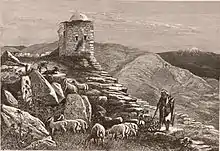
Remnants of the Samaritans' temple at Mount Gerizim near Shechem dates to the 5th century.[97] The Samaritans are an ethno-religious group originating in Samaria who, like the Jews, worship Yahweh and claim ancestry to the Israelites.[98] Their temple cult centered around Mount Gerizim competed with the Jews' temple cult centered around Mount Moriah in Jerusalem and led to long-lasting animosity between the two groups.[99][fn 2]
In 404 BCE, Egypt threw off the Persian yoke and began extending its domain of influence and military might in Palestine and Phoenicia, leading to confrontations with Persia. The political pendulum swung back and forth as territory was conquered and reqoncured.[100] For a brief period of time, Egypt controlled both coastal Palestine and Phoenicia.[101] Egypt was eventually reconquered by Persia in 343.[102]
The first Palestinian coins were minted by the Phoenicians followed by Gaza, Ashkelon, and Ashdod.[103] Yehud began minting coins in the second quarter of the 4th century.[104] By the 6th century, Aramaic had replaced Hebrew as the spoken language in Palestine,[105] and it became the region's lingua franca.[106] Hebrew remained as a language for the upper class and as a religious language.[105]
Classical antiquity
Hellenistic period
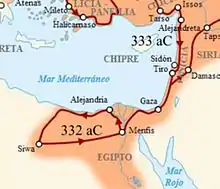
In the late 330s BCE, Alexander the Great conquered Palestine on his way to Egypt. The conquest was a relatively uncomplicated as Persian control of the region had already waned.[107] Tyre and Gaza were the only cities that did not immediately submit to Alexander[108] who slaughtered their citizens as punishment.[109][fn 3]
After Alexander's death in 323 BCE, his vast empire was divided between his generals, known as the Diadochi ("successors"), who fought each other for control over it.[110] Ptolemy I Soter established himself as the ruler of Egypt. His main rival was the Diadochi Antigonus I Monophthalmus with whom he wrestled control of Palestine for several decades.[111] Ptolemy took Palestine in 320-318 BCE,[112] but had to withdraw in 315 BCE to avoid a confrontation with Antigonus who had invaded.[113] With the help of Diadochi Seleucus I Nicator, he captured Palestine in 312 BCE, but could only hold it for a few months as Antigonus armies were approaching again.[114] The events of 312 BCE repeated in 302 BCE, but in 301 BCE Antigonus was defeated by a coalition of Diadochi kings and the province was awarded to Seleucus.[110] Seleucus did not attempt to conquer the province he was due and his former ally, Ptolemy, occupied it. However, he did not relinquish his claim to it, leading to several wars being fought for the control of Palestine between Ptolemy's and Seleucid's successors over the following century.[115] In the fifth of these wars, in 201/200 BCE, the Seleucids conquered Palestine from the Ptolemies for good.[116]
In contrast to the Persians, who stayed out of the internal affairs of the conquered peoples,[117] the Greeks introduced Greek language, culture, customs, religion and architecture to the regions that they controlled - a process called hellenization ("greekification").[118] Hellenization was pervasive in Palestine; speaking Greek and adopting Greek customs conferred many benefits for the upper classes.[119] Hellenistic pottery absorbing Philistine traditions flourished.[120] Hellenization took root first in the densely settled coastal and lowland areas, and only really began to impinge on more backward areas such as Judea in the early 2nd century.
The Greeks also founded many Greek cities, known as poleis, whose residents were granted tax exemptions and other privileges. The poleis had Greek style governments, Greek institutions and temples for the worship of Greek gods.[121] Many of these cities were not new establishments but rather were rebuilt and renamed, often after the king's themselves.[121] For example, Akko was refounded as Ptolemais (becoming the region's capital during the Ptolemaic era) and Rabbath-Ammon, the capital of the Ammonites, was renamed Philadelphia (after Ptolemy II Philadelphos).[121] The poleis won the Greeks the loyalty of the residents whose living standards rose.[122]
Trade and commerce flourished, particularly in Palestine's most Hellenized areas.[123]
Ptolemaic era
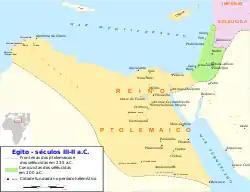
The Ptolemaic era lasted to 201 BCE and was, despite the numerous wars, a time of peace and prosperity for Palestine.[124]
A fundamental concept for the Ptolemaic kings and all Hellenistic monarchs was to treat all land as their personal property.[125] Agriculture was controlled using a complicated system of leasing and state supervision.[126] State monopolies were enacted on a number of important goods such as oil, grain, salt, linen, and beer.[127] The Ptolemies also introduced tax farming; the auctioning of tax collection to wealthy locals. If the tax farmer failed to raise the bidded amount, they had to pay for shortfalls out of their own pockets but they could keep the surpluses.[128] Tax farming proved to be very lucurative for many persons who engaged in it.[129] Unlike in Egypt, where tax farmers and bureaucrats for the most part were Greeks, in Palestine it allowed an indigenous upper class to interpose itself between the rural population and the state apparatus.[130] These policies made the Ptolemaic kings some of the richest in the world, but also guaranteed the greatest possible exploitation of the under classes.[131]
The Jewish community in Alexandria became the most important center for Jewish culture outside Palestine. During the reign of Ptolemy II Philadelphus, sages brought from Jerusalem to Alexandria produced the Septuagint (LXX), the first Greek translation of the Hebrew Bible.[132][fn 4] Due to its monumental impact, it has been referred to as the greatest translation of all time.[133]
Seleucid era

The Seleucids defeated the Ptoleies in 201, but it took them until 198 before they had the former province of Syria and Phoenicia under their control.[134]
The continuing Hellenization of Palestine pitted traditional against eagerly Hellenizing Jews.[135] The latter felt that the former's orthodoxy held them back.[136] In 175 BCE, Jerusalem's high priest Jason convinced the Seleucid king Antiochus IV to refound the city as a polis named Antiochia.[137]
In 167, Antiochus IV issued an edict outlawing the practice of Judaism, including Sabbath observance, circumcision, and dietary laws. Violations were punishable by death.[138] The Jerusalem temple was rededicated to the Greek god Zeus.[139] The cause for the repression is unknown;[140] one theory holds that the hellenizers proposed it to the king to deal a fatal blow to the traditionalists,[141] another that it was punishment for unrest instigated by the pious,[142] a third that the king mistook a failed coup in the temple's leadership for rebellion.[143] Whatever the cause was, it led to a revolt, led by Judas Maccabeus[fn 5] of the Hasmonean family, during which Jewish rebels conducted guerilla warfare against both Seleucid troops and hellenized, "lawless" Jews.[138]
In 164 Antiochus IV (or his son Antiochus V[fn 6]) rescinded the edict and allowed the Jews to cleanse and rededicate the temple to their God, an event commemorated by the Jewish holiday Hanukkah.[138] However, the same year a century-long war of succession broke out in the Seleucid royal house, destabilizing the empire. Judas took advantage of the situation and renewed the hostilities.[144] The rebels were also supported by the Romans who sought to undermine the Seleucids.[145]
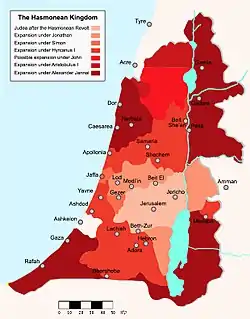
Judas was succeeded by his brother Jonathan, who skillfully played off the claimants to the Selecuid throne against each other to extract concessions.[146] The Seleucids reached an accord with Jonathan in 157 BCE[147] and later appointed him High Priest - Judea's most important office.[148] Jonathan's and his successor and brother Simon's diplomacy paid off and around 140 Judea was de facto independent.[149][fn 7]
The Seleucid's continued infighting gave Judea free reigns and from 130 it began to conquer its neighbors. Non-Jews in conquered territory were forcibly converted to Judaism, expelled or made to pay tribute.[152] The Samaritans' temple at Mount Gerizim was destroyed.[153] By 100, Judea included the entire Palestinian hinterland from the Galilee in the north to the Negev in the south.[154] From 100 to 70 the Hasmoneans conquered many poleis along the coast and in Transjordan.[155] The warfare and associated plunder made both the Hasmonean kings and Jerusalem's temple institution incredibly rich.[156]
Roman Period
In 63 BCE, a war of succession in the Hasmonean court provided the Roman general Pompey with the opportunity bring Palestine under Roman control,[157] starting a centuries-long period of Roman rule.[fn 8] He installed Hyrcanus II, one of the Hasmonean pretenders, as High Priest but denied him the title of king.[158] Most of the territory the Hasmoneans had conquered were awarded to other kingdoms, and Judea now only included Judea proper, Samaria (except for the city of Samaria which was renamed Sebaste), southern Galilee, and eastern Idumaea.[159] In 57 BCE, the Romans and Jewish loyalists stamped out an uprising organized by Hyrcanus' enemies. Hoping to quell further unrest, the Romans restructured the kingdom into five autonomous districts, each with its own religious council with centers in Jerusalem, Sepphoris, Jericho, Amathus, and Gadara.[160]
Poleis that had been occupied or even destroyed by the Hasmoneans were rebuilt and they regained their self-governing status.[161] This amounted to a rebirth for many of the Greek cities and made them Rome's trusty allies in an otherwise unruly region.[162] They expressed their gratitude by adopting new dating systems commemorating Rome's advent, renaming themselves after Roman officials, or minting coins with monograms and imprints of Roman officials.[163]
In 40 BCE, the Parthians exploited the turmoil in the Roman world and conquered Syria and Palestine.[164] The Roman senate appointed Herod I, the son of Hyrcanus' leading partisan Antipater, king and tasked him with reconquering Palestine.[165] He succeeded with the help of Roman and Jewish troops and in 37 BCE his conquest of Jerusalem was followed by a massacre of its Jewish inhabitants.[166] Like Herod himself, his troops were non-Judean Jews who resented the Judeans.[166] Thus Herod became king over a client kingdom to Rome.[166]
Herod's kingdom
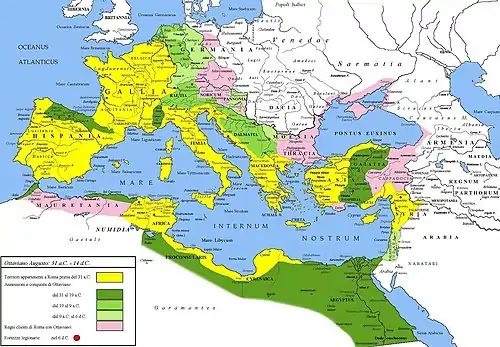
Herod I, or as he later became known, Herod the Great, ruled from 37-4 BCE. He became known for his many building projects, for increasing the region's prosperity, but also for being a tyrant and involved in many political and familial intrigues.[167]
Herod's crowning achievement was the construction of a brand new port, Caesarea, named in honour of the Roman emperor.[168] Of outstanding economic significance, it was by far Palestine's largest port and one of largest in the whole eastern Mediterranean.[169] The city was built using state-of-the-art Roman engineering complete with a market, aqueduct, government offices, baths, villas, a circus, and pagan temples.[168] He also rebuilt Jerusalem from top to bottom, greatly increasing the city's prestige.[170] The main feature of this reconstruction was a grandiose temple, one of the largest structures in the empire, with an enormous 14 hectare courtyard.[171] The temple functioned as the center of Jewish sacrificial worship, as well as a national bank, and a tourist and pilgrimage destination, drawing visitors from throughout the empire,[172] many of which passed through Caesarea, the newly built port.[173]
The Judeans saw Herod as a usurper who had stolen the throne from the Hasmoneans.[174] He also denigrated the position of High Priest, hereditary in the Hasmonean family, by selecting his own appointees.[175] Furthermore, the Judeans had always looked down on the Idumeans as racially impure. Worse, Herod's mother was an Arab and it was commonly held that one couldn't be a Jew unless born by a Jewish mother.[176] The orthodox despised him for is Greek taste, the Sadducees for how he had emasculated the Sanhedrin, and the Pharisees despised anyone who despised the Law.[176] Among his sacrileges included placing a golden eagle, a symbol of Roman power, on top of the gate to the temple.[176] However, he maintained excellent relations with his Roman overlord who rewarded him with large swathes of territory to incorporate into his kingdom.[177]
Province of Iudaea
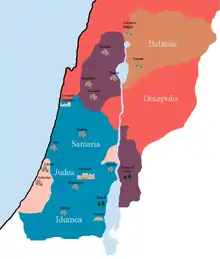
A wave of unrest swept Palestine after Herod's death in 4 BCE. It was swiftly quashed by Herod's son Archelaus with the help of the Romans.[178] Herod's kingdom was divided and given to his three sons.[179] In 6 CE Archelaus was banished for misrule and Iudaea[fn 9] came under direct Roman rule again.[180][fn 10] Caesarea replaced Jerusalem as the administrative capital of Palestine.[182]
Tensions in Iudaea grew after direct Roman rule was reestablished.[183] The upper class favored the Romans because it guaranteed their privileged position,[184] but the rural class did not and their yearning for independence and revolution grew.[185] Vivid memories of the Hasmonean kings, fueled by eschatological and messianic expectations, created dangerous delusions about the prospects of rebelling.[186] Rebels and brigands operated in the countryside and were a great nuisance to the Romans.[187] To add fuel to the fire, when Herod's grandson Agrippa I, who had been appointed king in 41 CE and had been a popular ruler, died in 44 CE, the emperor refused to let his son succeed him and Iudaea returned to unpopular direct Roman rule.[188] The discontent erupted in the Great Jewish Revolt in 66 CE that lasted for four years and culminated in the Siege of Jerusalem in 70 CE.[189][fn 11] The city was taken and the temple was destroyed.[190]
Province of Syria Palaestina
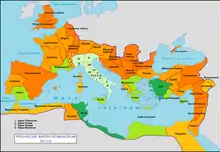
Jews again revolted against Rome in 132 CE. The causes for the revolt are unknown; one theory holds that a ban on circumcision (which the Romans saw as genital mutilation) sparked it,[191] another that the emperor's decision in 130 CE to refound Jerusalem, still in ruins after its destruction in 70 CE,[192] as a Roman colony, complete with a pagan temple, offended pious Jews enough to revolt.[193] The revolt took three years to put down, incurred massive costs on both sides,[194] and desolated much of the Judean countryside.[195] Consequently, the center of Palestinian Jewish life moved to the Galilee,[196] which had mostly stayed out of the revolt.[197] During or after the revolt the province of Iudaea was joined with the Galilee and renamed Syria Palaestina.[fn 12]
Jerusalem was re-established as the Aelia Capitolina, a greatly diminshed military colony with perhaps no more than 4,000 residents.[200] Jews were banned from the city[201] and from settling in its vicinity as punishment for the Bar Kokbha revolt.[202] Though the ban was not strictly enforced and a slow trickle of Jews settled in the city over the subsequent centuries.[203]
In the late 2nd and early 3rd century, new cities were founded at Eleutheropolis, Diospolis, and Nicopolis.[204]
In the 260s, the Palmyrene king Odaenathus helped the Romans defeat the Persians (Sasanian Empire) and became, though nominally still Rome's vassal, the real ruler of Syria Palaestina and Rome's other holdings in the Near East.[205] His widow Zenobia declared herself the Empress of the breakaway Palmyrene Empire but she was defeated by the Romans in 272.[206]
Religious developments

The first century was a time of religious revival in Jewish Palestine. Escathological beliefs, which to the Jews meant divine intervention that would free them from foreign domination and usher in a golden age of peace and prosperity, were common. Escathologists taught that people should repent in anticipation of a final judgement, preceding this golden age.[207] A number of Jewish sects were active[208] and many teachers, healers, and miracle workers gathered large followings in the countryside. One of them was the Jesus who, according to his followers, rose from the dead after he had been executed through crucifixion, thus proving that he was Messiah. His followers became known as Christians and their religion Christianity, from the Greek word "Christos," meaning Messiah. Christianity began as a Jewish sect, but as few Jews accepted Jesus as Messiah it began welcoming non-Jews too.[209] This represented a major theological shift as in those days religious Jews avoided non-Jews and allowed Christianity to become a world religion.[210]
Prior to the Great Revolt, blood sacrifice in the temple was the main form of Jewish worship; men were expected to bring sacrifice on a regular basis and people living abroad either made pilgrimage or sent sent deputies who brought animals to sacrifice in their name.[211] This gave the priesthood, who officiated in the temple, considerable economic power, political authority, and prestige. This social order, that had existed for centuries, vanished along with its institutions - the office of the High Priest and the Sanhedrin - when the temple was destroyed.[212] In its place, a new form of Judaism emerged, replacing the temple with the synagogue and sacrifice with prayer and study of Scripture.[213] Spearheading this transformation were the spiritual successors of the Pharisees, the Rabbis, one of the groups for whom the temple wasn't central.[214] They feared that traditions and religious laws that up to that point had only been passed down orally would be lost and began writing them down. This effort culminated in the Babylonian Talmud, compiled around 499 in Babylon.[215] The Babylonian Talmud (often called just "the Talmud") contains commentaries and debates on the Hebrew Bible and Halacha, the Jewish religious law. It became one of the central texts of Rabbinic Judaism, the mainstream form of Judaism since the 6th century.
Both Christians and Jews abhorred the obligatory Roman practice of making sacrifices to the Roman Gods as idolatry.[216] Jews were exempted from making such sacrifices and from 70 CE instead paid a tax known as fiscus Judaicus.[217] Christians, on the other hand, were not exempted and their unwillingness to make sacrifices led to them being persecuted.[218]
Byzantine period
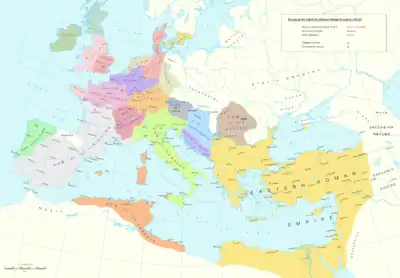
The tide turned in Christianity's favor in the 4th century. The century began with the most intense persecution of Christians the empire had seen,[219] but ended with Christianity becoming the Roman state church.[220] Perhaps more than half of the empire's population had then converted to Christianity.[221] Instrumental to this transformation was Rome's first Christian emperor Constantine the Great.[222] He had ascended the throne by defeating his competitors in series of civil wars and he credited his victories to Christianity.[223] Constantine became a fervent supporter of Christianity and issued laws conveying upon the church and its clergy fiscal and legal privileges and immunities from civic burdens.[224] He also sponsored ecumenical councils, such as the Council of Nicaea, to settle theological disputes between Christian factions.[225]
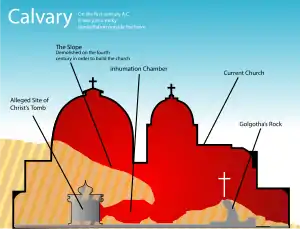
Rome's Christening had a profound impact on Palestine. Churches were built on sites venerated by Christians such as the Church of the Holy Sepulchre in Jerusalem were Jesus was thought to have been crucified and buried,[226] and the Church of the Nativity in Bethlehem where he was thought to have been born.[227] Of the over 140 Christian monasteries built in Palestine in this period,[228] some were among the oldest in the world, including Mar Saba, is still in use to this day, Saint George's Monastery in Wadi Qelt, and the Monastery of the Temptation near Jericho.[229][fn 13] Men flocked to live as pious hermits in the Judean wilderness and soon Palestine became a center for eremitic life.[230] The eucemenical council in Chalcedon in 451 elevated Jerusalem to a patriarchate and, together with Rome, Alexandria, Antioch, and Constantinpole, it became one of five self-governing centers for Christianity.[231] This elevation greatly boosted the Palestinian church's international prestige.[232]
The Byzantine era was a time of great prosperity and cultural flourishing in Palestine.[233] New areas were cultivated, urbanization increased, and many cities reached their peak populations.[234] Towns increasingly acquired new civic basilicas, porticoed streets with space for shops, and the erection of churches and other religious buildings invigorated their economies.[235] The total population of Palestine may have exceeded one and a half million, its highest ever until the twentieth century.[236]
Caesarea and Gaza became two of the most important centers of learning in the whole Mediterranean region, superseding and replacing those of Alexandria and Athens.[237] Here, Christian scholars produced notable works in the disciplines of disciplines of rhetoric, historiography, Church history, classicizing history and hagiography.[238][fn 14] Saint Jerome while working in Jerusalem set out to produce a Latin translation of the Old Testament (Hebrew Bible) directly from the Hebrew text. At that time, all translations were based on the Greek Septuagint, translated in the third century BCE, which Jerome thought was unsatisfactory. His work resulted in the Vulgate which became the Catholic Church's officially promulgated Latin version of the Bible.[239] Eusebius in his topographical work, Onomasticon: On the Place Names in Divine Scripture, attempted to correlate names and places from the biblical narratives with existing localities in Palestine.[240] These works conceptualized the western view of Palestine as a Christian Holy Land.[241]

Starting in the late 3rd century, the Roman provincial administration underwent a series of reforms subdividing the provinces into smaller administrative units. The intent was to circumscribe the ability of provincial governors with strong garrisons to stage revolts against the emperor and to improve efficiency by reducing the area controlled by each governor.[242] Provinces were clustered into regional groups called dioceses.[243] Syria Palaestina became part of Dioceses Orienties, a diocese grouping the near eastern provinces. In the 4th century, Palestine and neighboring regions were reorganized into the provinces Palaestina Prima, Palaestina Secunda, and Palaestina Tertia or Palaestina Salutaris (First, Second, and Third Palestine).[244] Palaestina Prima with its capital in Caesarea encompassed the central parts of Palestine, including the coastal plain, Judea, and Samaria. Palaestina Secunda had its capital in Scythopolis and included northern Transjordan, the lower Jezreel Valley, the Galilee, and the Golan area. Palaestina Tertia with its capital in Petra included the Negev, southern Transjordan, and parts of the Sinai.[245] The three Palestines became part of the Eastern Roman Empire after the split of the Roman Empire in 395.
Jewish communities thrived along the edges of Judah, in northern Palestine, and in many poleis, including Caesarea and Scythopolis.[246] Their share of the population possibly decreased in the Byzantine era but by how much is uncertain.[247][fn 15] In 351/2, a Jewish revolt in the Galilee may have taken place.[252][fn 16] In 361, the new Emperor Julian renounced Christianity, embraced polytheism and set out to reverse Christianity's growing influence. As part of this effort, he ordered the Jewish temple in Jerusalem to be rebuilt.[254] The point was that a new temple would invalidate Jesus' prophecy about its destruction, something Christians saw as proof of Jesus' divinity.[255] However, accidents, sabotage, or an earthquake, together with the re-establishment of Christianity's dominance following the death of Julian in 363 ended the attempt to rebuild the temple.[256][fn 17] In 438, Jews may have been temporarily allowed to worship in Jerusalem.[258][fn 18]
The Christian Ghassanid Arabs were the largest Arab group in Palestine.[261] Starting in the third century, they migrated from South Arabia and settled in Palaestina Secunda and Palaestina Tertia, where they created two client kingdoms that served as the Byzantines' buffer zones.[262] The Ghassanids were a source for toops for the Byzantines and fought with them against the Persians and their allies, the Arab Lakhmids.[263]
In 106, the Romans annexed the territory of the Nabataean client kingdom into the province of Arabia Petraea, apparently without bloodshed.[264] But the Nabataeans, who controlled many important trade routes, continued to prosper.[265] The incorporation of the Nabataean kingdom began a slow process of hellenization and after the fourth century Greek replaced Aramaic for formal purposes.[266] Most Nabataeans probably converted to Christianity.[267]
In the late 5th and early 6th century, the Samaritans staged several revolts. The first occurred in 484 and required considerable force to put down.[268][fn 19] The Samaritans' synagogue on Mt. Gerizim was replaced with a church as punishment.[270] Another uprising took place in 529 when the Samaritans attacked Christians and Jews and burned estates and churches.[271] The revolt was crushed by the Byzantines aided by Christian Ghassanid Arabs, who took thousands of Samaritans as slaves.[272] A third revolt erupted in 556. This time, Jews and Samaritans joined forces against the Christians.[273] Little is known about these revolts, but the probable cause for them was the Byzantines' discrimination against non-Christians.[274] The rebellions and the authorities anti-Samaritan policies caused the Samaritians' numbers to dwindle and contributed to solidifying Christian dominance in Palestine.[275]
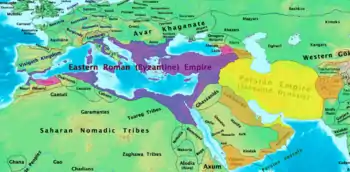
In 602, the final war between the Byzantine Empire and its eastern rival the Persian Empire (Sasanid Empire) broke out. In 613 the Persians invaded the Levant and the Jews revolted against the Byzantines, hoping to secure autonomy for Jerusalem.[276] The following year Persian-Jewish forces captured Caesarea and Jerusalem, destroying its churches, massacring its Christian population, and taking the True Cross and other relics as trophies.[277] The Jews gained dominance over Jerusalem, but the Persians found it more expedient to side with the Christians who constituted the overwhelming majority of the population and in 617 the Persians returned the city to them.[278] Meanwhile, the Roman emperor Heraclius began a successful counter-offensive. By 627/8 he was advancing into the Persian heartland. The Persians sued for peace and had to return the Roman provinces they had captured and the stolen relics. In March 629, Heraclius triumphantly returned the True Cross to Jerusalem.[279] Heraclius had promised the Jews pardon for their earlier treachery but the Christians had not forgotten the Jews' atrocities. At their insistence, Heraclius expelled the Jews from Jerusalem and had those involved in the uprising executed.[280]
Although the Romans had soundly defeated their nemesis, the continued warfare had taken its toll and paved the way for the Arabian conquest a decade later.[281]
Early Muslim period
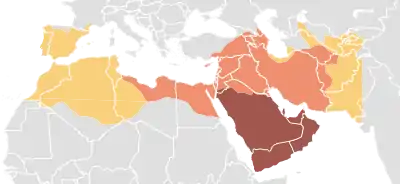
In the late 6th century, the Arab leader Muhammad founded a new monotheistic religion called Islam whose followers became known as Muslims. Muhammad united the Arabian tribes into a religious polity, a caliphate, ruled by caliphs, whose domains he and his successors extended into a vast empire through holy war (jihad).[282] They conquered Palestine in 636 to 640.[283][fn 20]
Society in the caliphate formed a pyramid with five layers.[284] Arabs were at the top, followed by converts to Islam (mawali) (this distinction disappeared after the Abbasids seized power).[284] Below them stood dhimmis, followed by non-Muslim free men and slaves at the bottom.[284] The dhimmi (meaning "protected person") were Christians, Jews, and Samaritans, who the Muslims designated as "peoples of the Book" (ahl al-kitab), meaning that they, like the Muslims, based their worship on a book God had given to them, which, in its essence, was identical to the Koran.[285] Unlike the previous rulers, the Muslims allowed them to practice their religions in peace. However, non-Muslim men had to pay a special tax (jizya) and they had to be submissive to Muslims.[286] Dress regulations were imposed on non-Muslims, but it is uncertain whether they were ever enforced in Palestine.[287][fn 21] Muslim men were permitted to marry non-Muslim women even if the latter choose to remain in their faith. Muslim women, however, could not marry non-Muslim men, unless they first converted to Islam.[288] The Muslims also lifted the Romans' centuries-long ban on Jews in Jerusalem.[289]
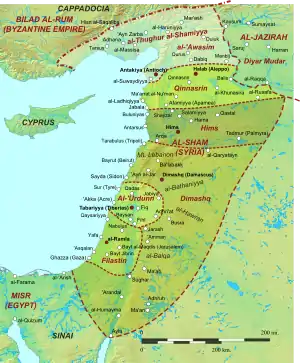
The Muslims organized the territory of the Byzantine Dioceses Orientes (Syria) into five military districts, or provinces (jund, pl. ajnads).[290][fn 22] The territory of Palaestina Prima and Palaestina Tertia became Jund Filastin and stretched from Aqaba in the south to the lower Galilee in the north and from Arish in the west to Jericho in the east.[292] The Tulunids later expanded the borders of the province eastwards and southwards to include regions in modern-day southern Jordan and north-western Saudi Arabia.[293] The newly founded city Ramla became Jund Filastin's administrative capital and most important city.[294] Jund al-Urdunn corresponded with Palaestina Secunda, covering most of the Galilee, the western part of Peraea in Transjordan, and the coastal cities Acre and Sur (Tyre).[295] Tabariyyah (Tiberias) replaced Scythopolis as the province's capital.[296]
Throughout the period, Palestine was a sort of gold mine for the caliphate and among its most prosperous and fertile provinces.[297] Palestine's wealth derived from its strategic location as a hub for international trade, the influx of pilgrims, its excellent agricultural produce, and from a number of local crafts.[298] Products manufactured or traded in Palestine included building materials from marble and white-stone quarries, spices, soaps, olive oil, sugar, indigo, Dead Sea salts, and silk.[299] Palestinian Jews were expert glassmakers whose wares became known as "Jewish glass" in Europe.[300] Palestine was also known for its book production and scribal work.[301]
The Muslims invested much effort in developing a fleet and in restoring seaports, creating shipyards, fortifying coastal cities, and in establishing naval bases in Palestine.[302] Acre became their chief naval base from which a fleet set out to conquer Cyprus in 647.[303] Jaffa came to replace Caesarea as Palestine's main port due to its proximity with Ramla.[304]
Though Palestine was now under Muslim control, the Christian world's affection for the Holy Land continued to grow. Christian kings made generous donations to Jerusalem's holy sites,[fn 23] and helped facilitate the ever increasing pilgrimage traffic.[306][fn 24] Pilgrims ventured for the adventure, but also to expiate sin.[308] Many pilgrims were attacked by highwaymen which would later be cited by the Crusaders as a reason to "liberate" Jerusalem from the Muslims.[309]
Umayyad Caliphate
In 656 the Rashidun caliph was assassinated leading to the caliphate's first civil war (fitna). The war ended in 661 with the Umayyads succeeding the Rashiduns as the caliphate's ruling dynasty.[310] They moved the caliphate's capital from Kufa to Damascus, where they enjoyed strong tribal support. The religious significance of nearby Jerusalem and the fact that in Syria, unlike in Iraq and Egypt, Arabs and non-Arabs lived together may also have played a role.[311]
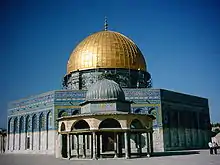
The Umayyads built two important Islamic religious buildings on the Temple Mount in Jerusalem; the Al-Aqsa Mosque (al-Masjid al-Aqsa)[312][fn 25] and the Dome of the Rock (Qubbat al-Sakhra). The latter was built on the site where Muslims believe that Mohammad began his nocturnal journey to heaven.[316] Contrary to common belief, the Dome is not a mosque and its original function and significance is uncertain.[317] One theory holds that the Dome's grand scale and lavish decoration were meant to assert Islam's supremacy by rivaling that of Jerusalem's Christian holy buildings, especially the Church of the Holy Sepulchre.[318] Another that its construction was spurred by eschatological beliefs about the Judgement Day.[317] The Dome is the oldest extant Islamic monument in the world.[319]
The centures-long feud between the Arab tribal confederations the Qays and the Yaman that began under the Umayyads came to color Palestine's history.[320][fn 26] The feud persisted until the modern era and battles were fought between Qaysi and Yamani groups as late as the nineteenth century.[323] Marriages between the two groups were unheard of.[324] The Yaman tribes came from the Yemeni region of the Arabian peninsula.[325] Many of them had migrated northwards and settled in the southern Levant before the Islamic conquest. Some had even embraced Christianity and had fought alongside the Byzantines.[326] The majority of the Qays, however, arrived after the Islamic conquest and settled in the northern Levant.[327] This led to territorial conflicts in areas with mixed populations.[328] The early caliphs would seek support from one of these groups and would consequently be opposed by the other, often resulting in warfare. The pretender standing victorious in these wars would reward their confederation with governorships in the provinces and other privileges.[329] The casualties inflicted during the wars would also have to be avenged, causing further bloodshed. Later caliphs tried to curb the feud, but it was almost impossible to stop; the best that they could do was to keep it under control by threats and themselves paying the blood-money demanded to prevent further retaliation.[330]
In 744, Palestinian tribes rebelled against the caliph.[331] The caliph choose to appease the tribes by promising them various offices and other benefits.[332] While it ended the rebellion, the tribes remained antagonistic towards the caliph.[332] One of the reasons for their antagonism was that the caliph considered their heavy-handed collection of jizya from the non-Muslims to be extortionist and he demanded more leniency.[333] Another uprising broke out in Syria in 745 after Marwan II had become the new caliph and was soon joined by the Palestinian tribes.[334][fn 27] Marwan II quelled the uprising but another erupted which required considerable bloodshed to stamp out. Marwan II destroyed the city walls of Jerusalem, Damascus, and other cities as punishment.[335]
Abbasid Caliphate
The Umayyads' conquests meant that most of the caliphate's population was non-Arab. Many of them converted to Islam, but were treated as second-class Muslims by the Arabs and still had to pay the burdensome jizya tax.[336] This led to widespread discontent and hostility towards the Umayyads. The Abbasid family exploited the discontent and organized a rebellion, overthrowing the Umayyads in 750.[337] The Abbasids, who had their power base in Persia, moved the caliphate's capital to Baghdad in 762. This change meant that Palestine lost its central position and became a province in the caliphate's periphery whose problems weren't tended to very carefully.[338] Though it did not cause a decline in the region, it ended the Umayyads' extravagant investments in Palestine.[339] The prestige of the tribes in Syria, including Palestine, many of whom had supported the Umayyads also diminished and they no longer influenced the caliphate's political affairs - only its rebellions.[340][fn 28]
Rebellions and other disturbances constantly troubled the Abbasids' rule.[342] In the 790s, the Qays-Yaman feud resulted in several wars in Palestine.[343] One of these, fought in 796 between Qaysi rebels on one side, and the Yamani and Abbasid regime on the other, required substantial force to quell.[344] Another uprising broke out in the 840s when the Yaman Al-Mubarqa roused peasants and tribesmen against the Abbasid regime.[345] These outburts of violence were very destructive and the rebels caused great havoc, looted monasteries, and devastated many cities.[346] At times, Palestine was a lawless land.[347]
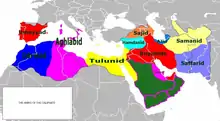
Towards the end of the 9th century, the Abbasids began to lose control of their western provinces, following a period of internal instability.[348] In 873, the governor of Egypt, Ahmad Ibn Tulun, declared independence and founded the Tulunid dynasty. A few years later, he occupied Syria.[349] The Tulunids ended the persecution of Christians and prompted the renovation of churches in Jerusalem.[350] The port of Acre was also renovated.[350] The Tulunids' rule was short-lived, however, and by 906 the Abbasids had retaken Palestine.[351] Their control lasted until 939 when they granted Muhammad ibn Tughj al-Ikhshid, the governor of Egypt and Palestine, autonomous control over his domain.[352] He established the Ikshidid dynasty whose rule was marked by acts of persecution against Christians, sometimes aided by local Jews.[353] In 937, the Church of the Resurrection was torched and robbed and in 966 severe anti-Christian riots occurred in Jerusalem.[354] Anarchy reigned after the Ikhshidid regent died in 968.[355] Many welcomed the Fatimid Caliphate's conquest of the Ikhshid state the following year.[356]
Fatimid Caliphate
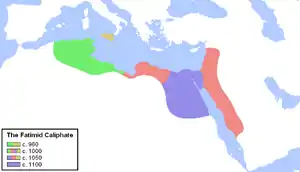
The Fatimidis established a caliphate based in North Africa in the early 10th century. In 969, they conquered the Ikshidid's territory and established precarious control over Palestine. Their arrival marked the beginning of six decades of almost uninterrupted and highly destructive warfare in Palestine between them and their many enemies, the Byzantines, the Qarmatians, Bedouin tribes, and even infighting between Berber and Turkic factions within the Fatimid army.[357] Of note are the Bedouins, led by the Jarrahids, who in 977-981/2,[358] in 1011–13,[359] and in 1024–1029,[360] gained de facto independent rule over most of Palestine, either by rebelling or by acquiring the Caliph's reluctant consent. The Bedouins also enjoyed almost unlimited power in Palestine in 997–1010.[361] The Bedouins' rule, plunder and many atrocities exacted a heavy toll on Palestine.[362]
In 1009, in a spate of religious persecution, Caliph Al-Hakim bi-Amr Allah ordered the demolition of all churches and synagogues in the empire, including the Church of the Holy Sepulchre.[363] News of the demolition shocked and enraged Christian Europe which blamed the Jews.[364] Al-Hakim also forced Christians and Jews to wear a distinctive dress.[365] His anti-Christian policies may have been intended to mollify critics of his father's liberal attitude towards dhimmi or to put pressure on the Byzantines.[366] His successor permitted the holy church to be rebuilt, but the repression against non-Muslims continued.[367]
In the 11th century, the Muslim Turkic Seljuk Empire invaded West Asia and both the Byzantines and the caliphates suffered territorial losses.[fn 29] Baghad fell in 1055,[368] and Palestine in 1071-1073.[369] Thus, the period of relative calm ended and Palestine again became the scene of anarchy, internal wars among the Turks themselves and between them and their enemies. The Turkic rule was one of slaughter, vandalism, and economic hardship.[370] In 1077, an uprising against the unpopular Seljuk rule spread in Palestine which was quashed with an iron fist. The Seljuks slaughtered the people of Jerusalem, despite having promised them pardon, and annihilated Gaza, Ramla, and Jaffa.[371] In 1098, the Fatimids recaptured Jerusalem from the Seljuks.[372]
In addition to the warring, three major earthquakes hit Palestine in the 11th century; in 1015,[373] in 1033,[374] and 1068.[375] The last one virtually demolished Ramla and killed some 15,000 inhabitants.[376]
Crusader period
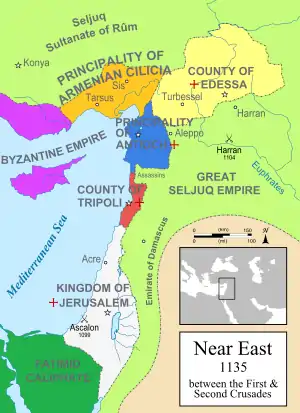
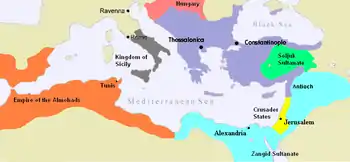
Christian Europe, though still backwards, had by the end of the 11th century become a significant power. While Palestine was a far away land, pilgrimage had nurtured a special bond between the region and the Europeans who considered it a holy land. Impediments to the pilgrimage traffic to Palestine, of which there were many in the late 11th century, were cause for serious concern. Meanwhile, a doctrine of holy war developed under which warfare to aid Christians or to defend Christianity was seen as virtuous. Additionally, relations between the Eastern and Western branches of Christianity - which had been chilly schisms - were improving. These factors meant that when the Byzantines called for help against the Muslims, the western Europeans obliged and launched the first of a number of military expeditions called crusades.[377]
The first crusade captured the entire eastern Mediterranean coast, from modern-day Turkey in the north to the Sinai in the south.[fn 30] Crusader states were organized in the captured territory, one of which was the Kingdom of Jerusalem, founded in 1100, encompassing most of Palestine and modern-day Lebanon.[377] More crusades followed as the Latins and the Muslims battled for control over Palestine.[377]
In 1187, Palestine, including Jerusalem, was captured by the Egyptian-based Ayyubid dynasty.[378][fn 31] However, the Ayyubids failed to take Tyre and the crusader states in the north.[379] This allowed the crusaders to launch another crusade that by 1192 had occupied most of the Palestinian coast down to Jaffa, but, crucially, it failed to retake Jerusalem.[380] Negotiations between the Latins and the Ayyubids resulted in a treaty, securing unfettered access to the Church of the Holy Sepulchre in Jerusalem for Christian pilgrims, but the holy city would remain in Ayyubid hands and the True Cross would not be returned.[381]
This state of affairs, with the Kingdom of Jerusalem reduced to a sliver of coastal land, would remain for most of the 13th century. Jerusalem, Bethlehem, and Nazareth, as well as a thin strip of land connecting the cities to the coast, was awarded the kingdom in 1229 following negotiations that concluded the Sixth Crusade.[382] Ten years earlier, the Ayyubids had destroyed Jerusalem's city walls to prevent the Latins from capturing a fortified city.[383] In 1244, Jerusalem was captured by Khwarizmians who went on to burn churches and to massacre the Christian population.[384] The shock of the atrocities goaded the Latins into action. The Latin nobility pooled all the resources they had together into the largest field army amassed in the East since the late 12 century.[385] Strengthened by troops from dissident Muslim rulers, they met the Ayyubid-Kwarizmian coalition at the Battle of La Forbie north-east of Gaza. There, they suffered a disastrous defeat, marking the end of Latin influence in southern and central Palestine.[386] In 1291, the Mamluks destroyed Acre, the Kingdom of Jerusalem's capital and last stronghold.[387]
The Europeans interest in crusading gradually waned over time. New ideas about what a "good Christian life" meant emerged and seeking redemption for sins through action became less central.[388] To boot, "heretical" beliefs within Europe became a major issue for Latin Christianity, taking focus away from Palestine.[389]
Military orders made up of pious knights, combining monastic discipline with martial skill, were organized in the crusader states. The duties of these were to defend strategic areas and to serve in the crusader armies. The most famous orders was the Knights Templar, named after their headquarter in the al-Aqsa mosque which they called the Temple of Solomon. The nearby Dome of the Rock was used as a church.[390] Another famous order were the Hospitallers, renowned for caring for the poor and sick. In Palestine, where crusades came and went, the orders provided stability otherwise impossible to maintain.[391]
Many customs and institutions were imported from the territories of Western Europe from which the crusaders came, and there were close familial and political connections with the West throughout the kingdom's existence. It was, however, a relatively minor kingdom in comparison and often lacked financial and military support from Europe.
The kingdom grew closer to the neighbouring Armenian Kingdom of Cilicia and the Byzantine Empire, from which it inherited "oriental" qualities, and the kingdom was also influenced by pre-existing Muslim institutions. However, when Arnulf of Chocques was appointed Latin Patriarch of Jerusalem for the second time in 1112, he prohibited non-Catholic worship at the Church of the Holy Sepulchre. Socially, the "Latin" inhabitants from Western Europe had almost no contact with the Muslims and Eastern Christians whom they ruled.
Under the Crusader rule, fortifications, castles, towers and fortified villages were built, rebuilt and renovated across Palestine largely in rural areas.[392][393] A notable urban remnant of the Crusader architecture of this era is found in Acre's old city[392][394] and on the island of Arwad.
During the period of Crusader control, it has been estimated that Palestine had only 1,000 poor Jewish families.[395] Jews fought alongside the Muslims against the Crusaders in Jerusalem in 1099 and Haifa in 1100.
Ayyubid and Mamluk periods
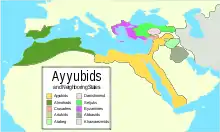
.PNG.webp)
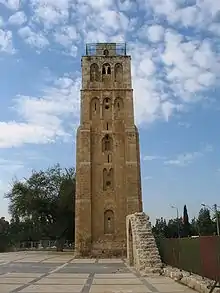
The Ayyubids allowed Jewish and Orthodox Christian settlement in the region, and the Dome of the Rock was converted back into an Islamic center of worship. The Mosque of Omar was built under Saladin outside the Church of the Holy Sepulchre, commemorating Umar the Great's decision to pray outside the church so as not to set a precedent and thereby endanger the church's status as a Christian site.
The Mamluk Sultanate was indirectly created in Egypt as a result of the Seventh Crusade, which had been launched in reaction to the 1244 destruction of Jerusalem. The crusade failed after Louis IX of France was defeated and captured by Ayyubid Sultan Turanshah at the Battle of Fariskur in 1250. Turanshah was killed by his Mamluk soldiers a month after the battle and his step-mother Shajar al-Durr became Sultana of Egypt with the Mamluk Aybak as Atabeg. The Ayyubids relocated to Damascus, where they continued to control Palestine for a further 10 years.
In the late 13th century, Palestine and Syria became the primary front against the fast-expanding Mongol Empire, whose army reached Palestine for the first time in 1260, beginning with the Mongol raids into Palestine under Nestorian Christian general Kitbuqa. Mongol leader Hulagu Khan sent a message to Louis IX of France that Jerusalem had been remitted to the Christians under the Franco-Mongol Alliance; however, shortly thereafter he had to return to Mongolia following the death of Mongke, leaving Kitbuqa and a reduced army. Kitbuqa then engaged with the Mamluks under Baibars in the pivotal Battle of Ain Jalut in the Jezreel Valley. The Mamluks' decisive victory in Palestine is seen as one of world history's most significant battles, establishing a high-water mark for the Mongol conquests. The Mongols were, however, able to engage into some further brief raids in 1300 under Ghazan and Mulay, reaching as far as Gaza. Jerusalem was held by the Mongols for four months (see Ninth Crusade).
The Mamluks, continuing the policy of the Ayyubids, made the strategic decision to destroy the coastal area and to bring desolation to many of its cities, from Tyre in the north to Gaza in the south. Ports were destroyed and various materials were dumped to make them inoperable. The goal was to prevent attacks from the sea, given the fear of the return of the crusaders. This had a long-term effect on those areas, which remained sparsely populated for centuries. The activity in that time concentrated more inland.[396]
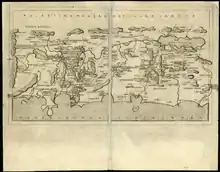
Palestine formed a part of the Damascus Wilayah (district) under the rule of the Mamluk Sultanate of Egypt and was divided into three smaller sanjaks (subdivisions) with capitals in Jerusalem, Gaza, and Safed.[397] Due in part to the many conflicts, earthquakes and the Black Death that hit the region during this era, the population is estimated to have dwindled to around 200,000. The Mamluks constructed a "postal road" from Cairo to Damascus, that included lodgings for travelers (khans) and bridges, some of which survive to this day (see Jisr Jindas, near Lod). The period also saw the construction of many schools and the renovation of mosques neglected or destroyed during the Crusader period.[398]
In 1377 the major cities of Palestine and Syria revolted, following the death of Al-Ashraf Sha'ban. The revolt was quelled and a coup d'etat was staged by Barquq in Cairo in 1382, founding the Mamluk Burji dynasty.
Palestine was celebrated by Arab and Muslim writers of the time as the "blessed land of the prophets and Islam's revered leaders";[397] Muslim sanctuaries were "rediscovered" and received many pilgrims.[398] In 1496, Mujir al-Din al-'Ulaymi wrote his history of Palestine known as The Glorious History of Jerusalem and Hebron.
Ottoman period
Early Ottoman rule
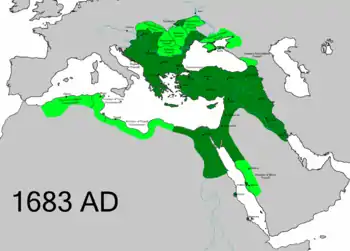
In 1486, hostilities broke out between the Mamluks and the Ottoman Turks in a battle for control over western Asia. The Ottomans proceeded to conquer Palestine following their 1516 victory over the Mamluks at the Battle of Marj Dabiq.[397][399] The Ottoman conquest of Palestine was relatively swift, with small battles fought against the Mamluks in the Jordan Valley and at Khan Yunis en route to the Mamluk capital in Egypt. There were also minor uprisings in Gaza, Ramla and Safad, which were quickly suppressed.[400]
The Ottomans maintained the administrative and political organisation that the Mamluks left in Palestine. Greater Syria became an eyalet (province) ruled from Damascus, while the Palestine region within it was divided into the five sanjaks (provincial districts, also called liwa′ in Arabic) of Safad, Nablus, Jerusalem, Lajjun and Gaza.[401][402] The sanjaks were further subdivided into subdistricts called nawahi (sing. nahiya).[400] For much of the 16th century, the Ottomans ruled Damascus Eyalet in a centralised way, with the Istanbul-based Sublime Porte (imperial government) playing a crucial role in maintaining public order and domestic security, collecting taxes, and regulating the economy, religious affairs and social welfare.[403] Most of Palestine's population, estimated to be around 200,000 in the early years of Ottoman rule, lived in villages. The largest cities were Gaza, Safad and Jerusalem, each with a population of around 5,000–6,000.[400]
Ottoman property administration consisted of a system of fiefs called timar and trusts called waqf. Timar lands were distributed by the sultan to various officers and officials, particularly from the elite sipahi units. A timar was a source of income for its holder, who was responsible for maintaining order and enforcing the law in the timar. Waqf land was owned by various individuals and its revenues were dedicated to religious functions and institutions, social welfare and individual beneficiaries. Over 60% of cultivated land in the Jerusalem Sanjak was waqf land. To a lesser extent, there was also privately owned land predominantly located within villages and their immediate vicinity.[400]
The name "Palestine" was no longer used as the official name of an administrative unit under the Ottomans because they typically named provinces after their capitals. Nonetheless, the old name remained in popular and semi-official use,[404] with many examples of its usage in the 16th, 17th and 18th centuries surviving.[405][406][407] The 16th-century Jerusalem-based Islamic jurist Sayf al-Islam Abu'l Sa'ud Effendi defined the term as an alternative name for Arazi-i Muqaddas (Turkish for "the Holy Land").[402] The 17th-century Ramla-based jurist Khayr al-Din al-Ramli often used the term "Filastin" in his fatawat (religious edicts) without defining the term, although some of his fatawat suggest that it more or less corresponded with the borders of Jund Filastin.[402] Thomas Salmon's 18th-century book, Modern history or, the present state of all nations, states that "Jerusalem is still reckoned the capital city of Palestine, though much fallen from its ancient grandeur."[408]
Ridwan-Farrukh-Turabay period
By the end of the 16th century, direct Ottoman rule over Damascus Eyalet was weakened, partly due to the Jelali revolts and other Anatolian insurrections.[403] The timar system, which functioned to serve the fiscal and military needs of the Ottoman government, was also becoming less relevant during this period.[409] Consequently, a new governing elite emerged in Palestine consisting of the Ridwan, Farrukh and Turabay dynasties whose members provided the district governors of the Gaza, Nablus, Jerusalem and Lajjun sanjaks between the late 16th century and the late 17th century. The stability of their rule varied by sanjak, with Ridwan control of Gaza, Turabay control of Lajjun, and Farrukh control of Nablus largely continuous, and the Ridwan-Farrukh hold over Jerusalem frequently interrupted by governors appointed from Istanbul.[410]
Ties between the families were solidified through inter-marriage, business and political cooperation.[411] From the late 16th century until the early 18th century, the prestigious post of amir al-hajj (commander of the Hajj caravan) would often be assigned to the district governor of Nablus or Gaza. This tradition laid the foundation for a durable military alliance between the three families since the departing amir al-hajj from one of these families would entrust authority over his sanjak to the governor of the neighboring sanjak.[412] Gradually, the ties between the Ridwan, Farrukh and Turabay families led to the establishment of a single extended dynasty that held sway over much of Palestine.[413]
In 1622, the Druze emir (prince) of Mount Lebanon, Fakhr-al-Din II gained control of Safad Sanjak and was appointed governor of Nablus and mutasallim (chief tax collector) of Gaza.[412] Alarmed at the looming threat to their rule, the Ridwan-Farrukh-Turabay alliance prepared for a confrontation with Fakhr ad-Din by pooling their financial resources to acquire arms and bribe Bedouin tribes to fight alongside them. They were also tacitly supported by the Sublime Porte, which was wary of Fakhr ad-Din's growing autonomy.[412] When Fakhr ad-Din's better-equipped army launched an offensive to gain control of Palestine's coastal plain and Jerusalem, the army of Hasan 'Arab Ridwan, Ahmad Turabay and Muhammad ibn Farrukh routed his forces at the Awja River near Jaffa.[412] In 1624, following the Battle of Anjar, Fakhr ad-Din was appointed the "Emir of Arabistan" by the Ottomans, which gave him official authority over the region between Aleppo and Jerusalem.[414] He was deposed and hanged a decade later by the Wali of Damascus
Imperial attempts at centralization
Gaza's political influence in Palestine rose under the Ridwan dynasty, particularly during the governorship of Husayn Pasha, which began in the 1640s. It was considered the "capital of Palestine" by the French consul of Jerusalem, Chevalier d'Arvieux.[415][416] Husayn's closeness with France and his good relations with Palestine's Christian communities were a source of imperial consternation at his rule.[417] Concurrently, in the mid-17th century, the Ottoman government guided by the Köprülü viziers attempted to restore centralized authority over its outlier provinces.[418] One of the centralization measures introduced by Grand Vizier Köprülü Mehmed Pasha was the establishment of the Sidon Eyalet in 1660, which administratively separated Safad Sanjak from the rest of Palestine, which remained part of Damascus Eyalet. This reorganization was done to both weaken the ambitious governors of Damascus and to maintain stricter control over the rebellious emirs of Mount Lebanon.[419]
With the elimination of Fakhr ad-Din's threat to Ottoman control in the Levant, the Sublime Porte sought to bring an end to the Ridwan-Farrukh-Turabay dynasty. Beside concern over their increasing consolidation of power in Palestine, the Sublime Porte was frustrated by the substantially decreased revenues from the annual Hajj caravan, which a governor from one of the three families often commanded.[418] In 1657, the Ottoman authorities launched a military expedition in Palestine to reassert imperial control over the region because of its strategic importance in the funding and protection of the Hajj caravan and also because it was a crucial link to Egypt.[420] The Sublime Porte used Husayn Pasha's alleged incompetence leading the Hajj caravan in 1662–63 to imprison and execute him.[421] Husayn Pasha served as the foundation of the Ridwan-Farrukh-Turabay alliance and his death was followed by the Sublime Porte's gradual elimination of the rest of the extended dynasty by the late 1670s.[422] Ridwan rule persisted in Gaza until 1690.[423]
The elimination of the Ridwan-Farrukh-Turabay dynasty and their replacement by governors appointed by the Ottoman government "radically changed the state of affairs" in Palestine, according to historian Dror Ze'evi.[424] The appointed governors abandoned the relationships that the local dynasties maintained with the local elites and largely ignored the increasing exploitation of the populace by the Janissaries, subashis and timar holders. Official complaints to the Sublime Porte about the latter groups skyrocketed among Muslims, Christians and Jews alike.[424] Many peasants abandoned their villages to avoid exploitation, townspeople complained about the seizure of their property and the ulama (Muslim scholarly class) complained about the Janissaries' disregard for justice and the sanctity of Muslim places of worship, including the Temple Mount (Haram al-Sharif).[424] In reaction to this state of affairs, in 1703, an uprising, known as the Naqib al-Ashraf Revolt, by the people of Jerusalem took place, led by the chief of the ashraf families, Muhammad ibn Mustafa al-Husayni, and backed by the city's notables. The home of Jerusalem's qadi, a symbol of imperial authority, was ransacked and his translator killed by rebels. They proceeded to govern the city themselves until an Ottoman siege and internal strife forced al-Husayni and his rebels to withdraw from Jerusalem in October 1705.[424]
Meanwhile, the mostly Arab sipahi officers of the 1657 centralization expedition, chief among them members of the Nimr clan, settled in Nablus and, contrary to the Sublime Porte's intention, began forming their own local power bases in the city's rural hinterland from the timars they were assigned.[425] Towards the end of the 17th century, they were soon followed by the Jarrar and Tuqan clans, who like the Nimrs, came from other parts of Ottoman Syria.[425] The sheikhs (chiefs) of these clans soon emerged as the new nobility of central Palestine. They developed increasingly close ties to the local population through selling or leasing their timars to rural notables, investing in local commerce, property and businesses such as soap factories, and intermarrying and partnering with local ashraf and mercantile families.[425] Politically, the Tuqans and Nimrs dominated the governorship of Nablus and at times controlled other districts and subdistricts[426] (in 1723 Salih Pasha Tuqan was governor of the Nablus, Lajjun and Gaza sanjaks).[427] The Jarrars were the dominant clan of the Nablus hinterland, although other clans, among them the Mamluk-era Jayyusis, continued to hold influence in their respective subdistricts. This state of affairs in Jabal Nablus persisted with minor interruptions until the mid-19th century.[426]
Zaydani period
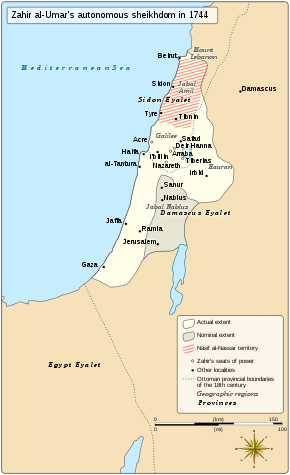
In the mid-17th century, the Zaydani clan became a formidable force in northern Palestine. Initially, its sheikhs were appointed as multazems (tax collectors and local enforcers) of iltizam (tax farms) in parts of the Galilee by the Ma'ani, and, after 1697, the Shihabi emirs of Mount Lebanon.[428] In 1730, Zaydani sheikh Zahir al-Umar was directly appointed by the Wali of Sidon as the multazem of Tiberias, which he soon fortified,[429] along with other Zaydani strongholds such as Deir Hanna, Arraba and Nazareth. Between that time and 1750, Zahir had consolidated his control over the entire Galilee.[430] He transferred his headquarters to the port village of Acre, which he renovated and refortified.[430] Acre became the center of an expanding autonomous sheikhdom financed by a monopoly on cotton and other agricultural commodities from Palestine and southern Lebanon established by Zahir.[431] Zahir's control of cotton and olive oil prices drew great revenues from European merchants, and these funds enabled him to marshal military resources needed to fend off military assaults by the governors of Damascus.[431] Moreover, the monopolies ended the foreign merchants' manipulation of prices and financial exploitation of the local peasantry.[432] Together with significantly improved general security and social justice, Zahir's economic policies made him popular with the local inhabitants.[433] Zahir also encouraged immigration to Palestine and his rule attracted large numbers of Jews and Melkite and Greek Orthodox Christians from throughout Ottoman Syria, revitalizing the region's economy.[431] Zahir founded modern-day Haifa in 1769.
In the early 1770s, Zahir allied himself with the Russian Empire and Ali Bey of Egypt. Together with Ali Bey's deputy commanders Ismail Bey and Abu al-Dhahab, and backed by the Russian Navy, Zahir and his Lebanese Shia allies invaded Damascus and Sidon. Ali Bey's commanders abruptly withdrew from Damascus after briefly capturing it in June 1771,[434] compelling Zahir to withdraw from Sidon shortly thereafter.[435] Uthman Pasha al-Kurji, the Wali of Damascus, renewed his campaign to eliminate Zahir, but his forces were routed at Lake Hula in September 1771.[436] Zahir followed up this decisive victory with another major victory against Emir Yusuf Shihab's Druze forces at Nabatieh.[437] By 1774, Zahir's rule extended from Gaza to Beirut and included most of Palestine.[438] The year after, however, a coalition of Ottoman forces besieged and killed him at his Acre headquarters.[439] The Ottoman commander Jazzar Pasha subsequently waged a campaign that destroyed Deir Hanna's fort and ended Zaydani rule in the Galilee in 1776.[440]
Although Acre and the Galilee were part of Sidon Eyalet while the rest of Palestine administratively belonged to Damascus, it was the rulers of Acre, beginning with Zahir, that dominated Palestine and the southern Syrian districts.[441] Damascus governors typically held office for short periods of time and were often occupied with protecting and leading the Hajj caravan[441] (the office of amir al-hajj had become the responsibility of the Wali of Damascus in 1708),[442] preventing them from asserting their authority over semi-autonomous areas such as the Nablus region.[441] In contrast, Zahir established Acre as a virtually autonomous entity, a process seen in other parts of the Ottoman Empire including Egypt, Mount Lebanon and Mosul.[443] Moreover, Acre became the de facto capital of Sidon Eyalet during and after Zahir's reign, and like Zahir, his successors ruled Acre until their deaths.[443] There were several military confrontations between Zahir and the Jarrar clan starting in 1735 when the former occupied the latter's territory of Nazareth and the Jezreel Valley, which served as trade and transportation hubs.[444] Meanwhile, in 1766, the Tuqan clan had ousted the Jayyusis from the Bani Sa'b subdistrict, which was then occupied by Zahir in 1771, stripping Nablus of its sea access.[445] The conflict between Zahir and the Tuqans culminated with the former's unsuccessful siege of Nablus later that year.[446]
Jazzari period
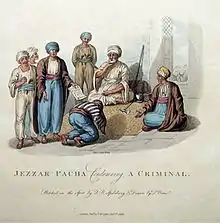
Jazzar Pasha was appointed Wali of Sidon by the Sublime Porte for his role in uprooting the Zaydani sheikhdom.[447] Unlike the Galilee-born Zahir, Jazzar was a product of the Ottoman state and a force for Ottoman centralization,[448] yet he also pursued his own agenda, extending his influence throughout the southern half of Ottoman Syria.[449] Jazzar assumed control over Zahir's cotton monopoly and further strengthened the fortifications of Acre, where he was based.[450] He financed his rule through income generated from the cotton trade, as well as taxes, tolls and extortion.[449] Tensions between Jazzar and the French cotton merchants of Acre ended with the latter being expelled in the late 1780s,[449][451] at a time when prices for Palestine's cotton were declining due to alternative sources elsewhere.[449][450] Like Zahir, Jazzar was able to maintain domestic security by suppressing the Bedouin tribes.[449] However, the local peasantry did not fare well under his stringent taxation policies, which resulted in many leaving the Galilee for neighboring areas.[449] To protect his rule, he raised a personal army of mamluks (slave soldiers) and mercenaries consisting of troops from different parts of the Islamic world.[449] Jazzar established close ties with the Tuqan clan, who were traditionally aligned with the Ottoman authorities.[446] However, the Tuqans' chief rival,[445] the Jarrar clan, resisted his attempts at centralization and Jazzar besieged them at their Sanur fortress in 1790 and 1795, both times ending in defeat.[446]
In February 1799, Emperor Napoleon of France entered Palestine after conquering Egypt as part of his campaign against the Ottomans, who were allied with his enemy, the British Empire. He occupied Gaza and moved north along Palestine's coastal plain,[452] capturing Jaffa, where his forces massacred some 3,000 Ottoman troops who had surrendered and many civilians.[453] His forces then captured Haifa and used it as a staging ground for their siege of Acre.[454] Napoleon called for Jewish support to capture Jerusalem. This was done to gain favor with Haim Farhi, Jazzar's Jewish vizier.[455] The invasion rallied the sheikhs of Jabal Nablus, with the multazem of Jenin, Sheikh Yusuf al-Jarrar, beckoning them to combat the French.[456] In contrast to the sheikhs of the Hebron Hills and Jerusalem who provided conscripts to the Ottoman Army, the sheikhs of Jabal Nablus fought independently, to the chagrin of the Sublime Porte.[457] Their men were defeated by the French in the Galilee.[458] Napoleon failed to conquer Acre and his defeat by Jazzar's forces, backed by the British, compelled him to withdraw from Palestine with heavy losses in May.[459] Jazzar's victory significantly boosted his prestige.[448] The Ottomans pursued the French in Egypt in 1800, using Gaza as their launch point.[452]
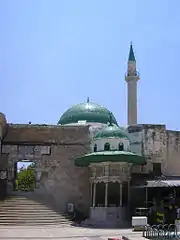
Jazzar died in 1804 and was succeeded as Wali of Sidon by his trusted mamluk Sulayman Pasha al-Adil. Sulayman, under Farhi's guidance, undertook a policy of loosening his predecessors' monopolies on the cotton, olive oil and grain trades.[460] However, he also established Acre as the only Levantine port city allowed to export these cash crops.[461] He also made significant cuts to Acre's military and adopted a decentralization policy of non-interference with his deputy governors, such as Muhammad Abu-Nabbut of Jaffa, and diplomacy with various autonomous sheikhs, such as Musa Bey Tuqan of Nablus. This marked a departure from the violent approach of Jazzar.[460] By 1810, Sulayman was appointed to Damascus Eyalet, giving him control over most of Ottoman Syria. Before he was dismissed from the latter in 1812, he managed to have the sanjaks of Latakia, Tripoli and Gaza annexed to Sidon Eyalet.[462][463] Towards the end of his rule, in 1817, a civil war broke out in Jabal Nablus between the Tuqans and a coalition of the Nimr, Jarrar, Qasim and Abd al-Hadi clans over Musa Bey's attempt to monopolize power in Nablus by ousting the Nimrs. Sulayman mediated between the clans and secured a temporary peace in 1818.[464]
Abdullah Pasha, groomed by Farhi for leadership,[465] succeeded Sulayman in 1820 nine months after the latter's death in 1819. Ottoman hesitation to appoint Abdullah was mitigated after persistent lobbying and bribery of Ottoman imperial officials by Farhi. Unlike Jazzar's mamluks who sought the governorship, Farhi did not view his protégé Abdullah to be a threat to his influence.[466] Nonetheless, Abdullah had Farhi executed less than a year into his rule as the result of a power struggle.[467] Abdullah more or less continued his predecessor's alliance with Emir Bashir Shihab II of Mount Lebanon and together they confronted the Wali of Damascus.[468] The Ottoman authorities, instigated by Farhi's relatives,[468][469] attempted to oust Abdullah in a siege against Acre, but Muhammad Ali, Wali of Egypt, persuaded the Ottomans to keep Abdullah as governor. In 1830, the Sidon Eyalet was assigned the sanjaks of Nablus, Jerusalem and Hebron, thereby bringing all of Palestine under a single province.[470] That year, the Jarrars led a revolt against Abdullah, who thereafter besieged and destroyed Sanur's fortress, which had successfully resisted sieges by his predecessors.[470] Abdullah's rule was marked by declining revenues from the cotton trade, efforts to reassert Acre's monopolies and poverty in Palestine. Nonetheless, Acre under Abdullah remained the principal force in Ottoman Syria due to instability in Damascus and the Ottomans' preoccupation with the war in Greece.[471]
Centralization
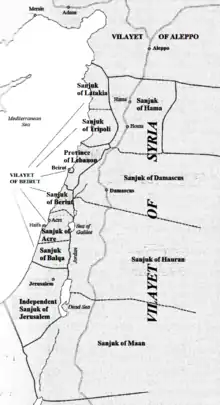
Egyptian period
In October 1831, Muhammad Ali of Egypt dispatched his modernized army commanded by his son Ibrahim Pasha in a campaign to annex Ottoman Syria, including Palestine. Ibrahim Pasha's forces had previously defeated the Ottomans and gained control of Sudan and the western Arabian Peninsula. Their entry into Palestine was not resisted by the local inhabitants,[472] nor by the rural sheikhs of the central highlands.[473] However, Abdullah Pasha resisted the conquest from Acre, which was besieged and ultimately surrendered in May 1832.[474]
Egyptian rule brought on major political and administrative reforms to Palestine and Ottoman Syria in general, and represented a radical change from the semi-autonomous rule that existed in the region prior to Muhammad Ali's conquest.[475] Among the significant measures established by Ibrahim Pasha to bring all of Syria under a single administration was the introduction of the advisory councils whose purpose was to standardize the diverse political configurations of Syria.[475] The councils, based in the major cities, were composed of religious leaders, wealthy merchants and urban leaders, and functioned as administrative centers. In effect, they solidified urban control and economic domination of the hinterland, according to historian Beshara Doumani.[476] Ibrahim Pasha also instituted the disarmament and conscription of the peasantry, a policy carried out by Muhammad Ali in Egypt to establish centralized rule and a modern army.[475]
Conscription and disarmament were highly unpopular among the peasantry and their leaders, who refused to implement the orders. New taxation policies also threatened the role of urban notables and rural sheikhs as mutasallims, while Egypt's effective law enforcement measures threatened the livelihood of Bedouin tribes who derived their income from extorting merchants and travelers. The diverse array of social and political groups hostile to Egyptian reforms throughout Palestine developed into a coalition.[477] Consequently, this coalition launched what became known as the Peasants' Revolt in 1834. The core of the rebels were based in Jabal Nablus and led by subdistrict chief Qasim al-Ahmad,[476] who had previously contributed peasant irregulars to Ibrahim Pasha's forces during the conquest of Syria.[478] The revolt represented a major threat to the flow of arms and conscripts between Egypt and Syria and to Muhammad Ali's program of modernizing Egypt.[479] Rebel forces captured most of Palestine, including Jerusalem, by June.[480] However, Muhammad Ali arrived in Palestine, opened negotiations with various rebel leaders and sympathizers, and secured a truce in July.[481] He also managed to secure the defection of the powerful Abu Ghosh clan of Jerusalem's hinterland from the rebel forces.[480]
During the truce period, numerous religious and political leaders from Jerusalem and other cities were either arrested, exiled or executed. Afterward, Qasim recommenced the rebellion, viewing the truce as a ruse.[481] Egyptian forces launched a campaign to defeat the rebels in Jabal Nablus, destroying 16 villages before capturing Nablus itself on 15 July.[482] Qasim was pursued to Hebron, which was leveled in August,[482] and was later captured and executed with most of the rebel leadership. In the wake of Egypt's victory, the virtual autonomy of Jabal Nablus was significantly weakened,[476] the conscription orders were carried out with 10,000 peasant conscripts sent to Egypt, and the population was largely disarmed.[482] The latter measure effectively introduced a monopoly of violence in Palestine, as part of Egypt's centralization policies.[482] Egyptian rule and the defeat of the powerful rural sheikhs of Jabal Nablus led to the political elevation of the Abd al-Hadi clan of Arraba. Its sheikh, Husayn Abd al-Hadi, supported Ibrahim Pasha during the revolt and was promoted as the Wali of Sidon, which included all of Palestine.[476] His relatives and allies were appointed the mutasallims of Jerusalem, Nablus and Jaffa.[483]
Britain sent the navy to shell Beirut and an Anglo-Ottoman expeditionary force landed, causing local uprisings against the Egyptian occupiers. A British naval squadron anchored off Alexandria. The Egyptian army retreated to Egypt. Muhammad Ali signed the Treaty of 1841. Britain returned control of the Levant to the Ottomans, and as a result was able to increase the extraterritorial rights that various European nations had enjoyed throughout previous centuries under the terms of the Capitulations of the Ottoman Empire. One American diplomat wrote that "Extraordinary privileges and immunities had become so embodied in successive treaties between the great Christian Powers and the Sublime Porte that for most intents and purposes many nationalities in the Ottoman Empire formed a state within the state."[484]
Restoration of Ottoman control
In common usage from 1840 onward, "Palestine" was used either to describe the consular jurisdictions of the Western powers[485] or for a region that extended in the north–south direction typically from Rafah (south-east of Gaza) to the Litani River (now in Lebanon). The western boundary was the sea, and the eastern boundary was the poorly defined place where the Syrian desert began. In various European sources, the eastern boundary was placed anywhere from the Jordan River to slightly east of Amman. The Negev Desert was not included.[486] The Consuls were originally magistrates who tried cases involving their own citizens in foreign territories. While the jurisdictions in the secular states of Europe had become territorial, the Ottomans perpetuated the legal system they inherited from the Byzantine Empire. The law in many matters was personal, not territorial, and the individual citizen carried his nation's law with him wherever he went.[487] Capitulatory law applied to foreigners in Palestine. Only Consular Courts of the State of the foreigners concerned were competent to try them. That was true, not only in cases involving personal status, but also in criminal and commercial matters.[488] According to American Ambassador Morgenthau, Turkey had never been an independent sovereignty.[489] The Western Powers had their own courts, marshals, colonies, schools, postal systems, religious institutions, and prisons. The Consuls also extended protections to large communities of Jewish protégés who had settled in Palestine.[490]
The Muslim, Christian, and Jewish communities of Palestine were allowed to exercise jurisdiction over their own members according to charters granted to them. For centuries the Jews and Christians had enjoyed a large degree of communal autonomy in matters of worship, jurisdiction over personal status, taxes, and in managing their schools and charitable institutions. In the 19th century those rights were formally recognized as part of the Tanzimat reforms and when the communities were placed under the protection of European public law.[491][492]
In the 1860s, the Ottoman military was able to restore order east of Jordan by halting tribal conflicts and Bedouin raids. This invited migration to the east, notably the Salt area, from various populations in Lebanon, Syria and Palestine to take advantage of new lands. This influx amounted to some 12,000 over the period from 1880 to just before the First World War, while the Bedouin population east of Jordan increased to 56,000.[493] However, with the creation of the Transjordanian emirate in 1921–22, the hamlet of Amman, which had been recently resettled by Circassians, attracted most of the new immigrants from Palestine, and many of those that had previously moved to Salt.[494]

In the reorganisation of 1873, which established the administrative boundaries that remained in place until 1914, Palestine was split between three major administrative units. The northern part, above a line connecting Jaffa to north Jericho and the Jordan, was assigned to the vilayet of Beirut, subdivided into the sanjaks (districts) of Acre, Beirut and Nablus.[495] The southern part, from Jaffa downwards, was part of the Mutasarrifate of Jerusalem, a special district under the direct authority of Istanbul.[496] Its southern boundaries were unclear but petered out in the eastern Sinai Peninsula and northern Negev Desert. Most of the central and southern Negev was assigned to the vilayet of Hejaz, which also included the Sinai Peninsula and the western part of Arabia.[495]
The Ottomans regarded "Filistin" as an abstract term referring to the "Holy Land", and not one consistently applied to a clearly defined area.[497] Among the educated Arab public, Filastin was a common concept, referring either to the whole of Palestine or to the Jerusalem sanjak alone[498] or just to the area around Ramle.[499] The publication of the daily paper Falastin (Palestine) from 1911 was one example of the increasing currency of this concept.[500]
The rise of Zionism, the national movement of the Jewish people started in Europe in the 19th century seeking to recreate a Jewish state in Palestine, and return the original homeland of the Jewish people. The end of the 19th century saw the beginning of Zionist immigration. The "First Aliyah" was the first modern widespread wave of aliyah. Jews who migrated to Palestine in this wave came mostly from Eastern Europe and from Yemen. This wave of aliyah began in 1881–82 and lasted until 1903,[501] bringing an estimated 25,000[502]–35,000[503] Jews to Erez Israel. The First Aliyah laid the cornerstone for Jewish settlement in Israel and created several settlements such as Rishon LeZion, Rosh Pinna, Zikhron Ya'akov and Gedera.
In 1891, a group of Jerusalem notables sent a petition to the central Ottoman government in Istanbul calling for the cessation of Jewish immigration, and land sales to Jews.[504][505]
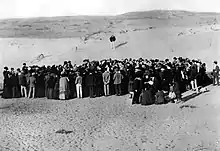
The "Second Aliyah" took place between 1904 and 1914, during which approximately 40,000 Jews immigrated, mostly from Russia and Poland,[506] and some from Yemen. The Second Aliyah immigrants were both primarily idealists, inspired by the revolutionary ideals then sweeping the Russian Empire who sought to create a communal agricultural settlement system in Palestine. They thus founded the kibbutz movement. The first kibbutz, Degania, was founded in 1909. Tel Aviv was founded at that time, though its founders were not necessarily from the new immigrants.
The Second Aliyah is largely credited with the revival of the Hebrew language and establishing it as the standard language for Jews in Israel. Eliezer Ben-Yehuda contributed to the creation of the first modern Hebrew dictionary. Although he was an immigrant of the First Aliyah, his work mostly bore fruit during the second.
Ottoman rule over the eastern Mediterranean lasted until World War I when the Ottomans sided with the German Empire and the Central Powers. During World War I, the Ottomans were driven from much of the region by the British Empire during the dissolution of the Ottoman Empire.
British Mandate period
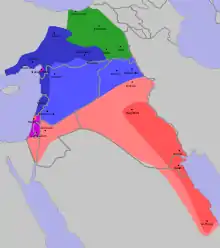
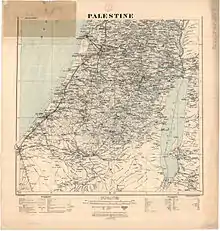
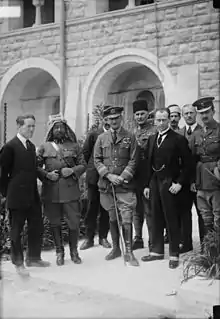
In World War I, the Ottoman Empire sided with Germany. As a result, it was embroiled in a conflict with the United Kingdom. Under the secret Sykes–Picot Agreement of 1916, it was envisioned that most of Palestine, when freed from Ottoman control, would become an international zone not under direct French or British colonial control. Shortly thereafter, British foreign minister Arthur Balfour issued the Balfour Declaration, which promised to establish a "Jewish national home" in Palestine[507] but appeared to contradict the 1915–16 Hussein-McMahon Correspondence, which contained an undertaking to form a united Arab state in exchange for the Great Arab Revolt against the Ottoman Empire in World War I. McMahon's promises could have been seen by Arab nationalists as a pledge of immediate Arab independence, an undertaking violated by the region's subsequent partition into British and French League of Nations mandates under the secret Sykes-Picot Agreement of May 1916, which became the real cornerstone of the geopolitics structuring the entire region. The Balfour Declaration, likewise, was seen by Jewish nationalists as the cornerstone of a future Jewish homeland.
The British-led Egyptian Expeditionary Force, commanded by Edmund Allenby, captured Jerusalem on 9 December 1917 and occupied the whole of the Levant following the defeat of Turkish forces in Palestine at the Battle of Megiddo in September 1918 and the capitulation of Turkey on 31 October.[508][509]
Following the First World War and the occupation of the region by the British, the principal Allied and associated powers drafted the mandate, which was formally approved by the League of Nations in 1922. Great Britain administered Palestine on behalf of the League of Nations between 1920 and 1948, a period referred to as the "British Mandate". The preamble of the mandate declared:
"Whereas the Principal Allied Powers have also agreed that the Mandatory should be responsible for putting into effect the declaration originally made on November 2nd, 1917, by the Government of His Britannic Majesty, and adopted by the said Powers, in favor of the establishment in Palestine of a national home for the Jewish people, it being clearly understood that nothing should be done which might prejudice the civil and religious rights of existing non-Jewish communities in Palestine, or the rights and political status enjoyed by Jews in any other country."[510]
Not all were satisfied with the mandate. The League of Nations' objective with the mandate system was to administer the parts of the former Ottoman Empire, which the Middle East had controlled since the 16th century, "until such time as they are able to stand alone".[511] Some of the Arabs felt that Britain was violating the McMahon-Hussein Correspondence and the understanding of the Arab Revolt. Some wanted unification with Syria: in February 1919, several Muslim and Christian groups from Jaffa and Jerusalem met and adopted a platform endorsing unity with Syria and opposition to Zionism (this is sometimes called the First Palestinian National Congress). A letter was sent to Damascus authorizing Faisal to represent the Arabs of Palestine at the Paris Peace Conference. In May 1919 a Syrian National Congress was held in Damascus, and a Palestinian delegation attended its sessions.[512]
In April 1920, violent Arab disturbances against the Jews in Jerusalem occurred, which came to be known as the 1920 Palestine riots. The riots followed rising tensions in Arab-Jewish relations over the implications of Zionist immigration. The British military administration's erratic response failed to contain the rioting, which continued for four days. As a result of the events, trust among the British, Jews, and Arabs eroded. One consequence was that the Jewish community increased moves towards an autonomous infrastructure and security apparatus parallel to that of the British administration.
In April 1920, the Allied Supreme Council (the United States, Great Britain, France, Italy and Japan) met at Sanremo and formal decisions were taken on the allocation of mandate territories. The United Kingdom obtained a mandate for Palestine and France obtained a mandate for Syria. The boundaries of the mandates and the conditions under which they were to be held were not decided. The Zionist Organization's representative at Sanremo, Chaim Weizmann, subsequently reported to his colleagues in London:
There are still important details outstanding, such as the actual terms of the mandate and the question of the boundaries in Palestine. There is the delimitation of the boundary between French Syria and Palestine, which will constitute the northern frontier and the eastern line of demarcation, adjoining Arab Syria. The latter is not likely to be fixed until the Emir Feisal attends the Peace Conference, probably in Paris.[513]
.jpg.webp)
In July 1920, the French drove Faisal bin Husayn from Damascus, ending his already negligible control over the region of Transjordan, where local chiefs traditionally resisted any central authority. The sheikhs, who had earlier pledged their loyalty to the Sharif of Mecca, asked the British to undertake the region's administration. Herbert Samuel asked for the extension of the Palestine government's authority to Transjordan, but at meetings in Cairo and Jerusalem between Winston Churchill and Emir Abdullah in March 1921 it was agreed that Abdullah would administer the territory (initially for six months only) on behalf of the Palestine administration. In the summer of 1921 Transjordan was included within the Mandate, but excluded from the provisions for a Jewish National Home.[514] On 24 July 1922, the League of Nations approved the terms of the British Mandate over Palestine and Transjordan. On 16 September the League formally approved a memorandum from Lord Balfour confirming the exemption of Transjordan from the clauses of the mandate concerning the creation of a Jewish national home and Jewish settlement.[515] With Transjordan coming under the administration of the British Mandate, the mandate's collective territory became constituted of 23% Palestine and 77% Transjordan. The mandate for Palestine, while specifying actions in support of Jewish immigration and political status, stated, in Article 25, that in the territory to the east of the Jordan River, Britain could 'postpone or withhold' those articles of the Mandate concerning a Jewish National Home. Transjordan was a very sparsely populated region (especially in comparison with Palestine proper) due to its relatively limited resources and largely desert environment.[516][517]
.png.webp)
In 1923, an agreement between the United Kingdom and France confirmed the border between the British Mandate of Palestine and the French Mandate of Syria. The British handed over the southern Golan Heights to the French in return for the northern Jordan Valley. The border was re-drawn so that both sides of the Jordan River and the whole of the Sea of Galilee, including a 10-metre-wide strip along the northeastern shore, were made a part of Palestine,[518] with the provisions that Syria have fishing and navigation rights in the lake.[519]
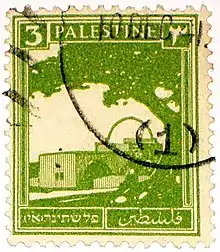
The first reference to the Palestinians, without qualifying them as Arabs, is to be found in a document of the Permanent Executive Committee, composed of Muslims and Christians, presenting a series of formal complaints to the British authorities on 26 July 1928.[520]
Infrastructure and economic development
Between 1922 and 1947, the annual growth rate of the Jewish sector of the economy was 13.2%, mainly due to immigration and foreign capital, while that of the Arab was 6.5%. Per capita, these figures were 4.8% and 3.6% respectively. By 1936, the Jewish sector had eclipsed the Arab one, and Jewish individuals earned 2.6 times as much as Arabs. In terms of human capital, there was a huge difference. For instance, the literacy rates in 1932 were 86% for the Jews against 22% for the Arabs, although Arab literacy was steadily increasing.[521]
During the Mandate period, many factories were established and roads and railroads were built throughout the country. The Jordan River was harnessed for production of electric power and the Dead Sea was tapped for minerals—potash and bromine.
Palestine developed economically during World War II, with increased industrial and agricultural outputs and the period was considered an "economic Boom". In terms of Arab-Jewish relations, these were relatively quiet times.[522]
Political organization
The most important Palestinian leader in Mandatory Palestine was Haj Amin al-Husayni. He was appointed "Grand Mufti of Palestine" by the British and used his position to lead the Palestinians' unsuccessful struggle for independence. He fled Palestine in 1937 to avoid being arrested for leading the Great Revolt but would still lead the Palestinians in his exile.[523]
In 1921, the British created the institution the Muslim Higher Council to provide religious leadership. They proceeded to recognize it as representing the Arabs of Palestine, in spite of the existing nationalist Executive Arab Committee that already sought that role.[524] The council's duties included administration of religious endowments and appointment of religious judges and local muftis. Haj Amin was chosen to head the institution and members of his family were given precedence on the council.[525] The rival family, the Nashashibis, were directed towards municipal positions.[525] This was in line with the British strategy to nurture rivalries among the Palestinian elite.[526] They succeeded and the schism created would hamper the growth of modern forms of national organization for decades to come.[525]
Al-Istiqlal, the Arab Independence Party, was established officially in 1932 but existed unofficially as early as 1930.[527] The Arab Higher Committee (al-Lajna al-'Arabiyya al-'Ulya), consisting of members of the Husaynis and Nashashibis, was established shortly after the outbreak of the Great Revolt in 1936.[528]
Demographics and Jewish immigration
Against the wishes of the Palestinians, the British facilitated Zionist settlement of Palestine by upholding liberal immigration policies and allowing Jewish mass immigration. The immigration caused a major demographic shift and alarmed the Arabs. In the census conducted in 1922 the population of Palestine was 763,550 of which 89 percent were Arabs and 11 percent Jews. By the end of 1947 the Jewish share of the population had risen to 31 percent.[529]
In 1933, Adolf Hitler came to power in Germany, and the Haavara agreement between the Zionist Federation and the Third Reich was to facilitate the emigration of German Jews. Jewish immigration dramatically increased during the mid-1930s. In 1935, 62,000 Jews entered Palestine, the highest number since the mandate began in 1920.[530]
Starting in 1939 and throughout World War II, Britain reduced the number of Jewish immigrants allowed into Palestine, following the publication of the White Paper of 1939. Once the 15,000 annual quota was exceeded, Jews fleeing Nazi persecution were placed in detention camps or deported to places such as Mauritius.[531]
The Anglo-American Committee of Inquiry's findings published in 1946 divested the White Paper and caused Britain to ease restrictions on Jewish immigration to Palestine.[532]
1936–1939 Revolt
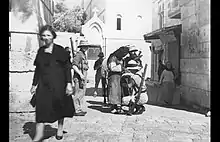
The revolt of 1936-1936, also known as the Great Palestinian Revolt, is one of the formative events of Palestinian nationalism.[533] Driven by resentment with British rule and with the Zionist settlement of Palestine, the revolt began as a general strike but evolved into an armed insurrection.[533] Diplomatic efforts led the British to recommend dividing Palestine into a Jewish and an Arab state, which the Arab side rejected. At the peak of the revolt some 10,000 Palestinian rebels took part in the fighting. Violence eventually petered out as the British suppressed the revolt and Palestinian factions turned against each other.
Attacks were mainly directed at British installations such as the Trans Arabian Pipeline and railways, and to a lesser extent against Jewish settlements, secluded Jewish neighbourhoods in the mixed cities, and Jews, both individually and in groups.
The British response to the revolt was harsh and it expanded its military force in Palestine, deploying over 100,000 troops.[534] Imprisonment without charges or trial, curfews, whip lashings,[535] house demolitions,[536] and collective punishment against villages and families were some of the practices it employed to quell the revolt. An estimated 10 percent of the adult Palestinian male population were killed, wounded, deported, or imprisoned[534] More than 120 Palestinians were sentenced to death of which 40 were hanged.
The revolt was a disaster for the Palestinians[537] and it failed to achieve its two goals; the uprooting of the Zionist settlement and the termination of the British Mandate.[538] Due to the British crackdown, the Palestinians were left without a local leadership, as most of their leaders either fled the country or were deported by the authorities.[539][540] Infighting between rival families deepened rifts in Palestinian society causing irreparable damage,[539] all while the Zionists mobilized and British-Zionist cooperation increased.[537] Those rifts would contribute to the Palestinians' unpreparedness for the 1948 war.
Another outcome of the revolt was the partial disengagement of the Jewish and Arab economies, which were more or less intertwined until that time. For example, whereas the Jewish city of Tel Aviv previously relied on the nearby Arab seaport of Jaffa, hostilities dictated the construction of a separate Jewish-run seaport for Tel Aviv.
The revolt is generally credited with forcing the issuance of the White Paper, which stated that Britain had created the Jewish national home in Palestine and announced a 10-year timetable for an independent Palestine.
General strike
In November 1935 the guerilla leader Sheikh Izz ad-Din al-Qassam was killed in a shootout with British police in the hills near Jenin.[541] Thousands attended his funeral which turned into demonstrations. His death became a rallying call for others.[542]
Al-Istiqlal called a general strike in April 1936 and the Palestinian leadership gave its blessing.[543] The strike ended after a few months when Arab leaders instructed the Palestinians to desist in exchange for negotiations with the British on the future of Palestine.[544] Meanwhile, volunteers led by Fawzi al-Qawiqji entered the country and engaged in unsuccessful guerilla warfare. The British destroyed much of al-Qawiqji's forces and by mid-October it left the country.[544]
Peel Commission
The revolt abated for about a year, while the British Royal Palestine Commission, known as the Peel Commission after its chairman Lord Peel, deliberated. In 1937 it recommended dividing Palestine into a Jewish and an Arab state.[545] The Jews would receive Tel Aviv, the coastal plain, the northern valleys, and parts of the Galile, while the Arabs would receive the west bank of the river Jordan, central Palestine and the southern desert. Britain would retain Jerusalem and a narrow corridor linking it to the sea.[546] Importantly, the commission envisaged a population exchange similar to the exchanges between Turkey and Greece in the 1920s; thousands of Arabs who had their homes within the territory of the Jewish state would be forcibly removed.[547]
The Zionist leadership supported partition in principle, but expressed reservations about the commission's findings and some opponents thought that the territory allotted to the Jewish state was too small.[548] Ben-Gurion saw it as the first step in a plan to gradually claim the entire country on both sides of Jordan.[549] He was especially pleased with the commission's recommendation of forced population transfer; a "really Jewish" state is about to become reality, he wrote in his diary.[550]
The Palestinians led by the mufti opposed dividing Palestine, but a minority, led by the Nashashibis, supported it.[551][545] This led to animosity between Husaynis' and Nashashibis' supporters as the former accused the latter of treason.[552]
Escalation and disintegration
The revolt escalated in the latter half of 1937 and numerous rebel bands emerged.[553] The rebels not only attacked British and Jewish targets, but also Palestinians who were accused of collaborating with the enemy.[554] At the same time, the British enacted oppressive emergency regulations causing strife for the civilians.[555] Popular support for the rebels declined.[556]
The revolt waned in the fall 1938 as the British organized the rebels' opponents in armed groups called "peace bands," headed by Fakhri al-Nashashibi and Fakhri 'Abd al-Hadi, previously Qawiqji's deputy.[555] Aided by these, the British effectively exposed the rebels' hiding places and by late 1939 all rebel activity had ceased.[557]
Zionist mobilization
The Haganah (Hebrew for "defense"), a Jewish paramilitary organization, actively supported British efforts to quell the revolt. Although the British administration did not officially recognize the Haganah, the British security forces cooperated with it by forming the Jewish Settlement Police and Special Night Squads.[558] A splinter group of the Haganah, called the Irgun (or Etzel)[559] adopted a policy of violent retaliation against Arabs for attacks on Jews;[560] the Hagana has adopted a policy of restraint. In a meeting in Alexandria in July 1937 between Irgun founder Ze’ev Jabotinsky, commander Col. Robert Bitker and chief-of-staff Moshe Rosenberg, the need for indiscriminate retaliation due to the difficulty of limiting operations to only the "guilty" was explained. The Irgun launched attacks against public gathering places such as markets and cafes.[561]

World War II
When the Second World War broke out, the Jewish population sided with Britain. David Ben-Gurion, head of the Jewish Agency, defined the policy with what became a famous motto: "We will fight the war as if there were no White Paper, and we will fight the White Paper as if there were no war." While this represented the Jewish population as a whole, there were exceptions (see below).
As in most of the Arab world, there was no unanimity among the Palestinian Arabs as to their position regarding the combatants in World War II. A number of leaders and public figures saw an Axis victory as the likely outcome and a way of securing Palestine back from the Zionists and the British. Mohammad Amin al-Husayni, Grand Mufti of Jerusalem, spent the rest of the war in Nazi Germany and the occupied areas. About 6,000 Palestinian Arabs and 30,000 Palestinian Jews joined the British forces.
On 10 June 1940, Italy declared war on the British Commonwealth and sided with Germany. Within a month, the Italians attacked Palestine from the air, bombing Tel Aviv and Haifa.[562]
In 1942, there was a period of anxiety for the Yishuv, when the forces of German General Erwin Rommel advanced east in North Africa towards the Suez Canal and there was fear that they would conquer Palestine. This event was the direct cause for the founding, with British support, of the Palmach[563]—a highly trained regular unit belonging to Haganah (which was mostly made up of reserve troops).
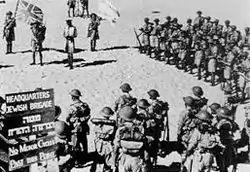
On 3 July 1944, the British government consented to the establishment of a Jewish Brigade with hand-picked Jewish and also non-Jewish senior officers. The brigade fought in Europe, most notably against the Germans in Italy from March 1945 until the end of the war in May 1945. Members of the Brigade played a key role in the Berihah's efforts to help Jews escape Europe for Palestine. Later, veterans of the Jewish Brigade became key participants of the new State of Israel's Israel Defense Forces.
In 1944 Menachem Begin assumed the Irgun's leadership, determined to force the British government to remove its troops entirely from Palestine. Citing that the British had reneged on their original promise of the Balfour Declaration, and that the White Paper of 1939 restricting Jewish immigration was an escalation of their pro-Arab policy, he decided to break with the Haganah. Soon after he assumed command, a formal 'Declaration of Revolt' was publicized, and armed attacks against British forces were initiated. Lehi, another splinter group, opposed cessation of operations against the British authorities all along. The Jewish Agency, which opposed those actions and the challenge to its role as government in preparation responded with "The Hunting Season"—severe actions against supporters of the Irgun and Lehi, including turning them over to the British”.
End of the British Mandate 1945–1948
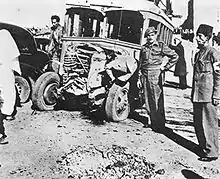
In the years following World War II, Britain's control over Palestine became increasingly tenuous. This was caused by a combination of factors, including:
- The costs of maintaining an army of over 100,000 men in Palestine weighed heavily on a British economy suffering from post-war depression, and was another cause for British public opinion to demand an end to the Mandate.[565]
- Rapid deterioration due to the actions of the Jewish paramilitary organizations (Hagana, Irgun and Lehi), involving attacks on strategic installations (by all three) as well as on British forces and officials (by the Irgun and Lehi). This caused severe damage to British morale and prestige, as well as increasing opposition to the mandate in Britain itself, public opinion demanding to "bring the boys home".
- The U.S. Congress was delaying a loan necessary to prevent British bankruptcy. The delays were in response to the British refusal to fulfill a promise given to Truman that 100,000 Holocaust survivors would be allowed to emigrate to Palestine.
In early 1947 the British Government announced their desire to terminate the Mandate, and asked the United Nations General Assembly to make recommendations regarding the future of the country.[566] The British Administration declined to accept the responsibility for implementing any solution that wasn't acceptable to both the Jewish and the Arab communities, or to allow other authorities to take over responsibility for public security prior to the termination of its mandate on 15 May 1948.[567]
UN partition and the 1948 Palestine War
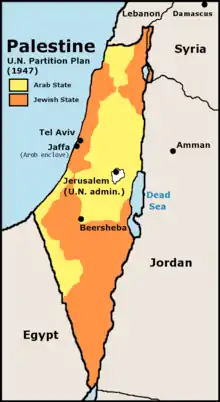
On 29 November 1947, the United Nations General Assembly, voting 33 to 13 in favour with 10 abstentions, adopted Resolution 181 (II) (though not legally binding)[568] recommending a partition with the Economic Union of Mandatory Palestine to follow the termination of the British Mandate. The plan was to partition Palestine into an "Independent Arab state alongside a Jewish States, and the Special International Regime for the City of Jerusalem".[569] Jerusalem was to encompass Bethlehem. Zionist leaders (including the Jewish Agency), accepted the plan, while Palestinian Arab leaders rejected it and all independent Muslim and Arab states voted against it.[570][571][572] Almost immediately, sectarian violence erupted and spread, killing hundreds of Arabs, Jews and British over the ensuing months.
The UN resolution was the catalyst for a full scale civil war. For four months, under continuous Arab provocation and attack, the Yishuv was usually on the defensive while occasionally retaliating.[573] Arab volunteers of the Arab Liberation Army entered Palestine to fight alongside the Palestinians, but the April–May offensive of Yishuv forces defeated the Arab forces and Arab Palestinian society collapsed. By the time the armistice was signed, some 700,000 Palestinians caught up in the turmoil fled or were driven from their homes.
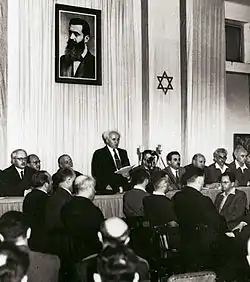
On 14 May 1948, David Ben-Gurion and the Jewish People's Council declared the establishment of a Jewish state in Eretz Israel (The Land of Israel), to be known as the State of Israel.[574] The neighbouring Arab states intervened to prevent the partition and support the Palestinian Arab population. While Transjordan and Egypt took control of territory designated for the future Arab State, Syrian and Iraqi expeditionary forces attacked Israel without success. The most intensive battles were waged between the Jordanian and Israeli forces over the control of Jerusalem.
On June 11, a truce was accepted by all parties. Israel used the lull to undertake a large-scale reinforcement of its army. In a series of military operations, during the war it conquered the whole of the Galilee region, both the Lydda and Ramle areas, and the Negev. It also managed to secure, in the Battles of Latrun, a road linking Jerusalem to Israel. However, the neighboring Arab countries signed the 1949 Armistice Agreements that ended the war, and have recognized de facto the new borders of Israel. In this phase, 350,000 more Arab Palestinians fled or were expelled from the conquered areas.
Partition of former Mandatory territory
The Arabs rejected the Partition Plan while the Jews ostensibly accepted it.[575][576][577] Following the 1948 Arab–Israeli War, the area allocated to the Palestinian Arabs and the international zone of Jerusalem were occupied by Israel and the neighboring Arab states in accordance with the terms of the 1949 Armistice Agreements. In addition to the UN-partitioned area allotted to the Jewish state, Israel captured and incorporated a further 26% of the British Mandate territory. Jordan retained possession of about 21% of the former Mandate territory. Jerusalem was divided, with Jordan taking the eastern parts, including the Old City, and Israel taking the western parts. In addition, Syria held on to small slivers of the former Mandate territory to the south and east of the Sea of Galilee, which had been allocated in the UN partition plan to the Jewish state. For a description of the massive population movements, Arab and Jewish, at the time of the 1948 war and over the following decades, see Palestinian exodus and Jewish exodus from Arab lands.
Palestinian governorship in Egyptian-controlled Gaza
On the same day that the State of Israel was announced, the Arab League announced that it would set up a single Arab civil administration throughout Palestine.[578][579]
The All-Palestine Government was established by the Arab League on 22 September 1948, during the 1948 Arab–Israeli War. It was soon recognized by all Arab League members, except Jordan. Though jurisdiction of the Government was declared to cover the whole of the former Mandatory Palestine, its effective jurisdiction was limited to the Gaza Strip.[580] The Prime Minister of the Gaza-seated administration was named Ahmed Hilmi Pasha, and the President was named Hajj Amin al-Husseini,[581] former chairman of the Arab Higher Committee.
The All-Palestine Government is regarded by some as the first attempt to establish an independent Palestinian state. It was under official Egyptian protection,[580] but, on the other hand, it had no executive role, but rather mostly political and symbolic.[580] Its importance gradually declined, especially due to relocation of seat of government from Gaza to Cairo following Israeli incursions in late 1948. Though Gaza Strip returned under Egyptian control later on through the war, the All-Palestine Government remained in-exile in Cairo, managing Gazan affairs from outside.
In 1959, the All-Palestine Government was officially merged into the United Arab Republic, coming under formal Egyptian military administration, with the appointment of Egyptian military administrators in Gaza. Egypt, however, both formally and informally denounced any and all territorial claims to Palestinian territory, in contrast to the government of Transjordan, which declared its annexation of the Palestinian West Bank. The All-Palestine Government's credentials as a bona fide sovereign state were questioned by many, particularly due to the effective reliance upon not only Egyptian military support, but Egyptian political and economic power.
Annexation of the West Bank of Jordan
Shortly after the proclamation of All-Palestine Government in Gaza, the Jericho Conference named King Abdullah I of Transjordan, "King of Arab Palestine".[582] The Congress called for the union of Arab Palestine and Transjordan and Abdullah announced his intention to annex the West Bank. The other Arab League member states opposed Abdullah's plan.
The New Historians, like Avi Shlaim, hold that there was an unwritten secret agreement between King Abdullah of Transjordan and Israeli authorities to partition the territory between themselves, and that this translated into each side limiting their objectives and exercising mutual restraint during the 1948 war.[583]
The presence of a large number of immigrants and refugees from the now dissolved Mandate of Palestine fueled the regional ambitions of King Abdullah I, who sought control over what had been the British Jerusalem and Samaria districts on the west bank of Jordan River. Towards this goal the king granted Jordanian citizenship to all Arab holders of the Palestinian Mandate identity documents in February 1949, and outlawed the terms "Palestinian" and "Transjordanian" from official usage, changing the country's name from the Emirate of Trans-Jordan to the Hashemite Kingdom of Jordan.[584] The area east of the river became known as "al-Ḍiffah al-Sharqiyyal", or "The East Bank". In April 1950, with the formal annexation of the positions held by the Jordanian Army since 1948, the area became known as "al-Ḍiffah al-Gharbiyyal" or "The Western Bank".[585] With the formal union of the East and West Banks in 1950, the number of Palestinians in the kingdom rose by another 720,000, of whom 440,000 were West Bank residents and 280,000 were refugees from other areas of the former Mandate then living on the West Bank. Palestinians became the majority in Jordan although most believed their return to what was now the state of Israel was imminent.[586]
Israel and the occupied Palestinian territories
Six-Day War and Yom Kippur War
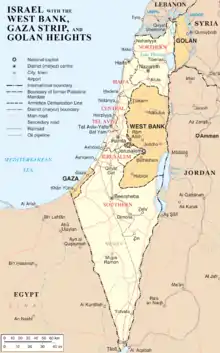
In the course of the Six-Day War in June 1967, Israel captured the rest of the area that had been part of the British Mandate of Palestine, taking the West Bank (including East Jerusalem) from Jordan and the Gaza Strip from Egypt. Following military threats by Egypt and Syria, including Egyptian president Nasser's demand of the UN to remove its peace-keeping troops from the Egyptian-Israeli border, in June 1967 Israeli forces went to action against Egypt, Syria and Jordan. As a result of that war, the Israel Defense Forces conquered the West Bank, the Gaza Strip, the Golan Heights, and the Sinai Peninsula bringing them under military rule. Israel also pushed Arab forces back from East Jerusalem, which Jews had not been permitted to visit during the prior Jordanian rule. East Jerusalem was allegedly[587] annexed by Israel as part of its capital, though this action has not been recognized internationally. Israel also started building settlements on the occupied land.[588]
The United Nations Security Council passed Resolution 242, promoting the "land for peace" formula, which called for Israeli withdrawal from territories occupied in 1967, in return for the end of all states of belligerency by the aforementioned Arab League nations. Palestinians continued longstanding demands for the destruction of Israel or made a new demand for self-determination in a separate independent Arab state in the West Bank and Gaza Strip similar to but smaller than the original Partition area that Palestinians and the Arab League had rejected for statehood in 1947.
In the course of 1973 Yom Kippur War, military forces of Egypt crossed the Suez canal and Syria to regain the Golan heights. The attacking military forces of Syria were pushed back. After a cease fire, Egyptian President Sadat Anwar Sadat started peace talks with the U.S. and Israel. Israel returned the Sinai Peninsula to Egypt as part of the 1978 Camp David Peace Accords between Egypt and Israel.
First Intifada, Oslo Accords and Palestinian Authority
From 1987 to 1993, the First Palestinian Intifada against Israel took place. Attempts at the Israeli–Palestinian peace process were made at the Madrid Conference of 1991.
Following the historic 1993 Oslo Peace Accords between Palestinians and Israel (the "Oslo Accords"), which gave the Palestinians limited self-rule in some parts of the occupied territories[589] through the Palestinian Authority, and other detailed negotiations, proposals for a Palestinian state gained momentum. They were soon followed in 1993 by the Israel–Jordan peace treaty.
Second Intifada and later
After few years of on-and-off negotiations, the Palestinians began an uprising against Israel. This was known as the Al-Aqsa Intifada. The events were highlighted in world media by Palestinian suicide bombings in Israel that killed many civilians, and by Israeli Security Forces full-fledged invasions into civilian areas[590] along with some targeted killings of Palestinian militant leaders and organizers. Israel began building a complex security barrier to block suicide bombers crossing into Israel from the West Bank in 2002.
Also in 2002, the Road map for peace calling for the resolution of the Israeli–Palestinian conflict was proposed by a "quartet": the United States, European Union, Russia, and United Nations. U.S. President George W. Bush in a speech on June 24, 2002, called for an independent Palestinian state living side by side with Israel in peace. Bush was the first U.S. president to explicitly call for such a Palestinian state.
Following Israel's unilateral disengagement plan of 2004, it withdrew all settlers and most of the military presence from the Gaza strip, but maintained control of the air space and coast. Israel also dismantled four settlements in northern West Bank in September 2005.
Gaza-West Bank split
On January 25, 2006 Palestinian legislative elections were held in order to elect the second Palestinian Legislative Council, the legislature of the Palestinian Authority (PA). Hamas won the election, securing 74 of the 132 seats while its rival Fatah only won 45 seats. The outcome of the election shocked the world and meant that Hamas would overtake most of PA's institutions.[591] Hamas tried to form a unity government with Fatah, but the offer was rebuffed. Meanwhile, Israel and the US imposed sanctions on the PA in order to destabilize the Palestinian government so that it would fail and new elections would be called. Those efforts were ultimately unsuccessful but lead to a rift between Hamas and Fatah.
In June 2006, Palestinian militants affiliated with Hamas carried out a cross-border raid from Gaza into Israel through a tunnel dug for the purpose of attacking Israel. An Israeli soldier, Gilad Shalit, was captured and taken to Gaza by the militants.[592] He would be held for five years until he was released in 2011 in exchange for over 1,000 Palestinian prisoners imprisoned by Israel.[593] The raid caused Israel to large several large-scale invasions of Gaza in the summer and autumn of 2006 attempting to rescue their captured soldier. Over 500 Palestinians and 11 Israelis were killed during the hostilities but ultimately they were unsuccessful in retrieving Shalit.[592]
Relations between Hamas and Fatah deteriorated further as Palestinian President Mahmoud Abbas attempted to dismiss the Hamas-led coalition government in June 2007. Hamas objected to this move being illegal and street battles between Hamas and Fatah members broke out in what came to be known as the 2007 Battle of Gaza. Hamas emerged victorious and took control of the Gaza Strip.[590][594]
From that point on, governance of the Palestinian territories were split between Hamas and Fatah. Hamas, branded an Islamist terror organization by the EU and several Western countries, in control of Gaza and Fatah in control of the West Bank.
As of July 2009, approximately 305,000 Israelis lived in 121 settlements in the West Bank.[595] The 2.4 million West Bank Palestinians (according to Palestinian evaluations) live primarily in four blocs centered in Hebron, Ramallah, Nablus, and Jericho.
Non-member status of State of Palestine
On 23 September 2011, President Mahmoud Abbas on behalf of the Palestine Liberation Organisation submitted an application for membership of Palestine in the United Nations. The campaign, dubbed "Palestine 194",[596] was formally backed by the Arab League in May,[597] and was officially confirmed by the PLO on 26 June.[598] The decision was labelled by the Israeli government as a unilateral step, while the Palestinian government countered that it is essential to overcoming the current impasse. Several other countries, such as Germany and Canada, have also denounced the decision and called for a prompt return to negotiations. Many others, however, such as Norway and Russia, have endorsed the plan, as has Secretary-General Ban Ki-moon, who stated, "UN members are entitled whether to vote for or against the Palestinian statehood recognition at the UN."[599]
In July 2012, it was reported that Hamas Government in Gaza was considering declaring the independence of the Gaza Strip with the help of Egypt.[600] In August 2012, Foreign Minister of the PNA Riyad al-Malki told reporters in Ramallah that PNA would renew effort to upgrade the Palestinian (PLO) status to "full member state" at the U.N. General Assembly on September 27, 2012.[601] By September 2012, with their application for full membership stalled due to the inability of Security Council members to "make a unanimous recommendation", Palestine had decided to pursue an upgrade in status from "observer entity" to "non-member observer state". On November 27, it was announced that the appeal had been officially made, and would be put to a vote in the General Assembly on November 29, where their status upgrade was expected to be supported by a majority of states. In addition to granting Palestine "non-member observer state status", the draft resolution "expresses the hope that the Security Council will consider favourably the application submitted on 23 September 2011 by the State of Palestine for admission to full membership in the United Nations, endorses the two state solution based on the pre-1967 borders, and stresses the need for an immediate resumption of negotiations between the two parties".
On November 29, 2012, in a 138–9 vote (with 41 abstaining), General Assembly resolution 67/19 passed, upgrading Palestine to "non-member observer state" status in the United Nations.[602][603] The new status equates Palestine's with that of the Holy See. The change in status was described by The Independent as "de facto recognition of the sovereign state of Palestine".[604]
The UN has permitted Palestine to title its representative office to the UN as "The Permanent Observer Mission of the State of Palestine to the United Nations",[605] and Palestine has started to re-title its name accordingly on postal stamps, official documents and passports,[603][606] whilst it has instructed its diplomats to officially represent "The State of Palestine", as opposed to the "Palestine National Authority".[603] Additionally, on 17 December 2012, UN Chief of Protocol Yeocheol Yoon decided that "the designation of 'State of Palestine' shall be used by the Secretariat in all official United Nations documents",[607] thus recognising the PLO-proclaimed State of Palestine as being sovereign over the territories Palestine and its citizens under international law.
As of February 2013, 131 (67.9%) of the 193 member states of the United Nations have recognised the State of Palestine. Many of the countries that do not recognise the State of Palestine nevertheless recognise the PLO as the 'representative of the Palestinian people'.
Graphical overview of Palestine's historical sovereign powers
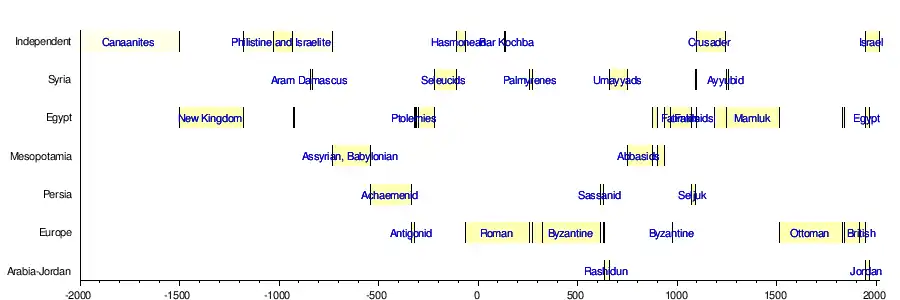
See also
Notes
- There is some debate on whether Ashurbanipal died in 631 or 627, see Lipschits 2005, p. 13 for details.
- The Samaritans are known from the Gospel of Luke's parable of the Good Samaritan which depicts the "Good" Samaritan as a hated foreigner.[99]
- See Siege of Tyre (332 BC) and Siege of Gaza for details.
- According to an ancient legend, the translation was produced by seventy sages who worked for seventy days. Hence the name Septuagint after the latin word for "seventy".[133]
- Also spelled Judah Maccabeus.
- Scholars debate whether it was Antiochus IV or Antiochus V that rescinded the edict. Schäfer 2003 claims that it was Antiochus IV himself but Magness 2012 that it was his son.
- Judea's level of independence under the Hasmoneans has been discussed at length. Schwartz writes that "the period of truly independent rule by the Hasmonean dynasty was very brief and, even then, the Jewish rulers never fully ceased being vassals of their stronger neighbors".[150] Schäfer writes that by 111 BCE, due to internal struggles for the Seleucid throne "Judaea was effectively an independent state and John Hyrcanus a sovereign ruler."[151]
- See Third Mithridatic War and Siege of Jerusalem (37 BC) for details on Pompey's conquest.
- To distinguish the Roman province "Judea" which contained the Palestinian region "Judea," "Iudaea," the original Latin name for the province is here used.
- It is not known whether Judea was a Roman province in the full sense of its meaning or only a part of the province of Syria with separate administration. Current knowledge of so-called "equestrian administration" points towards the second possibility.[181]
- Some authors such as Meyers & Chancey 2012 sets the end year for the revolt to 73 or 74 CE when the Romans captured Masada, the last rebel holdout. However, widespread fighting ceased with the fall of Jerusalem in 70 CE.
- The reason for the reorganization and renaming is not known. Many historians have asserted that the renaming was an attempt by emperor Hadrian to disassociate Jews from Judea.[198] Other historians dispute that theory.[199]
- The churches and monasteries built in the Byzantine era are too numerous to mention. Notable churches include the Church of the Ascension and the New Church of the Theotokos, both in Jerusalem, and Church of Saint George in Burqin. Notable monasteries include Saint Epiphanus' monastery near Eleutheropolis, Tyrannius Rufinus' and Saint Melania the Elder's monastery in Jerusalem, Euthymius' Laura in the Judean desert, Sait Gerasimus' monastery near Jericho, Saint Hilarion's monastery near Gaza, and Saint Theodosius' monastery near Bethlehem.
- Notable scholars of this era were: the Gazan rhetoricans and sophists Aeneas, Choricius, Procopius, and the grammarian John; the Caesarean authors and historians Procopius, Gelasius, Eusebius, and the theologican Origen; the hagiographer Cyril of Scythopolis; and the Church historian Zacharias Rhetor.[238]
- One scholar estimated that by the end of the third century, Jews constituted half of the Galilee's population and a quarter of the population in the rest of the country. As the number of Jewish settlements fell from 160 to under 50, he concluded that by 614, Jews comprised only 10-15 percent of the population based on the number of Jews who joined the Persian forces.[248] However, this and similar estimates are uncertain because it is unknown what fraction of settlements were mixed or exclusively for one religion and because claims about the sizes of fighting forces are notoriously unreliable.[249] Others have referred to literary evidence such as the Life of Barsauma or the writings of Jerome which indicates a strong Jewish (and Samaritan) presence in Palestine.[250] Goodblatt concludes: "In sum, we can demonstrate neither a decline in absolute numbers nor even a drop in percentage of the whole. What does seem clear is a different kind of change. Immigration of Christians and the conversion of pagans, Samaritans, and Jews eventually produced a Christian majority. So even if the Jews’ percentage of the total population of Palestine remained constant, their situation was different. From one of several groups of relatively equal weight, or perhaps even being the largest single group, the Jews now found themselves a distinct minority."[251]
- Due to the scant sources, the motives and extent of the uprising are unknown and it is not even certain that there was a revolt.[253]
- The reasons why the construction stopped are according to Schäfer mysterious. He offers a few possible explanations: "The Christian sources give reports of earthquakes and a fire that fell from heaven, as well as numerous miracles accompanying these happenings. The Roman historian Ammianus Marcellinus, perhaps the most reliable source, mentions “fearsome balls of flame” (metuendi globi flammarum) which repeatedly flared up “near to the foundations” of the Temple and burned some of the workers to death; the church historian Rufinus likewise mentions the fire and also speaks of an earthquake. It is often suggested that the fire was the main reason why work was halted and that the Christians must bear the blame for causing the fire as they wished to sabotage the building work. This is certainly not out of the question, but the most probable explanation is that there was an earthquake (no rare event during this period) that then caused a fire to break out. It goes without saying that the Christians attributed the events to the direct intervention of God."[257]
- According to the hagiography Life of Barsauma, the Jews of the Galilee petitioned Empress Aelia Eudocia to let them pray at the Temple Mount. Despite Basauma and his band of monks' vehement protests, she agreed. 103,000 Jews came to pray. But as they gathered on the temple platform, stones rained down from the skies and many were killed. More were crushed to death in the resulting stampede in Jerusalem's narrow streets. Though the Jews said that the monks had attacked them. Eudocia had eighteen of Barsauma's men arrested but Jerusalem was in such an uproar that she didn't dare sentencing them and instead had them released.[259] Some scholars deem this account unlikely as it is not mentioned by other sources chronicling the same place and time, and it appears contradictory to Eudocia's wider Christianization efforts.[260]
- Little is known about this uprising. Reinhard Pummer characterizes the events as two riots - one in Neapolis and one in Caesarea - rather than an uprising, but acknowledges that the majority of sources speak of it as a revolt.[269]
- See Battle of Yarmouk, Siege of Jerusalem (636–637), Battle of Dathin, and Umar's Assurance for details.
- Moshe Gil writes: "These [dress regulations] restrictions were imposed by the rulers in Palestine as well, but to the best of my knowledge there is nothing in the sources indicating their particular application in Palestine. However there is no doubt that they were theoretically imposed in Palestine. Except that here, as elsewhere in the caliphate they were not rigorously observed; which is the only explanation for the fact that they had to be renewed from time to time."[287]
- At first there were four districts, but a fifth, Jund Qinnasrin in the north was added in about 680.[291]
- For example, around the turn of the 9th century, the Frankish king Charlemagne founded a hostel, a library, and a church for pilgrims coming to Jerusalem.[305]
- For exmaple, in the Great German Pilgrimage of 1064–65 between seven and twelve thousand German pilgrims descended upon the Holy Land, by far the most important pilgrimage of its day.[307]
- According to an account from later centuries, the Caliph Umar was led to the Temple Mount reluctantly by the Christian patriarch Sophronius.[313] Umar found it covered with rubbish, but the sacred Rock was found with the help of a converted Jew, Ka'b al-Ahbar.[314] Al-Ahbar advised Umar to build a mosque to the north of the rock, so that worshippers would face both the rock and Mecca, but instead Umar chose to build it to the south of the rock.[314] The first known eyewitness testimony of the mosque the pilgrim Arculf's from about 670, recorded by Adomnán as follows: "A square prayer house which they [the Muslims] built in a crude form, placing wooden boards and broad beams on some ruins. It is said that the building can contain three thousand persons."[315]
- One of the prominent tribes in Yaman were the Quda'a.[321] The Qays were commonly known as Mudar.[322]
- For details, see Third Fitna.
- There is some debate on how the Abbasids rule affected Syria. Paul M. Cobb writes: "However unhappy some Syrians may have been, the large-scale political breakdown and socio-economic collapse of 'Abbasid Syria that modern scholarship has posited for so long has no historical basis. Indeed, in certain cases, contention - especially interelite competition like that of Syria's ashraf - can be seen as a kind of backhanded compliment to the success of the 'Abbasid state-building and an affirmation of its legitimacy. Political life in 'Abbasid Syria was certainly different from that under the Umayyads, but, all things considered, it showed little change for the worse.[341]
- For details see Battle of Manzikert.
- See Siege of Jerusalem (1099) and Battle of Ascalon for details.
- See Battle of Hattin and Siege of Jerusalem (1187) for details.
References
- van Seters, John (1997), Abraham in History and Tradition (Yale University Press)
- Parfitt, Tudor (1987) "The Jews in Palestine, 1800–1882." Royal Historical Society Studies in History (52). Woodbridge: Published for the Royal Historical Society by Boydell.
- "The settlements are illegal under international law". The Jerusalem Post. Retrieved 12 January 2015.
- Galilee, Sea of. (2007). In Encyclopædia Britannica. Retrieved August 12, 2007, from Encyclopædia Britannica Online
- "Human Evolution and Neanderthal Man" (PDF). Antiquity Journal.
- Amud. (2007). In Encyclopædia Britannica. Retrieved August 12, 2007, from Encyclopædia Britannica Online
- Olson, S. Mapping Human History. Houghton Mifflin, New York (2003). p. 74–75.
- Belfer-Cohen and Bar-Yosef, 2000, pp. 19–38.
- Stearns, 2001, p. 13.
- Harris, 1996, p. 253.
- Gates, 2003, p. 18.
- Shahin 2005, p. 4.
- Rosen, 1997, pp. 159–161.
- Neil Asher Silberman, Thomas E. Levy, Bonnie L. Wisthoff, Ron E. Tappy, John L. Meloy "Near East" The Oxford Companion to Archaeology. Brian M. Fagan, ed., Oxford University Press 1996.
- Shahin 2005, p. 4: The independent Canaanite city-states of the early Bronze age (3000-2200 BCE) were situated mostly in plains or coastal regions, surrounded by defensive walls built of mud brick and guarded by watchtowers. Most of the cities were surrounded by agricultural hamlets, which supplied their food needs.
- Mills, 1990, p. 439.
- "Palestine: Middle Bronze Age". Encyclopædia Britannica Online. Retrieved 2007-08-11.
- Ember, Melvin; Peregrine, Peter Neal, eds. (2002). "Encyclopedia of Prehistory: Volume 8: South and Southwest Asia". Encyclopedia of Prehistory. 8: South and Southwest Asia (1 ed.). New York, N.Y.; London: Kluwer Academic/Plenum. p. 103. ISBN 0-306-46262-1.
- Slavik, Diane. 2001. Cities through Time: Daily Life in Ancient and Modern Jerusalem. Geneva, Illinois: Runestone Press, p. 60. ISBN 978-0-8225-3218-7
- Mazar, Benjamin. 1975. The Mountain of the Lord. Garden City, New York: Doubleday & Company, Inc., p. 45. ISBN 0-385-04843-2
- "Remains Of Minoan-Style Painting Discovered During Excavations Of Canaanite Palace". Science Daily. December 7, 2009.
- Lily Agranat-Tamir, Shamam Waldman, Mario A.S.Martin, David Gokhman, Nadav Mishol, Tzilla Eshel, Olivia Cheronet, Nadin Rohland, Swapan Mallick, Nicole Adamski, Ann Marie Lawson, Matthew Mah, Megan Michel, Jonas Oppenheimer, Kristin Stewardson, Francesca Candilio, Denise Keating, Beatriz Gamarra, Shay Tzur, Mario Novak, Rachel Kalisher, Shlomit Bechar, Vered Eshed, Douglas J. Kennett, Marina Faerman, Naama Yahalom-Mack, Janet M. Monge, Yehuda Govrin, Yigal Erel, Benjamin Yakir, Ron Pinhasi, Shai Carmi, Israel Finkelstein, Liran Carmel, David Reich (28 May 2020). "Geographical and Historical Observations on the old North Israelite Gideon tale in Judges". Cell. 1181 (5): 1146–1157.e11. doi:10.1016/j.cell.2020.04.024. PMID 32470400. S2CID 219105441.CS1 maint: uses authors parameter (link)
- https://www.cell.com/action/showPdf?pii=S0092-8674%2820%2930487-6
- "DNA from the Bible's Canaanites lives on in modern Arabs and Jews". National Geographic. May 28, 2020. Retrieved June 1, 2020.
- "Who were the Canaanites? New insight from 73 ancient genomes". Science Daily. May 28, 2020. Retrieved June 1, 2020.
- William H. Propp "Amarna Letters" The Oxford Companion to the Bible. Bruce M. Metzger and Michael D. Coogan, eds. Oxford University Press Inc. 1993. Oxford Reference Online. Oxford University Press.
- Benjamin J. Noonan, Non-Semitic Loanwords in the Hebrew Bible: A Lexicon of Language Contact, Penn State Press, 2019ISBN 978-1-646-02039-3
- Ilan Ben Zion, ' Egyptian coffin, gold seal with king's name found in Israel,' The Times of Israel, 9 April 2014.
- Lemche 2001, 9.3: The late 13th, the 12th and the early 11th centuries B.C.E. were witnessing the foundations of scores if not hundreds of insignificant and unprotected village settlements, not least in the mountains of Palestine. Life must have become pretty safe. From at least the 11th century B.C.E., a certain reduction of the number of villages took place. This demographic chance was counterbalanced by the rise of certain settlements to the status of sometimes heavily fortified townships.
- Lemche 2001, 1,10: The texts of the Old Testament — in some circles called "the Hebrew Bible" — were believed to refer to an "ancient Israel" thought to be a historical reality. ... The biblical picture of ancient Israel does not fit in but is contrary to any image of ancient Palestinian society that can be established on the basis of ancientsources from Palestine or referring to Palestine. There is no way this image in the Bible can be reconciled with the historical past of the region.
- Austel 2003, p. 160: Until recent decades, he historicity of the United Monarchy was considered to be a “given,” at least in the general outline of its description in Samuel/Kings. Now, however, there is a great crescendo of voices insisting that David and Solomon were no more real than King Arthur. These latter voices are the voices of scholars called “minimalists,” “revisionists,” or “deconstructionists.”
- Shahin 2005, p. 6.
- Shahin 2005, p. 6: The commerce-minded Philistines introduced new ways to ferment wine, as well as tools and weapons and chariots made with iron.
- Shahin 2005, p. 6: by the time the Assyrians ruled Palestine in 722 BCE, the Philistine had become part and parcel of the local population and the "kingdom of Israel" had been destroyed.
- Jarus 2016: The Philistines disappear from written history during the 6th century B.C.
- Finkelstein & Silberman 2002, p. 106: The early Israelites appeared around 1200 BCE
- Finkelstein & Silberman 2002, p. 103: The entire population of these hill country villages at the peak of the settlement process, around 1000 BCE, could not have been much more than forty-five thousand.
- Finkelstein & Silberman 2002, p. 106: By the high point of this settlement wave in the eighth century BCE, after the establishment of the kingdoms of Judah and Israel, it encompassed over five hundred sites, with a population of about 160,000.
- Finkelstein & Silberman 2002, pp. 146-7:Put simply, while Judah was still economically marginal and backward, Israel was booming. ... In the next chapter we will see how the northern kingdom suddenly appeared on the ancient Near Eastern stage as a major regional power
- Finkelstein & Silberman 2002, p. 113: Though the early Israelites did not eat pork, the Philistines clearly did
- Faust 2009, p. 69: The Israelites’ aversion to decorated pottery goes back to the very origins of Israelite ethnicity, when the Iron Age I hill-country settlers were distinguishing themselves from their neighbors. Among the groups that bordered the hill country were the Philistines, who crafted elaborate vessels
- Faust 2009, p. 68: Patterns of behavior and material items that seem meaningful during Iron Age II include the avoidance of pork, a tradition of not decorating pottery, avoiding imported pottery, male circumcision and use of the four-room house.
- Lemche 2001, 9.4: This stage may have occurred as a consequence of an at least partial Egyptian withdrawal from Palestine ... Life became more dangerous and the socio-political system of the past (local patrons fighting other local patrons) emerged again. ... This period lasted until probably the middle of the 9th century when some of the local chieftains were able to create large political structures that exceeded the boundaries of those present in the Late Bronze Age, a time when most Palestinian political systems were extremely small.
- Finkelstein & Silberman 2002, p. 162-3: The kingdom of Israel under the Omrides stretched from the vicinity of Damascus throughout the central highlands and valleys of Israel, all the way to the southern territory of Moab, ruling over considerable populations of non-Israelites.
- Finkelstein & Silberman 2002, p. 163: In the year 853 BCE, Shalmaneser led a major Assyrian invasion force westward to intimidate and possibly conquer the smaller states of Syria, Phoenicia, and Israel. His advancing armies were confronted by an anti-Assyrian coalition near Qarqar ... Ahab was the strongest member of the anti-Assyrian coalition. ... Shalmaneser quickly returned to Assyria, and at least for a while the Assyrian march to the west was blocked.
- Finkelstein & Silberman 2002, p. 162: The events recorded in the inscription took place in the ninth century BCE ... The inscription goes on to relate how Mesha gradually expanded his territory in rebellion against Israel, destroying the main settlements of the Israelites east of the Jordan, while fortifying and embellishing his own capital.
- 2001 & Lemche, 3.5: Mesha was really the king of Moab and Moab was, before Mesha's revolt, a vassal of Israel.
- Finkelstein & Silberman 2002, pp. 182-3: Hazael's incursion into the territory formerly controlled by Israel was clearly devastating and did much to weaken the power of the northern kingdom. ... Hazael's prime target was control of the fertile and strategic borderland between the two kingdoms, and he apparently not only conquered the Aramean lands formerly taken by the Omrides but also devastated some of Israel's most fertile agricultural region
- Schneider 2011, pp. 9-10: Jehu — who bough this security to the throne by becoming an Assyrian vassal
- Finkelstein & Silberman 2002, pp. 187-8: And while Jehu, ..., the famous “black obelisk” of Shalmaneser shows him bowing low to the ground at the feet of the great Assyrian king. Shalmaneser also notes: "The tribute of Jehu, son of Omri; ..."
- Finkelstein & Silberman 2002, p. 194: This new king, Tiglathpileser III ..., began ... a thorough revamping of the Assyrian empire—primarily in its relations to its former vassals, which would now be much more directly controlled. ... In the era of Assyrian imperialism that Tiglath pileser had inaugurated, vassaldom would soon give way to conquest and annexation
- Bagg 2013, p. 122: The conquest of Palestine began in 734 B.c.e. with Tiglath-pileser III and lasted to about 645.
- Lipschits 2006, p. 19: Tiglath-pileser conquered the strongest and largest kingdoms in the region, inflicting heavy damage. He deported large parts of the populations, replacing them with exiles from remote regions, and annexed their territory to Assyria, turning them into Assyrian provinces.
- Schipper 2011, p. 270: After the fall of Samaria, the capital of the Israelite kingdom, in 720 BCE, the Assyrian expansion under Sargon II and Sennacherib was reoriented southward,
- Schipper 2011, p. 270: the Assyrian rulers gradually conquered Egypt, and, with the fall of Thebes in 664 BCE,
- Lipschits 2006, p. 20.
- Perdue & Carter 2015, p. 69: When Assurbanipal died in 627 BCE, ... struggles over succession led to a weakening of centralized power. ... Babylon revolted and went on the offensive against Assyria. ... All of the nations of Syria-Israel had become colonies of the Neo-Babylonian Empire by 601 BCE.
- Schipper 2011, p. 279: During this period – by 612 BCE at the latest – Psammetichus I created a system of vassal states in the Southern Levant in which local chiefs were required to pay taxes to the Egyptians in exchange for military protection, according to the Ekron letter.
- Finkelstein & Silberman 2002, p. 259: Egypt decided to intervene on the side of the Assyrians, and in 616 its army marched to the north. But this move did not stop the Assyrian collapse. The great Assyrian capital of Nineveh fell in 612, ..., in 610, ... the Babylonians took Haran.
- Schipper 2011, p. 282: ..., Josiah, the Judean Egyptian vassal, went to meet the new pharaoh on the latter's first march to Syria-Palestine in 609. Necho II met Josiah at the traditional Egyptian base of Meggido, killed him for unknown reasons, ... Necho II deposed him and instead enthroned the older son of Josiah, Eliakim, and gave him the name Jehoiakim.
- Finkelstein & Silberman 2002, pp. 260-1: In 605 BCE, the Babylonian crown prince later known as Nebuchadnezzar crushed the Egyptian army at Carchemish in Syria (an event recorded in Jeremiah 46:2), causing the Egyptian forces to flee
- Ben-Shlomo 2010, p. 17: In the year 604 BCE, the Philistines cities of Ashdod, Ekron, Ashkelon and Gaza were destroyed by Nebuchadnezzar
- Perdue & Carter 2015, p. 69: All of the nations of Syria-Israel had become colonies of the Neo-Babylonian Empire by 601 BCE.
- Saggs 2010: On the last occasion (601/600), Nebuchadnezzar clashed with an Egyptian army, with heavy losses; this reverse was followed by the defection of certain vassal states, Judah among them. This brought an intermission in the series of annual campaigns in 600/599, while Nebuchadnezzar remained in Babylonia repairing his losses of chariots.
- Saggs 2010: He attacked Judah a year later and captured Jerusalem on March 16, 597
- Saggs 2010: The siege of Jerusalem ended in its capture in 587/586; Finkelstein & Silberman 2002, p. 262: In 587 BCE Nebuchadnezzar arrived with his formidable army and laid siege to Jerusalem. It was the beginning of the end. With the Babylonian forces rampaging through the countryside, the outlying cities of Judah fell one by one.
- Ephal 2000, p. 142: The semi-independent kingdoms in southern Palestine (Judah and the Philistine kingdoms of Gaza, Ashkelon, Ashdod and Ekron) ... were dissolved during Nebuchadnezzar's reign and they too were incorporated into the Chaldaean provinces
- Noll 2013, p. 338: a province with its capital at Mizpah, just north of Jerusalem. ... Throughout this era, the province was called Yehud
- Saggs 2010: In this respect he followed the methods of his Assyrian predecessors.
- Lipschits 2005, p. 24: it seems that Nebuchadrezzar used the destruction of the region as a lever for rebuilding the parts of Babylonia that had been damaged during the long years of war, devastation, and deportation inflicted by the Assyrians. Large groups of exiles from the ruling, economic, and religious elite of the local kingdoms were sent to Babylon and settled in the devastated areas to develop them.
- Saggs 2010: deporting King Jehoiachin to Babylon.; Finkelstein & Silberman 2002, p. 261: The Jerusalem aristocracy and priesthood ... were taken off into exile,
- Saggs 2010: The siege of Jerusalem ended in its capture in 587/586 and in the deportation of prominent citizens, with a further deportation in 582. In this respect he followed the methods of his Assyrian predecessors.
- Lendering, Cyrus the Great: in October 539, the Persian king took Babylon and captured its king Nabonidus. ...The Babylonian Empire had been large, and Cyrus now became ruler of Syria and Palestine as well.
- Lipschits 2006, p. 26.
- Ephal 2000, p. 151: Cyrus' Edict ... indicate that Cyrus and his successors maintained a policy of repatriation for some 80 years.
- Stern 1984, p. 70.
- Meyers & Chancey 2012, p. 3: despite ... the devastating wars between Greece and Persia in the fifth century, Greek cultural influence rose steadily; Ephal 1998, p. 118
- Hübner 2014, p. 161: The earliest coins found in Palestine are of Greek origin: archaic and early classicial coinage of the late sixth and early fifth centuries BCE
- Meyers & Chancey 2012, p. 3.
- Schäfer 2003, p. 1; Hengel 1984, pp. 35–6: For a long time the western districts of the empire, especially Phoenicia, had been oriented in economic, cultural and military affairs towards Greece and the Aegean. ... No well-to-do household in Palestine would have lacked Greek pottery, terracottas and other luxury items; Greek coins and their local imitations had long been an important medium of exchange.; Schwartz 2009, p. 24: By the fifth century, Greek goods predominated over all other imports in the cities of the Syro-Palestinian coast. ... the trickle of Greek imports now turned into a flood
- Meyers & Chancey 2012, pp. 3–4: it did not take long for local potters to imitate those fine wares, though they could not duplicate the high quality of manufacture for which the Greeks were known
- Ephal 1998, p. 112.
- Ephal 2000, p. 156.
- Ephal 2000, p. 161.
- Lipschits 2006, p. 26-27.
- Lipschits 2006, p. 26: Development of maritime trade was probably the main reason
- Ephal 2000, p. 144: which he had received from the king of Persia ('the lord of Kings') as a reward for 'the important deeds which I did'
- Lipschits 2006, p. 27: We may also accept the Idea that in the early fifth century B.C.E. the Achaemenids granted Upper Galilee and the area east of Tyre to the Tyrians.
- Ephal 2000, p. 150: around the middle of the fourth century, Phoenicians were occupying the entire coast ... as far as Ascalon in southern Palestine
- Schäfer 2003, p. 2: Gaza, one of the most important Arabian trading centres
- Ephal 2000, p. 162.
- Wenning 2007, p. 26: All that can be said with certainty is that the Nabataeans are known in the sources since the fourth century B.C. Up to that time the Qedarites, the dominant Arab tribe of the Persian period, controlled the south from the Hejaz and all of the Negev
- Shahin 2005, p. 6: the Nabataenas (400 BCE-160 CE), with their capital in Petra (Jordan), made inroads into southern Palestine and built a separate and flourishing civilization in the Negev.; Wenning 2007, p. 26: Beside the establishment of Idumaea, which meant the loss of a large territory, the Qedarites obviously lost of their privileges of the frankincense trade. It can be assumed that they were replaced by the Nabataeans.; Masalha 2018, p. 153
- Ephal 1998, pp. 114–115: One or two generations before the destruction of the kingdom of Judah in 586 B.C.E., Edomites began to infiltrate into southern Palestine. ... Idumaea, south and west of the province of Judah; Magness 2012, p. 75: After 586 B.C.E., Edomites settled in the southern part of the former kingdom of Judah (the northern Negev). Their descendants were known as Idumaeans, and the area was called Idumaea.
- Ephal 1998, p. 119: Norms of behaviour, as well as social patterns, that were to characterize the Jewish people for many generations to come began to crystallize during the Persian period.
- Grabbe 2006: One developing consensus of the past couple of decades is that ancient Israel was basically a polytheistic society, though Yhwh functioned in some way as a national/ethnic god (much as Chemosh did for the Moabites and Qaus/Qos for the Edomites) for both Israel and Judah.
- Hjelm 2010, p. 26: Furthermore, the temple rested on foundations ... from a temple built no later than the mid-fifth century BCE.
- Plummer 2010, p. 4: The claim by the Samaritans to be the original Israelites.
- Lynwood Smith 2015, p. 133.
- Ephal 1998, p. 108.
- Ephal 2000, p. 145: it would appear that the Egyptians seized control of the entire coastal strip of Palestine and Phoenicia for a time.; Stern 1984, p. 75: They seized the northern part of the coastal plain of Palestine and for a brief period also held Tyre and Sidon.; Meyers & Chancey 2012, p. 7: the Egyptians rebelled ... taking control of the northern part of the coastal plain and for a short time part of the Phoenician coast including Akko and Sidon as well.
- Bowman 2020; Meyers & Chancey 2012, p. 7: subsequently the Persians ... marched to Egypt and recovered it in 343 b.c.e.
- Hübner 2014, p. 162: The so-called Philisto-Arabian coins are among the oldest in Palestine. The mints were located in Gaza, Ashkelon, and Ashdod.
- Hübner 2014, p. 165: Since the second quarter of the fourth century, coins were also minted in the province of Judah
- Tesch 2017.
- Ephal 1998, p. 116.
- Ephal 2000, pp. 147: It would seem that by this time Persian rule in Syria-Palestine was at most nominal.
- Meyers & Chancey 2012, p. 9: t is clear that Alexander met strong resistance to his armies only at Tyre and Gaza; Ephal 2000, pp. 146–7
- Schäfer 2003, p. 2: Gaza fell after two months, the able men, as in Tyre, were killed, and the women and children sold into slavery.
- Schäfer 2003, p. 8.
- Schäfer 2003, p. 8: His main opponent was Antigonus Monophthalmus
- Bevan 2014, p. 44: he extended his power over Palestine in the years 320-318.
- Schäfer 2003, p. 8; Bevan 2014, p. 44
- Bevan 2014, p. 45.
- Hengel 1984, p. 49: Contrary to previous agreements, the victors gave Coele-Syria totally to Seleucus. Ptolemy anticipated him by occupying the country speedily again. The new master of Asia did not wish to wage war against his one-time friend to whom he owed so much; yet he was unwilling to renounce his claim. The struggle for Phoenicia and Palestine was for the next 150 years a decisive factor in the policies of both kingdoms.; Schäfer 2003, p. 9
- Schäfer 2003, p. 24.
- Meyers & Chancey 2012, pp. 15–16: This seems to contrast with the experience during the Persian period, when Persian officials kept a safe distance from the local population and in no way tried to impose their language or culture.
- Magness 2012, p. 66.
- Haralson Hayes & Mandell 1998, p. 13; Grabbe 2010, p. 10: those who could gain a Greek education – and this was mainly the upper-class of the indigenous peoples – usually found that it conferred benefits.
- Shahin 2005, p. 7.
- Magness 2012, p. 67.
- Magness 2012, p. 67: By establishing poleis, the Hellenistic kings also won the loyalty of the residents, who benefited from a rise in their standard of living.
- Shahin 2005, p. 7: Trade and commerce grew, especially in the most Hellenized areas
- Schäfer 2003, p. 13; Hengel 1984, p. 52: With the exception of the fourth Syrian war (219—217) it was for most of the land a time of peace; Meyers & Chancey 2012, p. 16: Despite the high tension between the rival factions for control of Palestine, the third century may be viewed as a time of relative prosperity and quiet.
- Hengel 1984, p. 55; Schäfer 2003, p. 15: The entire land was considered a “territory won by the spear”, and thus essentially the property of the king.; Lundahl 2002, p. 204: All land was owned by the king.
- Hengel 1984, p. 55.
- Hengel 1984, p. 55; Schäfer 2003, p. 14: The state had also claimed a monopoly on the most important economic goods, such as vegetable oils, salt, linen, and beer.; Lundahl 2002, p. 204
- Adams 2014, p. 150: Well-connected individuals could bid for the opportunity to garner revenues for a particular region, but they had to offer their assets as surety in the event that they could not provide the full amount.; Lundahl 2002, p. 206; Schwartz 2009, p. 28: The Ptolemies collected taxes by auctioning tax-farming contracts district by district, often to wealthy natives; the tax farmers were then left to raise what they could. They had to pay for shortfalls out of their own pockets but could keep profits.
- Adams 2014, p. 150.
- Lundahl 2002, p. 205; Schäfer 2003, p. 18; Meyers & Chancey 2012, p. 25: the Ptolemaic domination of the local economy, which affected the class structure in Palestine in a definitive way. The rise of a new middle class was among the most significant developments.
- Hengel 1984, p. 59; Lundahl 2002, p. 204: To this end, the Ptolemies 'treated Egypt as a money-making machine.' Exactly how much they managed to extract is not known, but 'the dynasty was generally regarded as much the richest thing in the world.'; Schäfer 2003, p. 14: This complicity ... guaranteed the greatest possible exploitation of the tax-paying population
- Meyers & Chancey 2012, p. 20.
- Myles 2010, p. 343.
- Schäfer 2003, p. 28.
- Magness 2012, p. 93: the impact of Hellenization caused deep divisions among the Jewish population. Many of Jerusalem's elite families ... eagerly adopted Greek customs.
- Schäfer 2003, pp. 43–4: the “determined Jewish reformers” who saw separation from the pagans as the cause of all misfortune
- Schäfer 2003, p. 36: the Hellenizers in Jerusalem ..., with the new High Priest Jason ... proposed to the king that Jerusalem be turned into a Hellenistic polis; Magnes 2012, p. 93: Jason, ..., convinced the Seleucid king Antiochus IV Epiphanes ... to refound Jerusalem as a Greek polis named Antiochia.
- Magness 2012, p. 94.
- Magness 2012, p. 94: The Jerusalem temple was rededicated to Olympian Zeus; Schwartz 2009, p. 32: the Jerusalem temple was rededicated to Zeus Olympios-Baal Shamim
- Atkinson 2018, p. 20.
- Schwartz 2009, p. 32: Elias Bickerman famously speculated that this fact ... underlay the more drastic reforms imposed by Antiochus IV in 168–167 B.C.E., in which observance of the laws of the Torah was prohibited ... reforms inspired by Jewish leaders more radical than Jason.; Dąbrowa 2010, p. 16: There are many indications that the driving force behind the initiative came from an influential group of Judean inhabitants conventionally described as Hellenists.
- Schäfer 2003, pp. 42–3; Schwartz 2009, p. 32: Tcherikover's suggestion, that the royal persecution was a reaction to a revolt centering on the temple that had broken out the previous year
- Collins 2016: When the king heard that fighting had broken out in Jerusalem, he concluded that Judea was in revolt (2 Macc 5:11). In effect, he mistook factional fighting for a revolt, and proceeded to suppress it brutally.
- Magness 2012, p. 94; Schwartz 2009, p. 33; Gruen 2016, p. 23
- Magness 2012, pp. 94-5.
- Gruen 2016, p. 25: Jonathan was skilled at playing one off against the other, thus to obtain more concessions
- Gruen 2016, p. 24: But the commander of the royal forces reached an accord with Judah's successor Jonathan in 157, vowing never to do him harm for all the remaining days of his life
- Gruen 2016, p. 25: And Balas indeed trumped Demetrius’ offer by naming Jonathan as High Priest of the Jew
- Grabbe 2010, p. 18; Schäfer 2003, p. 58: The Maccabees had achieved their main political objective and freed Judaea de facto (though not de jure) from the Seleucid confederation.
- Schwartz 2009, p. 14.
- Schäfer 2003, p. 68.
- Schwartz 2009, p. 36; Schäfer 2003, p. 65: The inhabitants of these latter were forcibly Judaized or expelled, or else made liable for payment of a regular tribute to the Jewish state.
- Hjelm 2010, p. 28
- Grabbe 2010, p. 18; Schwartz 2009, p. 36: by 100, the Hasmoneans ruled the entirety of the Palestinian hinterland, from the high hills of Upper Galilee in the north to the edge of the Negev Desert in the south, and from the Jordan River, or even slightly beyond it, in the east to the edge of the coastal plain in the west.
- Schwartz 2009, p. 38.
- Schwartz 2009, p. 41: The Hasmonean state was enriched by its constant warfare and plunder, especially of the wealthy Greek cities of the coast and the desert fringe, under Alexander Yannai. Much of this wealth went, first, into the pockets of the kings, second, into the temple treasury, and, third, to the priests
- Magness 2012, p. 96; Schwartz 2009, p. 43; Schäfer 2003, p. 78
- Schwartz 2009, p. 43: He then named Hyrcanus high priest (but not king; Sartre 2005, p. 41: Hyrcanos II was confirmed as high priest but denied a royal title
- Sartre 2005, p. 41; Gabba 2008, p. 97: The re-establishment of the traditional aristocratic-religious government was a consequence of the reduction in territory of the Jewish state, which was now deprived of (a) the whole coastal zone, ..., together with the Hellenized cities ..., (b) western Idumaea with Marisa, (c) the city of Samaria, (d) the town of Gaba and the royal possessions in the plain of Esdraelon, (e) the Samaritan toparchies ..., (f) the five non-Jewish cities in the northern Transjordanian region,
- Gabba 2008, p. 98.
- Schwartz 2009, p. 43: He ... removed the Greek cities conquered by Alexander Yannai from Jewish rule, and restored their Greek constitutions.; Sartre 2005, p. 42: Pompey restored damaged and destroyed cities everywhere. Above all, he guaranteed the independence of cities formerly occupied by the Hasmoneans; Butcher 2003, p. 112: Many of the cities further south had fallen under the influence of the Hasmoneans ... Pompey and his successors restored the 'freedom' of the subject cities,; Gabba 2008, p. 97: Pompey, and Gabinius after him, restored many of the liberated cities which the Hasmonaean kings had destroyed
- Sartre 2005, p. 43.
- Butcher 2003, p. 113: To commemorate their restoration they sometimes adopted the names of those governors who had honoured them,; Sartre 2005, p. 43: a new era known as "Pompeian," an indication that the city-states considered Pompey's achievements, ..., as amounting to a rebirth.; Chancey 2004, pp. 109–10: It did not take long after Rome's arrival ... for cities to acknowledge their new rulers on their coins. For some cities, this acknowledgment took the form of adopting a new dating system commemorating Rome's advent. ... a few cities renamed themselves after Roman officials.
- Schwartz 2009, p. 43; Schäfer 2003, p. 87: In 40 BCE, there was a massive invasion by the Parthians
- Schwartz 2009, p. 43; Meyers & Chancey 2012, p. 50: the Senate appointed him king of Judea before sending him back ... to seize Palestine
- Schwartz 2009, p. 44.
- Perowne 1999: Herod ... who built many ... public buildings and generally raised the prosperity of his land but who was the centre of political and family intrigues in his later years.
- Lendering, Herod the Great; Schwartz 2009, p. 46
- Schwartz 2009, p. 46; Schäfer 2003, p. 98: Straton's Tower/Caesarea with its great harbour, which was of outstanding economic significance
- Schwartz 2009, p. 46: The other twin star of Herod's construction was Jerusalem, which was re-built from top to bottom.
- Schwartz 2009, p. 46; Perowne 1999: His most grandiose creation was the Temple, which he wholly rebuilt. ... The great outer court, 35 acres (14 hectares) in extent, is still visible as Al-Ḥaram al-Sharīf.; Grabbe 2010, p. 23: Yet the end product was for practical purposes a new temple, a magnificent structure which paled by comparison the previous temples.
- Grabbe 2010, p. 23: the new temple became a major site of pilgrimage; Levine 2006, p. 25: This institution, which functioned as the center of Jewish sacrificial worship as well as the national bank and a tourist attraction, drew visitors from throughout the empire, Jewish as well as Gentile.
- Schwartz 2009, p. 46: the city ... became ... the main point of entry for the burgeoning Jewish pilgrim traffic
- Schäfer 2003, p. 99: in the eyes of his Jewish subjects, he was a usurper who had destroyed the legitimate dynasty of the Hasmoneans in order to grab power for himself
- Schäfer 2003, p. 100: he appointed and dismissed the High Priests at his own discretion; Gabba 2008, p. 117: the position of High Priest, hereditary in the Hasmonaean family, was now conferred and withdrawn by the king for political reasons
- Lendering, Herod the Great.
- Schäfer 2003, p. 98: Herod maintained excellent relations with his overlord ... Augustus rewarded the faithful vassal of Rome with ... the incorporation into Herod's kingdom of the large Transjordanian territories; Gabba 2008, p. 115: Herod received further territorial increases from Augustus in 23 with the territories of Trachonitis, Batanaea and Auranitis.
- Grabbe 2010, p. 71: As soon as Herod the Great died in 4 bce, a wave of unrest surged through Palestine. Herod's son Archelaus quickly put down the demonstrations, with the aid of Roman troops as well as Herod's army.
- Schwartz 2009, p. 48.
- Grabbe 2010, p. 25; Gabba 2008, p. 130: His ethnarchy was transformed into a Roman province of the equestrian rank; Shahin 2005, p. 7; Haensch 2010, p. 2: It was only after the expulsion of Archelaus in 6 CE that direct Roman rule was established in Judaea and Samaria.
- Haensch 2010, p. 2.
- Magness 2012, p. 170: Caesarea ... became the seat of the local Roman governor (prefect or procurator) in Palestine; Stern 1976, p. 247: When Judea was converted into a Roman province ... The Romans moved the governmental residence and military headquarters to Caesarea.
- Gabba 2008, p. 150.
- Gabba 2008, p. 155.
- Gabba 2008, p. 152.
- Gabba 2008, p. 152; Grabbe 2010, p. 74: It had been a century since the Hasmonaean kingdom had come to an end, but the Jewish Hasmonaean state was no doubt still firm in folk memory.
- Gabba 2008, p. 153.
- Grabbe 2010, p. 73: Agrippa's short-lived reign had evidently been popular, but Claudius refused to allow his son ... to succeed him. ... This meant the return of unpopular direct Roman rule.
- Haensch 2010, p. 2; Chancey 2005, p. 71; Magness 2012, p. 140
- Goldenberg 2008, p. 194.
- Schäfer 2003, p. 150: So, according to Pseudo-Spartianus, the Jews started the revolt because they had been forbidden to practice circumcision.; Lewin 2005, p. 32: Hadrian had in fact ordered the prohibition on circumcision; Meyers & Chancey 2012, p. 167; Eshel 2008, p. 106
- Schäfer 2003, p. 159: Jerusalem was still in ruin
- Meyers & Chancey 2012, p. 167; Eshel 2008, p. 106; Schäfer 2003, p. 150: The historian Dio Cassius ... states ... that the reason for the war was Hadrian's intention to refound the city of Jerusalem as a Roman colony ... containing a new, pagan temple.; Lewin 2005, p. 32: he also gave orders that a colony to be called Aelia Capitolina ... be founded on the soil of Jerusalem. A grand temple to Zeus was to be built on the ruins of the Jewish Temple.
- Lewin 2005, p. 33.
- Eshel 2008, p. 125: Although Dio's figure of 985 as the number of villages destroyed during the war seems hyperbolic, all Judaean villages, without exception, excavated thus far were razed following the Bar Kochba Revolt. This evidence supports the impression of total regional destruction following the war.
- Schäfer 2003, p. 163: The entire spiritual and economic life of the Palestinian Jews moved to Galilee.; Meyers & Chancey 2012, p. 173: Galilee became the all-important focus of Jewish life
- Meyers & Chancey 2012, p. 169: He does not mention Galilee, and there is little to no physical or literary evidence for the war in the north, though recent archaeology in the region has hinted that it may have reached that far.
- Lewin 2005, p. 33: It seems clear that by choosing a seemingly neutral name ... of an ancient geographical entity (Palestine), ... Hadrian was intending to suppress any connection between the Jewish people and that land.; Safrai 1976, p. 334: In an effort to wipe out all memory of the bond between the Jews and the land
- Jacobson 2001, pp. 44–45: commonly viewed as a move intended to sever the connection of the Jews to their historical homeland. ... Hadrian's choice of Syria Palaestina may be more correctly seen as a rationalization of the name of the new province, in accordance with its area being far larger than geographical Judea.; Foster 2017, pp. 95–110: the name change had little to do with Jew hatred ... he called the place what it was called. ... The decision to change the name to Palestine may have been a banal bureaucratic choice. ... If the administrative reorganization was indeed banal, then we might have expected both names to have persisted after the change, which is exactly what happened.
- Seligman 2017, p. 116: Even Geva's minimalist estimate of a population of 4,000 or fewer for Aelia Capitolina may be high
- Schäfer 2003, p. 163.
- Schwartz 2016, p. 248: Christian and Rabbinic sources claim that Roman law now forbade Jews to resettle the area around Jerusalem—an area that covered almost the entire historic district of Judaea.
- Britannica, Palestine - Roman Palestine: Although this ban was officially still in force as late as the 4th century ce, there is some evidence that from the Severan period onward (after 193) Jews visited the city more frequently, especially at certain festival times, and even that there may have been some Jews in residence.; Seligman 2017, p. 114: there seems to have been a slow trickle into the city over subsequent centuries, although the actual numbers probably remained rather insignificant. Towards the beginning of the 4th c., sources identify a synagogue in Jerusalem
- Shahin 2005, p. 7: new cities were founded at Eleutheropolis (Beit Jibrin), Diospolis (Lydd), and Nicopolis (Emmaus).; Britannica, Palestine - Roman Palestine
- Young 2003, p. 214.
- Dignas & Winter 2007, p. 161: At Antioch and at Emesa he scored a decisive victory against the Palmyrene army and in 272 he forced Palmyra to surrender.
- Britannica, Jesus - The Context of Jesus Career: Although eschatology is the doctrine of last things, the Jews who anticipated future redemption did not expect the end of the world. Instead, they thought that God would intervene in human history and make the world perfect: that is, the Jews would live in the Holy Land free of foreign domination and in peace and prosperity. Many Jews, including John, expected final judgment to precede this golden age, and he taught that people should repent in view of its imminence (Matthew 3:1–12; Luke 3:3–9).
- Britannica, Jesus - The Jewish religion in the 1st century: there were three small but important religious parties that differed from each other in several ways: the Pharisees (numbering about 6,000 at the time of Herod), Essenes (about 4,000), and Sadducees (“a few men,” according to Flavius Josephus, in The Antiquities of the Jews 18.17) ... Although the vast majority of Jews did not belong to a party, the study of these parties reveals the substantial variety within the general framework of Judaism.; Schwartz 2009, p. 91: Though Josephus speaks of three (and in one polemical passage of four) sects, it seems certain that there were many more sectarian groups in first-century Palestine.
- Britannica, Christianity - The history of Christianity: Christianity has never succeeded in gaining the allegiance of more than a small minority of Jews; Britannica, Christianity - The relation of the early church to the career and intentions of Jesus: Gospel sayings that make the Jews’ refusal to recognize Jesus’ authority as the ground for extending the kingdom of God to the Gentiles must, therefore, have been cast by the early community.
- Britannica, Christianity - The history of Christianity: By looking to the Gentile ... world ... Christianity made possible its ideal of a world religion, at the price of sacrificing Jewish particularity and exclusiveness.; Penney 1995, p. 32; Cohen 2015: We now have, Paul says, a new map of the world. ... So that the old distinctions between Jews and gentiles are now obliterated. They have been supplanted by a new and truer and more wonderful and more beautiful map
- Grabbe 2010, p. 40: The main activity in the temple was blood sacrifice. ... the sources suggest that many and perhaps even most male Jews in Palestine came up one or more times a year to the temple.
- Schäfer 2003, p. 170: The dissolution of a society dominated by cult and priest; Grabbe 2010, p. 40: temple worship went back many centuries; Neusner 2003, p. 12: When the temple was destroyed, ..., the foundations of the country's religious-cultural life were destroyed.; Schäfer 2003, pp. 136–7: a second very important state and religious institution was also affected: the Synhedrion. ... It was headed by the High Priest and, ... was undoubtedly dominated largely by the aristocratic and economically influential Sadducee families. With the destruction of Jerusalem and the Temple, the administrative authority of the Synhedrion and the Sadducee “party” also disappeared.; Grabbe 2010, pp. 26–7: Those sections of Judaism which had their base in the temple dwindled in importance: the priesthood and probably the Sadducees (2.7).
- Kimelman 2008, p. 573: Nonetheless, all agree to some extent that from tannaitic (70 CE – 220 CE) to amoraic times (220 CE – 500 CE) there occurred a ‘‘templization of the synagogue’’ and ‘‘a sacrificization of prayer.’’; Zucker 2005, p. 133: verbal prayer and study replaced the cult of ... sacrifice; Allen 2013, p. 75: the study of Scripture and Talmud replace the actual temple after its destruction
- Goldenberg 2008, p. 201: the rabbinic redesign of Judaism; Schäfer 2003, p. 137: the moderate wing of the Pharisees, who went down in history as “rabbis” and who was to be the major formative influence on Judaism over the following centuries.
- Scheindlin 2000, p. 62: the Babylonian Talmud, compiled around 499 C.E.
- Köstenberger, Kellum & Quarles 2016, p. 929: Christians abhorred the imperial cult as idolatry
- Lendering, Fiscus Judaicus: those paying the fiscus Judaicus would not be forced to sacrifice to the emperor.; Bibliowicz 2019, p. 40: They were Jewish ... and would have paid the ‘Jewish tax’ (Fiscus Judaicus). Being Jews, they would be exempt from sacrificing to the Roman Gods
- Lendering, Fiscus Judaicus: an unlicensed forms of monotheism: Christianity. Its members did not have to pay the two drachms, but could be persecuted.
- Gaddis 1999, p. 29: In late February of 303, the emperor Diocletian and his imperial colleagues issued an edict ordering churches to be destroyed, scriptures to be burned,and Christians to be dismissed from government service and stripped of civil rights. ... This marked the formal opening of the Great Persecution, the last and most brutal assault on Christians by the pagan Roman state.
- Middleton 2015, p. 937: Theodosius's great contribution to the empire came when he made Roman Christianity the official state religion in 380.
- Mitchell 2014, p. 242: in the fourth century, when it seems likely that more than half the inhabitants of the Roman world converted to Christianity
- Middleton 2015, p. 211: the first Roman ruler to be converted to Christianity
- Middleton 2015, p. 212: Viewing the Christian God as responsible for his victory
- Britannica, Constantine I - Commitment to Christianity: Constantine began issuing laws conveying upon the church and its clergy fiscal and legal privileges and immunities from civic burdens
- Cohen 2015: In a sense Constantine becomes the embodiment of the righteous king. ... The bishops now have basically federal funding to have sponsored committee meetings so they can try to iron out creeds and get everybody to sign up.
- Shahin 2005, p. 8.
- Shahin 2005, p. 8; Britannica, Palestine - Roman Palestine: The emperor ... built a ... church on the site of the Holy Sepulchre, the most sacred of Christian holy places; his mother, Saint Helena, built two others—at the place of the Nativity at Bethlehem and of the Ascension in Jerusalem—and his mother-in-law, Eutropia, built a church at Mamre.
- McGuckin 2008, p. 614: no fewer than 140 Byzantine monasteries flourished within the relatively small area of Palestine
- Shahin 2005, p. 8: Thus Palestine became the world's greatest pilgrimage site. It became the center for ascetic life for men and women from all over the world, who came to the Palestinian wilderness to become hermits. Soon it was dotted with monasteries, many of which can still be visited today. They include St. George Monastery in Wadi al-Qilt, Deir Quruntul and Deir Hijle next to Jericho, and Deir Mar Saba and Deir Theodosius east of Bethlehem, as well as the remains of many others in the Negev and Gaza.; Masalha 2018, p. 99
- Britannica, Palestine - Roman Palestine: It also became a great centre of the eremitic life (idiorrhythmic monasticism); men flocked from all quarters to become hermits in the Judaean wilderness, which was soon dotted with monasteries.
- Masalha 2018, p. 110: This decree of elevating the Palestine Church led to the Church of Aelia Capitolina not only becoming an independent Patriarchate, but also to becoming ... one of the five Patriarchates of Christendom, ... the five major Patriarchs of the empire: Constantinople, Rome, Alexandria, Antioch and Aelia Capitolina.; Horn & Phenix Jr 2008, p. lxxxviii: Council of Chalcedon ..., at which Jerusalem was granted the status of patriarchate; Britannica, Palestine - Roman Palestine: Juvenal, bishop of Jerusalem from 421 to 458 ... was recognized by the Council of Chalcedon (451) as patriarch of the three provinces of Palestine.
- Masalha 2018, p. 111: Membership in the exclusive club of Pentarchy provided the Church of All Palestine with an added international prestige and further clout at home.
- Schwartz 2009, p. 214: In sum, it is not unlikely that late antiquity was a period of unprecedented prosperity in Palestine, as in Syria.; Masalha 2018, p. 99: The Christian era of Byzantine Palestine ..., was an extraordinary time of cultural flourishing and of great expansion and prosperity in Late Antiquity.; Lewin 2005, p. 41: Palaestina reached a peak of prosperity in the late fifth and early sixth century
- Masalha 2018, p. 99: New areas were brought under cultivation, urban development increased
- Lewin 2005, p. 41: towns increasingly acquired new civic basilicas and porticoed streets with spaces for shops. ... a vigorous boost from the erection of many churches and other religious buildings.
- Masalha 2018, p. 40: the diverse population of the ‘Three Palestines’ may have reached as many as one and a half million.; Goodblatt 2008, p. 406: the country reached its highest population density ever (until the twentieth century) precisely in the Byzantine period.
- Masalha 2018, pp. 40-1: in effect, Caesarea-Palaestina and Gaza superseded and replaced both Athens and Alexandria as the premier centres of learning for the whole Mediterranean region.
- Kazhdan 1991, p. 1563, Palestine.
- Britannica, Vulgate; Masalha 2018, p. 49: St Jerome relocated physically to Judaea in Provincia Palaestina while working on the Vulgate translation. Jerome, ... was the first person to ... translate the Old Testament from Hebrew rather than from the Septuagint
- Masalha 2018, p. 49.
- Masalha 2018, p. 49: Jerome and Eusebius, rather than Herodotus' actual history of Palestine which formed the basis of Western religio‑social toponymic memory and the reimagining of Palestine as a Christian Holy Land
- Hughes 2020, p. 15; Harries 2012, p. 50: Diocletian sought to head off potential threats to his personal security but he also saw the potential for improving efficiency by operating through smaller provincial units. Larger provinces were therefore divided, on an ad hoc basis, into smaller entities, each with its own provincial governor, usually called a praeses – but in Italy a corrector, later a consularis – and administrative capital.
- Harries 2012, p. 51.
- Lewis 2011, p. 155.
- Lewis 2011, p. 155; Britannica, Palestine - Roman Palestine: At the end of the 4th century, an enlarged Palestine was divided into three provinces: Prima, with its capital at Caesarea; Secunda, with its capital at Scythopolis (Bet Sheʾan); and Salutaris, with its capital at Petra or possibly for a time at Elusa.; Shahin 2005, p. 8
- Goodblatt 2008, p. 406.
- Goodblatt 2008, pp. 407-10.
- Goodblatt 2008, p. 407-8.
- Goodblatt 2008, p. 407.
- Goodblatt 2008, p. 409.
- Goodblatt 2008, p. 410.
- Lewin 2005, pp. 36–8: In 351, there was a rebellion in Palestine, ... Its epicenter was Sepphoris, but it also affected Diospolis.; Schäfer 2003, p. 186: In 351, ... a local Jewish revolt seems to have broken out in Palestine, but little information on this has come down to us.; Goodblatt 2008, pp. 410–1; Britannica, Palestine - Roman Palestine
- Pummer 2016, p. 135: Due to the scant sources, the motives of the uprising are unknown as are the consequences, and it is not even certain that there was a Jewish revolt.; Goodblatt 2008, pp. 410–3
- Fredriksen & Irshai 2008, p. 1003: Renouncing the orthodox Christianity ... Furthermore, he publicly and energetically embraced polytheism and proclaimed universal religious toleration ... Finally, he announced that he intended to oversee the rebuilding of the Jews’ Temple in Jerusalem.
- Browning 1976, p. 176: It was not so much a matter of favouring the Jews ... as of demonstrating by concrete example the falsity of the Bible. Several passages in the gospels ... were usually interpreted as prophecies that the temple would never be rebuilt.; Neusner 2008, p. 21: Christians had long cited the destruction of the Temple of Jerusalem as proof of the prophetic powers of Jesus, who, in Christian record, had predicted the matter before it happened.
- Fredriksen & Irshai 2008, p. 1004: Julian died while on a campaign in 363 before much could come of his efforts. His successor Jovian, a ..., promptly restored orthodox bishops to their privileged position.; Neusner 2008, p. 22: Julian's successors dismantled all of his programs and restored the privileges the Church had lost
- Schäfer 2003, p. 189.
- Gil 1997, p. 3-4.
- Janin 2015, p. 65.
- Gil 1997, p. 3: The stories of Bar-Sawma: Nau, ROC, 18 (1913), 19(1914); REJ, 83(1927); and Honigmann, Le couvent, Louvain 1954, 17f, who thinks that the stories of Bar-Sawma are not credible, certainly with regard to the Jews mentioned there; he sees them as figments of the author's imagination, as he lived 100 years later.; Hahn & Menze 2020, pp. 94–96
- Masalha 2018, p. 136: The Ghassanid Arabs ... were the biggest Arab group in Palestine.
- Masalha 2018, p. 136: in the early 3rd century from the Arabian Peninsula to Palestine and the southern Levant region
- Masalha 2018, p. 137-40: After settling in Palaestina Tertia and Palaestina Secunda, the Ghassanids created client (buffer) states ... and fought alongside the Byzantines against the Persian Sassanids and Arab Lakhmid tribes of southern Iraq. ... the Ghassanid Arabs, who acted as a buffer zone and a source of troops for the Byzantine army and controlled
- Chancey 2005, p. 62: In 106, the Romans annexed the Nabatean territory, apparently without bloodshed. They reorganized it as the province of Arabia; Butcher 2003, p. 84
- Lawler 2011, p. 220: Although Emperor Trajan defeated the Nabataeans ... the culture did not diminish until changing political ties and economic disruptions moved trade routes away from Petra.
- Gzella 2015, p. 242: Greek eventually replaced Aramaic as an official idiom for bureaucracy after the fourth century C.E.
- Taylor 2002, p. 213: And for the many Nabataeans (probably most) who became Christians, the language of their liturgy was neither Arabic nor Aramaic but the less familiar Greek.
- Pummer 2016, p. 139; Sivan 2008, pp. 117–8
- Pummer 2016, p. 139.
- Pummer 2016, p. 139; Sivan 2008, p. 119: Zeno punished those responsible for the bishop's mutilation and banished all Samaritans from Mount Gerizim, ... He ordered the erection of a church honouring Mary on top of the mountain.
- Pummer 2016, p. 140; Lewin 2005, p. 41: Another important Samaritan uprising took place in 529,; Sivan 2008, p. 125
- Shahid 2002, p. 364: It will be remembered that in the suppression of the dangerous Samaritan revolt that broke out in Palestine in 529, it was the Arab Ghassanid phylarch Arethas, Abu Karib, or both that finally crushed the revolt mercilessly and, captured, according to the chronographer, twenty thousand Samaritans, who were sold as slaves
- Pummer 2016, p. 140; Lewin 2005, p. 41
- Pummer 2016, p. 140.
- Pummer 2016, p. 141: The result of the oppressive legislation by the Byzantine authorities and the rebellions ... was that at the end of the Byzantine period the Samaritans were left diminshed in numbers; Masalha 2018, p. 146: However, the Samaritan revolts during the 5th and 6th centuries in Palaestina Prima were marked by great ... and their brutal suppression at the hands of the Byzantines and their Ghassanid Arab allies ... contributed to ... making the Christians the dominant group in the province of Palaestina Prima for many decades.
- Schäfer 2003, p. 195: the Jews appear to have risked an open revolt ... and to have allied themselves with the Persians. Jewish requests for (above all) the return of Jerusalem met with a positive response from the Persians; Magness 2012, p. 322: The Sasanids were aided by the local Jewish population, who had suffered under Byzantine Christian rule and hoped for permission to rebuild the Jerusalem temple.
- Mitchell 2014, p. 452: Caesarea Maritima, ..., and, ..., Jerusalem, fell to the Persians in 614. ... huge numbers of Jerusalem's Christian population were slaughtered ..., and the relic of the Cross itself was removed as a trophy; Haldon 2002, p. 2: in 614 Jerusalem fell - the church of the Holy Sepulchre was destroyed and the relic of the Cross taken; Reinik 2002, pp. 81–2: the bloody sack and destruction of Jerusalem in 614, including the loss of the relic of the True Cross; Schäfer 2003, p. 195: The Persians conquered Jerusalem ... and ... they destroyed a large number of churches, ransacked the city and caused carnage amongst the Christian population.
- Drijvers 2002, p. 176: They may even have ruled, ..., Jerusalem ... However, ... by 617 the Persians seem to have returned the city; Balfour 2012, pp. 112–3: The city was left in the control of a Jewish administration that lasted from 614 to 617 ... After 617 the Persians concluded that it was politically more constructive to deal with the Christians; Schäfer 2003, p. 198; Foss 2003, p. 153: the Persians soon shifted their favour to the Christians, no doubt recognising that they formed the overwhelming majority in the province and had to be conciliated.
- Schäfer 2003, p. 198; Balfour 2012, p. 112: In March 629, the "True Cross" was carried in splendid procession into Jerusalem by the Emperor Heraclius.
- Schäfer 2003, p. 198: He had promised the Jews ... amnesty ..., but was unable to hold to this. At the insistence of the leaders of the Christians, who had not forgotten the period of Jewish rule from 614 to 617, he once more expelled the Jews from Jerusalem and had to allow large numbers of them to be executed.; Balfour 2012, p. 112: The patriarch of Jerusalem executed those who were known to have taken part in the killings.
- Dignas & Winter 2007, p. 49: Although the Romans celebrated a triumphant success ..., the continuous struggle with Persia had taken its toll. Soon after the Romans had re-conquered Syria, Palestine and Egypt, these territories were lost once more, this time to the Arabs.; Lendering, Arabia Deserta: Both empires were exhausted and an easy target for the great Arab conquests that started in the second quarter of the seventh century.
- Gil 1997, pp. 12–3: the Muslims viewed their war as a war of the End of Days, the realisation of an apocalyptic vision. ... The war was seen as the supreme effort (jihad, a well-known term meaning firstly 'effort'), to go the way dictated by God (fi sabil Allah).
- Britannica, Palestine - Roman Palestine: The decisive battle that delivered Palestine to the Muslims took place on August 20, 636. Only Jerusalem and Caesarea held out, the former until 638, when it surrendered to the Muslims, and the latter until October 640. Palestine, and indeed all of Syria, was then in Muslim hands.
- Adler & Pouwels 2006, p. 195.
- Gil 1997, p. 142.
- Gil 1997, p. 142: Security was given to men who paid the tax, to their dependants and property. In addition, they would have to be submissive, that is to consider themselves inferior to Muslims and to act accordingly.
- Gil 1997, p. 159.
- Britannica, Ahl al-Kitab: Muslim men are permitted to marry women from Ahl al-Kitāb even if the latter choose to remain in their religion. Muslim women, however, are not allowed to marry Christians or Jews unless they convert to Islam.
- Shahin 2005, p. 10: Jews were allowed to return to Jerusalem after a 500-year ban stipulated by the Romans and maintained by the Christian rulers.; Gil 1997, pp. 68–9: The Jews felt that the injunction against their entry into Jerusalem, not to speak of their settling there-...-had come to an end.; Slavik 2001, p. 33: Jews were even allowed back into the city to live.
- Masalha 2018, p. 154,158; Hawting 2002, p. 38
- Hawting 2000, p. 38: Later, about 680, a fifth district was added, Qinnasrin in the north
- Masalha 2018, pp. 158–160: For several centuries Aylah, the present‑day Jordanian port city of al-'Aqabah on the Red Sea, was part of the Islamic administrative province of Jund Filastin
- Masalha 2018, p. 169: It was expanded further by the Tulunids, ... The province of Filastin was enlarged ... eastwards and southwards, at the expense of Jund Dimashq, to include Bilad al‑Sharat, ... in modern‑day southern Jordan and north‑western Saudi Arabia (Salibi 1993: 18‒20; le Strange 1890: 28).
- Masalha 2018, p. 180; Meri 2006, p. 590: Ramla, the capital of Jund Filastin, was founded ... in 715; Gil 1997, p. 106: It became the capital of jund Filastin and actually the most important city in Palestine.; Hawting 2002, p. 38
- Gil 1997, p. 111: including Acre and Tyre
- Masalha 2018, p. 160; Gil 1997, p. 111
- Gil 1997, p. 145: Palestine was, during the entire period we are dealing with, a sort of gold mine for the central government, whether headquartered in Damascus, Baghdad or Cairo.; Shahin 2005, p. 10: historians of the period noted that Palestine was among the most prosperous and fertile regions of the Muslim empire at this juncture.
- Masalha 2018, p. 173: The economy of Palestine was boosted by the country’s strategic location and its international trade; Gil 1997, p. Palestine's wealth came from its natural resources, especially its excellent crop of fruits and ... from the various types of craftsmanship that developed there, from its network of ports and not a little, from its influx of pilgrims.
- Shahin 2005, p. 11: Spices, silks, soap, olive oil, glassware, and sugar were traded for European products.; Gil 1997, pp. 230–9
- Gil 1997, p. 238; Masalha 2018, pp. 174–5
- Gil 1997, p. 232.
- Gil 1997, p. 107: The Umayyads invested great efforts in developing a Muslim fleet and in renovating seaports in Palestine and Syria. Restoration and fortification works were carried out in Tyre, Acre, Caesarea, Jaffa and Ascalon. Arab army units were garrisoned at these ports.; Masalha 2018, p. 166: new Arab naval bases and shipyards were established in Palestine; Shahin 2005, p. 11
- Gil 1997, p. 107.
- Burke & Peilstocker 2011, p. 113: Jaffa acted as the port of Ramla and thus became the principal port of Palestine.
- Kennedy 2004, p. 146: Charlemagne was interested in the Holy Places in Jerusalem, where he founded a hostel and library for pilgrims; Gil 1997, p. 245: The monk Bernard, who visited Jerusalem shortly after the middle of the ninth century, mentions the hostel which Charlemagne built there, where any western pilgrim ('the Latins') is welcomed; the Church of St Mary, with its library established with Charlemagne's help
- Tejirian & Spector Simon 2012, pp. 25-26.
- Tejirian & Spector Simon 2012, p. 27; Janin 2015, p. 83: estimates range from 7,000 to 12,000 men and women
- Tejirian & Spector Simon 2012, p. 26: the Cluniac Reforms popularized pilgrimage to the Holy Sites as a means to expiate sin
- Janin 2015, p. 85.
- Hawting 2002, p. 24: Mu‘awiya became caliph and founder of the Umayyad dynasty as a result of the events of a period of about five years, between 656 and 661, during which the Arabs were divided into several camps each hostile to the others. ... Muslim tradition knows this period as the Fitna (‘time of trial’)
- Hawting 2002, p. 38; Masalha 2018, p. 155
- Mourad 2008, p. 86; Faizer 1998
- Peters 1985, p. 188.
- Peters 1985, p. 189.
- Bahat 1990, p. 82; Wilkinson 2002, p. 170
- Shahin 2005, p. 10; Slavik 2001, p. 60; Britannica, Dome of the Rock
- Britannica, Dome of the Rock.
- Britannica, Dome of the Rock; Faizer 1998: Grabar thus does not dismiss the theory put forward by some that the building of the Dome of the rock was inspired by the desire to assert Islam's superiority over Christianity.
- Britannica, Dome of the Rock; Masalha 2018, p. 125: It is the oldest extant Muslim monument in the world
- Kennedy 2004, p. 86: As yet the feud between the Qays and Yaman which was to plague Syria for so many centuries was not a major problem.
- Blankinship 1994, p. 50; Gil 1997, p. 285
- Crone 1994, p. 2.
- Kennedy 2004, p. 92: As late as the nineteenth century, battles were still being fought in Palestine between groups calling themselves Qays and Yaman.; Al-Salim 2015, p. 61; Shahin 2005, p. 11: This division continued to be a significant factor in Palestine's political life until the 20th century.
- Al-Salim 2015, p. 61.
- Silverstein 2014, p. 122.
- Rihan 2014, p. 179; Kennedy 2004, p. 92: Many of the Yamani ... were still in part Christian, ... They had also in many cases been allies of the Byzantines
- Kennedy 2004, p. 92: It was also a division arising from the Islamic conquests. Some Yamani tribes ... had been in Syria before the coming of Islam, while the majority of Qays ... were newly arrived from the Arabian peninsula
- Kennedy 2004, p. 92: Much of the hostility must have been the result of disputes over grazing rights.
- Kennedy 2004, p. 105: the conflict was between two factions, based on tribal loyalties, which sought to control access to military power and the privileges that went with it. The prizes were the favour of the ruling caliph and the lucrative governorships in the provinces.
- Kennedy 2004, p. 100.
- Gil 1997, p. 84.
- Gil 1997, p. 85.
- Gil 1997, p. 86.
- Gil 1997, p. 87; Hawting 2002, p. 98: First, in the summer of 745, a revolt which seems to have begun among the Kalb in the south ... spread to engulf most of Syria
- Gil 1997, p. 87: This rebellion, drowned in rivers of blood, once again included the tribes of Palestine, and during its course, as Theophanes tells us, Marwan destroyed the walls of Jerusalem, as he did in Hims, Damascus and other cities.; Hawting 2002, p. 99: Marwan’s anger ... led him to raze the walls not only of Hims but also of other important Syrian towns including Damascus and, reportedly, Jerusalem. As Wellhausen expressed it, ‘in the summer of 128 (746) he had finished with Syria; it lay in fragments at his feet’.
- Hawting 2002, p. 4: he and his descendants were in some ways treated as second-class Muslims.; Adler & Pouwels 2006, p. 194: However, they consigned these non-Arab converts to the status of second-class Muslims by requiring that they continue paying the burdensome jizya.
- Meri 2006, p. 131; Rivlin 2009, p. 86: The treatment of non-Arab populations and other groups led to revolts in parts of the empire and eventually led to the overthrow of the Umayyads in 750 C.E. and their replacement by the Abbasids.
- Levy-Rubin & Kedar 2001, p. 65.
- Burke & Peilstocker 2011, p. 114: Although this shift of focus away from Palestine did not cause an immediate decline in the region, it did put an end to the extravagant investments that characterized Umayyad rule.
- Gil 1997, p. 279: The most drastic and basic change effected by this revolution throughout the caliphate-the decline of the Arab tribes' glory-was strongly felt in Palestine. From that time onwards, after the initial shocks were over, one hears no longer of the tribes participating in its political affairs, but only of their rebellions
- Cobb 2001, p. 128.
- Levy-Rubin & Kedar 2001, p. 65
- Gil 1997, p. 283-4.
- Gil 1997, p. 284.
- Gil 1997, p. 295: a widespread rebellion broke out in Palestine; ... the rebellion of Abu Harb, .... Arab tribes and farmers from the south of Palestine took part in this uprising and their leader was said to be a 'Yamahi'; Britannica, Palestine - Roman Palestine: In 840/841 Abū Ḥarb, a Yemenite, ... succeeded in recruiting ... peasant followers, mainly among the Palestinian population, who regarded him as the saviour whose appearance was to save the land from the hated ‘Abbāsids. Though the insurrection was put down, unrest persisted.
- Levy-Rubin & Kedar 2001, p. 65; Gil 1997, p. 283: considerable destruction in Palestine as a result of the civil war in 788, in the days of the patriarch Elias (II), telling of the utter devastation of Bet Guvrin (Eleutheropolis), Ascalon, Gaza and Sariphaea. The St Chariton monastery was robbed and the Mar Saba monastery was attacked.
- Levy-Rubin & Kedar 2001, p. 65; Jotischky 2016, pp. 53–4
- Britannica, Palestine - Roman Palestine: During the second half of the 9th century, however, signs of internal decay began to appear in the ‘Abbāsid empire. Petty states, and some indeed not so petty, emerged in different parts of the realm.
- Britannica, Tulunid Dynasty: Aḥmad maintained his position by occupying Syria (878); Burke & Peilstocker 2011, p. 114
- Gil 1997, p. 308.
- Britannica, Tulunid Dynasty: the state finally reverted to the ʿAbbāsids in 905.; Burke & Peilstocker 2011, p. 114: The Abbasids regained control of Palestine in 906
- Bianquis 1998, p. 112: In 327/939, Muhammad ibn Tughj obtained from the Caliph al-Radi confirmation of his appointment as military and fiscal governor, receiving the laqab of al-Ikhshid or "servant," a princely title from Farghana. After three decades of costly disorders in an Egypt administered by appointed governors, the caliphate had reached the conclusion that only an autonomous prince who, along with his descendants, ..., would be capable of defending it effectively against the Fatimids.
- Gil 1997, p. 324.
- Gil 1997, pp. 324-5.
- Gil 1997, p. 326.
- Britannica, Fatimid Dynasty: Finally, in 969, under the caliph al-Muʿizz, the first stage in the advance to the East was completed. Fāṭimid troops conquered the Nile Valley and advanced across Sinai into Palestine and southern Syria.
- Britannica, Palestine - Roman Palestine: The Fāṭimids seized Egypt from the Ikhshīdids in 969 and in less than a decade were able to establish a precarious control over Palestine, where they faced Qarmaṭian, Seljuq, Byzantine, and periodic Bedouin opposition. Palestine was thus often reduced to a battlefield.; Gil 1997, p. 336: it was an almost unceasing war which destroyed Palestine
- Gil 1997, pp. 349-358.
- Gil 1997, pp. 383-4.
- Gil 1997, pp. 385-397; Lev 2006, p. 591: Bedouin rebellion of 1024-1029
- Gil 1997, p. 370: For a period of some fourteen years (997-1010), the Banu Jarrah enjoyed almost unlimited power in Palestine, evidently with the consent of Caliph al-Hakim.
- Goitein & Grabar 2007, pp. 232-4: The 1020s were particularly harrowing. The outrages perpetrated by the Bedouins “were unlike anything experienced in the countries of Islam since its inception” (Geniza letter, in Mann, Jews in Egypt, ii, 181, l. 22). The details reported in the Geniza letters are revolting ... the population must have considerably shrunk, possibly an outcome of the catastrophic tribulations by the Bedouins in the 1020
- Gil 1997, pp. 373–8; Masalha 2018, p. 186
- Gil 1997, pp. 378-9.
- Saunders 2002, pp. 137–8; Gil 1997, p. 376: The Christians had to wear a cross the length of a cubit and weighing five ratfs around their necks; the Jews were obliged to wear a block of wood of similar weight.
- Saunders 2002, p. 138.
- Saunders 2002, p. 139.
- Gil 1997, p. 409.
- Burke & Peilstocker 2011, p. 116.
- Gil 1997, p. 420: By and large, however, the Turcoman period, which lasted less than thirty years, was one of slaughter and vandalism, of economic hardship and the uprooting of populations.
- Goitein & Grabar 2007, p. 233: The local population rose against the barbarian conquerors and Atsiz had to take Jerusalem a second time, putting the inhabitants to the sword, even those who had fled into the Aqsa mosque.; Gil 1997, p. 412
- Brett 2017, p. 231; Britannica, Palestine - Roman Palestine: The Fatimids recaptured the city in 1098
- Gil 1997, p. 854.
- Gil 1997, p. 399.
- Gil 1997, p. 408.
- Gil 1997, p. 408; Avni 2014, p. 325
- Britannica, Crusades.
- Britannica, Crusades: By September 1187 he and his lieutenants had occupied most of the major strongholds in the kingdom and all the ports south of Tripoli Jubayl and Botron (Al-Batrūn) in the county of Tripoli and Tyre in the kingdom.; Shahin 2005, p. 12
- Asbridge 2010, p. 296.
- Asbridge 2010, pp. 396-404.
- Asbridge 2010, p. 422.
- Madden 2014, pp. 150-1: In return for a ten-year truce between the kingdom of Jerusalem and the Muslims, al-Kamil would give to Frederick Jerusalem, Bethlehem, and Nazareth, as well as a thin strip of land connecting the holy sites to the coast.
- Madden, 2014 & Certain that the crusaders would accept the proposal, al-Mu’azzam ordered the destruction of the walls of Jerusalem in March 1219., p. 141.
- Madden 2014, pp. 156-7: When the Khorezmians poured into the region in 1244, they easily captured it, massacred the Christians, and burned their churches, including the Church of the Holy Sepulcher.; Asbridge 2010, p. 474: On 11 July 1244 Berke Khan’s men broke into Jerusalem and went on the rampage. ... it was said that ‘they committed far more acts of shame, filth and destruction against Jesus Christ and the Holy Places and Christendom than all the unbelievers who had been in the land had ever done in peace or war’.
- Asbridge 2010, p. 474: Pooling the resources of the Frankish nobility and the Military Orders, the Christians managed to muster around two thousand knights and perhaps a further 10,000 infantrymen. This host–the largest field army amassed in the East since the Third Crusade–represented the Latin kingdom’s full fighting manpower.
- Asbridge 2010, pp. 474-5: On 18 October 1244 they launched an attack and battle was joined on the sandy plains near the village of La Forbie (north-east of Gaza). For the Franks and their allies, the mêlée that followed was an unmitigated disaster.
- Masalha 2018, p. 167: Overall the Latin Kingdom lasted in Palestine nearly 200 years, from 1099 until 1291, when the last stronghold and capital, Acre, was destroyed by the Mamluks.
- Asbridge 2010, pp. 429-30.
- Asbridge 2010, p. 430.
- Boas 2001, p. 91: The Dome of the Rock became a church and, ..., the al-Aqsa Mosque was first ... used as a royal palace and ... became the headquarters of the Order of the Knights of the Temple.; Britannica, Dome of the Rock
- Madden 2014, pp. 46-8.
- Shahin 2005, p. 11.
- David Nicolle (July 2005). Crusader Castles in the Holy Land 1192–1302. Osprey. ISBN 978-1-84176-827-4. Archived from the original on 2007-09-27. Retrieved 2012-03-29.
- "Projects:The Old City of Akko (Acre)". Israeli Antiquities Authority. Retrieved 2007-08-14.
- Frank Heynick, Jews and medicine, An Epic Saga, KTAV Publishing House, Inc., 2002 p. 103, commenting on Maimonidies' decision not to settle there a century later.
- Myriam Rosen-Ayalon, ``Between Cairo and Damascus: Rural Life and Urban Economics in the Holy Land During the Ayyuid, Maluk and Ottoman Periods in The Archaeology of Society in the Holy Land edited Thomas Evan Levy, Continuum International Publishing Group, 1998
- Shahin 2005, p. 12.
- Walid Khalidi (1984). Before Their Diaspora. Institute for Palestine Studies, Washington DC. pp. 28–29. ISBN 0-88728-144-3.
- Chase, 2003, pp. 104–105.
- Ze'evi, 1996, p. 2.
- Doumani, 1995, p. 34.
- Gerber, 1998, pp. 565–566.
- Ze'evi, 1996, p. 35.
- Gerber, 1998.
- Fuller, Thomas (1639). The Historie of the Holy Warre. Thomas Buck. p. 248.
- John Milner (1688). A Collection of the Church-history of Palestine: From Birth of Christ ... Dring.
- The London Magazine, and Monthly Chronologer. Edward Ekshaw. 1741. p. 206.
- Salmon, Thomas (1744). Modern History, Or, The Present State of All Nations: Describing Their Respective Situations, Persons, Habits, and Buildings, Manners, Laws and Customs ... Plants, Animals, and Minerals. 1. London: Printed for T. Longman. T. Osborne. J. Shuckburgh. C. Hitch. S. Austen. And J. Rivington. p. 461. Retrieved 28 January 2011.
- Scholch, ed. Qusner, 1986, p. 140.
- Ze'evi, 1996, p. 56.
- Ze'evi, 1996, p. 39.
- Ze'evi, 1996, p. 49.
- Ze'evi, 1996, p. 39 and p. 47.
- Nejla M. Abu Izzeddin (1993). The Druzes: A New Study of Their History, Faith, and Society. BRILL. p. 192. ISBN 90-04-09705-8.
- Sharon, 2009, p. 197.
- Labat, 1735, p. 46.
- Filiu, 2014, p. 27.
- Ze'evi, p. 57.
- Joudah, 1987, p. 14.
- Doumani, 1995, p. 36.
- Ze'evi, 1996, p. 41.
- Ze'evi, 1996, pp. 58–59.
- Filiu, 2014, p. 28.
- Ze'evi, 1996, p. 60.
- Doumani, 1995, pp. 36–37.
- Doumani, 1995, p. 39.
- Doumani, 1995, p. 38.
- Joudah, 1987, p. 20.
- Joudah, 1987, p. 23.
- Joudah, 1987, p. 25.
- Sluglett, p. 94.
- Joudah, 1987, p. 39.
- Philipp, 2013, p. 32.
- Rogan, 2012, p. 51.
- Joudah, 1987, p. 81.
- Joudah, 1987, pp. 84–85.
- Joudah, 1987, p. 86.
- Philipp, 2013, pp. 43–44.
- Joudah, 1987, pp. 115–116.
- Joudah, 1987, p. 117.
- Doumani, 1995, p. 40.
- Doumani, 1995, p. 268.
- Doumani, 1995, pp. 40–41.
- Doumani, 1995, p. 42.
- Doumani, 1995, p. 95.
- Doumani, 1995, p. 43.
- Yazbak, 1998, p. 16.
- Kramer, 2011, p. 61.
- Kramer, 2011, p. 62.
- Sluglett, pp. 171–172.
- Philipp, 1998, p. 8.
- Filiu, 2014, p. 29.
- McGregor, 2006, p. 44.
- Yazbak, 1998, p. 17.
- Simon Schwarzfuchs (1979). Napoleon, the Jews, and the Sanhedrin. Routledge & Kegan Paul. ISBN 9780710089557.
- Doumani, 1995, p. 16.
- Doumani, 1995, pp. 18–19.
- Herold, 2009, p. 320.
- McGregor, 2006, pp. 44–45.
- Doumani, 1995, pp. 100–101.
- Philipp, 2013, p. 85.
- Philipp, 2013, p. 82.
- Mattar, 2005, p. 344.
- Philipp, 2013, p. 84
- Mishaqah, p. 125.
- Philipp, 2013, p. 86.
- Philipp, p. 90.
- Mishaqah, pp. 131–132.
- Philipp, pp. 91–92.
- Philipp, p. 93.
- Philipp, pp. 92–93.
- Mattar, p. 344.
- Doumani, 1995
- Mishaqah, p. 169.
- Doumani, 1995, pp. 44–45.
- Doumani, 1995, p. 46.
- Kimmerling, 2012, p. 68.
- Rood, p. 81.
- Kimmerling, p. 10.
- Kimmerling, 2012, p. 67.
- Rood, pp. 132–133.
- Kimmerling, 2003, p. 11.
- Rood, p. 96.
- The Capitulations of the Ottoman Empire and the Question of their Abrogation as it Affects the United States, Lucius Ellsworth Thayer, The American Journal of International Law, Vol. 17, No. 2 (April, 1923), pp. 207–233
- Ruth Kark (1994). American Consuls in the Holy Land, 1832–1914. Wayne State University Press. p. 139. ISBN 0-8143-2523-8.
- Biger, Gideon (1981). Where was Palestine? Pre-World War I perception, AREA (Journal of the Institute of British Geographers) Vol 13, No. 2, pp. 153–160.
- The Abrogation of the Turkish Capitulations, Norman Bentwich, Journal of Comparative Legislation and International Law, Third Series, Vol. 5, No. 4 (1923), pp. 182–188
- Raja Shehadeh, Kluwer Law International, 1997, ISBN 90-411-0618-9, p. 75
- Ambassador Morgenthau's Story, Henry Morgenthau, Cornell University Library 2009, ISBN 1-112-30638-2, Chapter 10, p. 70
- The Habsburgs and the Jewish Philanthropy in Jerusalem during the Crimean War (1853–6), Yochai Ben-Ghedalia, The Hebrew University of Jerusalem, 2009 "Archived copy" (PDF). Archived from the original (PDF) on 2012-09-05. Retrieved 2013-02-08.CS1 maint: archived copy as title (link)
- See Jews, Turks, Ottomans, Avigdor Levy (Editor) Syracuse University Press, 2003, ISBN 0-8156-2941-9, p. 109; Christian communities in Jerusalem and the West Bank since 1948, By Daphne Tsimhoni, Praeger, 1993, ISBN 0-275-93921-9, p. xv
- See International law: achievements and prospects, UNESCO, editor Mohammed Bedjaoui, Martinus Nijhoff Publishers, 1991, ISBN 92-3-102716-6, p. 7
- Heikki Palva, Negations in the dialect of es-Salt, Jordan, university of Helsinki, in, Martine Haak, Rudolf de Jong, Kees Versteegh, eds., Approaches to Arabic dialects: A collection of articles presented to Manfred Woidich on the occasion of his sixtieth birthday, Koninklijke Brill NV, The Netherlands, 2004, p. 223
- Heikki Palva, Negations in the dialect of es-Salt, Jordan, university of Helsinki, in, Martine Haak, Rudolf de Jong, Kees Versteegh, eds., Approaches to Arabic dialects: A collection of articles presented to Manfred Woidich on the occasion of his sixtieth birthday, Koninklijke Brill NV, The Netherlands, 2004, pp. 223–224
- Gideon Biger, The Boundaries of Modern Palestine, 1840–1947, pp. 13–15. Routledge, 2004. ISBN 0-7146-5654-2
- Jankowski, James P. (1997). Rethinking Nationalism in the Arab Middle East. Columbia University Press. p. 174. ISBN 978-0-231-10695-5.
- Bernard Lewis, "Palestine: On the History and Geography of a Name", International History Review 11 (1980): 1–12
- Porath, 1974, pp. 8–9.
- Haim Gerber (1998) referring to fatwas by two Hanafite Syrian jurists.
- Strawson, John (2010), pp. 25.
- Scharfstein, Sol, Chronicle of Jewish History: From the Patriarchs to the 21st Century, p. 231, Ktav Publishing House (1997), ISBN 0-88125-545-9
- "New Aliyah – Modern Zionist Aliyot (1882–1948)". Jewish Agency for Israel. Archived from the original on 2009-06-23. Retrieved 2008-10-26.
- "The First Aliyah". Jewishvirtuallibrary.org. Retrieved 2009-06-16.
- Mandel, Neville, The Arabs and Zionism before World War I, Berkeley: University of California Press, 1976. (p. xviii)
- Porath, Zipporah, Letters from Jerusalem, 1947–1948, Jerusalem: Association of Americans and Canadians in Israel, 1987 (p. 26)
- "Israeli government site on the Second Aliyah". Moia.gov.il. Retrieved 2010-08-24.
- Baylis Thomas (1999). How Israel was Won: A Concise History of the Arab-Israeli Conflict. Lexington Books. p. 9. ISBN 978-0-7391-0064-6.
- Hughes, 1999, p. 17; p. 97.
- See also Third Battle of Gaza and Battle of Beersheba
- "The Palestine Mandate". Avalon.law.yale.edu. Retrieved 2010-08-24.
- Article 22, The Covenant of the League of Nations Archived 2016-04-15 at the Wayback Machine and "Mandate for Palestine", Encyclopedia Judaica, Vol. 11, p. 862, Keter Publishing House, Jerusalem, 1972
- see A History of the Israeli-Palestinian conflict, By Mark A. Tessler, Indiana University Press, 1994, ISBN 0-253-20873-4, pp. 155–156
- 'Zionist Aspirations: Dr Weizmann on the Future of Palestine', The Times, Saturday, 8 May 1920; p. 15.
- Gelber, 1997, pp. 6–15.
- Sicker, 1999, p. 164.
- Boundaries Delimitation: Palestine and Trans-Jordan, Yitzhak Gil-Har, Middle Eastern Studies, Vol. 36, No. 1 (January, 2000), pp. 68–81
- See Marjorie M. Whiteman, Digest of International Law, vol. 1, U.S. State Department (Washington, DC: U.S. Government Printing Office, 1963) pp. 650–652
- "The Council for Arab-British Understanding". CAABU. Archived from the original on 2008-06-09. Retrieved 2009-06-16.
- No. 565. — Exchange of Notes * Constituting an Agreement Between the British and French Governments Respecting the Boundary Line Between Syria and Palestine from the Mediterranean to El Hammé, Paris March 7, 1923, p. 7 Border Treaty Archived 2008-09-09 at the Wayback Machine
- Henry Laurens, La Question de Palestine, Fayard, Paris 2002 vol.2 p. 101
- Rashid Khalidi, The Iron Cage: The Story of the Palestinian Struggle for Statehood, 2006. Beacon Press. .
- James L. Gelvin, The Israel-Palestine conflict, Cambridge University Press, 2007, p. 120.
- Kabahā 2014, p. 25.
- Kabahā 2014, p. 4.
- Kabahā 2014, p. 5.
- Kabha 2014, p. 4.
- Kabha & Kabahā, p. 5.
- Kabha 2014, p. 10.
- Meṣer & Metzer 1998, p. 15.
- Black & Morris 1991, p. 3.
- Karl Lenk, The Mauritius Affair, The Boat People of 1940/41, London 1991
- Kabahā 2014, p. 85.
- Kabahā 2014, p. 9.
- Khalidi 2017, p. 8.
- Segev 2013, p. 464.
- Kabahā 2014, p. 29.
- Kabahā 2014, p. 16.
- Kabha & Kabahā, pp. 15-16.
- Kabahā 2014, p. 18.
- Segev 2013, p. 460.
- Segev 2013, pp. 392-3.
- Segev 2013, p. 394.
- Kabahā 2014, pp. 9-10.
- Kabahā 2014, p. 10.
- Kabahā 2014, p. 11.
- Segev 2013, p. 433.
- Segev 2013, pp. 433-4.
- Segev 2013, pp. 434-5.
- Segev 2013, p. 435.
- Segev 2013, p. 436.
- Segev 2013, p. 434.
- Kabahā 2014, pp. 11-12.
- Kabahā 2014, p. 12.
- Kabahā 2014, pp. 13-14.
- Kabahā 2014, p. 14.
- Kabha 2014, p. 14.
- Kabahā 2014, pp. 14-15.
- see see Uniform and History of the Palestine Police
- Etzel – The Establishment of Irgun.
- "Restraint and Retaliation". Etzel. Retrieved 2010-08-24.
- see for example the incident on 14 March 1937 when Arieh Yitzhaki and Benjamin Zeroni tossed a bomb into the Azur coffee house outside Tel Aviv in Terror Out of Zion, by J. Bowyer Bell, Transaction Publishers, 1996, ISBN 1-56000-870-9, pp. 35–36.
- "Why Italian Planes Bombed Tel-Aviv?". Isracast.com. 2009-09-09. Retrieved 2010-08-24.
- How the Palmach was formed (History Central)
- "Land Registration in Palestine before 1948 (Nakba): Table 2 showing Holdings of Large Jewish Lands Owners as of December 31st, 1945, British Mandate: A Survey of Palestine: Volume I – Page 245. Chapter VIII: Land: Section 3. – Palestine Remembered". Retrieved 12 January 2015.
- The Rise and fall of the British Empire, By Lawrence James, Macmillan, 1997, ISBN 0-312-16985-X, p. 562
- see Request for a Special Session of the General Assembly on Palestine
- see Rabbi Silver's request regarding the formation of a Jewish militia and the dissolution of the mandate in S/PV.262, Minutes 262nd Meeting of the UN Security Council,5 March 1948
- Ahren, Raphael. "Jerusalem ignores the UN's forgotten partition plan of 2012 at its peril". www.timesofisrael.com. Retrieved 2020-05-19.
- UNITED NATIONS General Assembly: A/RES/181(II): 29 November 1947: Resolution 181 (II): Future government of Palestine: Retrieved 26 April 2012 Archived 24 May 2012 at the Wayback Machine
- Plascov, Avi (1981). The Palestinian Refugees in Jordan 1948-1957. Psychology Press. p. 2. ISBN 978-0-7146-3120-2.
- Bovis, H. Eugene (1971). The Jerusalem Question, 1917-1968. Hoover Press. p. 40. ISBN 978-0-8179-3293-0.
- 6 Arab states, Egypt, Iraq, Lebanon, Saudi Arabia, Syria, Yemen: 4 Moslem states, Afghanistan, Iran, Pakistan, Turkey: Greece, Cuba and India also voted against. See Henry Cattan, The Palestine question, Routledge, London 1988 p. 36
- Benny Morris, 1948. A History of the First Arab-Israeli War, Yale University Press, 2008, p.79.
- Israel Ministry of Foreign Affairs: Declaration of Establishment of State of Israel: 14 May 1948: Retrieved 26 April 2012 Archived 21 March 2012 at the Wayback Machine
- Morris, Benny (2008). 1948: a history of the first Arab-Israeli war. Yale University Press. p. 396. ISBN 9780300145243.
The immediate trigger of the 1948 War was the November 1947 UN partition resolution. The Zionist movement, except for its fringes, accepted the proposal.
- Ein-Gil, Ehud (2015-12-04). "Revisiting the UN Partition Plan: Is It Still Relevant?". Haaretz. Retrieved 2020-05-18.
The leadership of the Yishuv – the Zionist settlement enterprise in Palestine – and the Jewish Agency – the executive body of the World Zionist Organization – seemingly accepted the partition plan, but did not come to terms with the international status that was to be bestowed on Jerusalem, an inseparable part of the plan, nor accept the proposed borders of the partitioned states.
- "Benny Morris's Shocking Interview | History News Network". hnn.us. Retrieved 2020-05-18.
...they officially accepted the partition plan, but invested all their efforts towards improving its terms and maximally expanding their boundaries while reducing the number of Arabs in them.
- John Snetsinger (1974). Truman, The Jewish Vote, and the Creation of Israel. Hoover Press. p. 107. ISBN 978-0-8179-3393-7.
- see The Middle East Journal, Middle East Institute (Washington, D.C.), 1949, p. 78, October 1): Robert A. Lovett, Acting Secretary of State, announced the U.S. would not recognize the new Arab Government in Palestine, and Foreign relations of the United States, 1948. The Near East, South Asia, and Africa, Volume V, Part 2, p. 1448
- Gelber, Yoav (2006). Palestine, 1948: War, Escape and the Emergence of the Palestinian Refugee Problem. Sussex Academic Press. p. 364. ISBN 978-1-84519-075-0.
- Spencer C. Tucker; Priscilla Roberts (2008). The Encyclopedia of the Arab-Israeli Conflict: A Political, Social, and Military History [4 volumes]: A Political, Social, and Military History. ABC-CLIO. p. 464. ISBN 978-1-85109-842-2.
- See Jericho Declaration, Palestine Post, December 14, 1948, Front page
- Avi Shlaim in Pappe's The Israel/Palestine question, p. 187.
- Carroll, K. B., Business As Usual?: Economic Reform in Jordan, Lexington Books, 2003, p.108
- Lutfiyya, A. M., Baytin: A Jordanian Village. A Study of Social Institutions and Social Change in a Folk Community, Walter de Gruyter, 1966, pp.13–14
- Carroll, p.108
- Ian Lustick, Has Israel Annexed East Jerusalem? Archived 2009-11-20 at the Wayback Machine
- Ian J. Bickerton 2009, The Arab–Israeli Conflict: A History. Reaktion Books Ltd, ISBN 9781861895271, p. 106.
- Israel and the Palestinians: Key terms, BBC
- Baroud, Ramzy (July 2007). "Gaza: chaos foretold". Le Monde Diplomatique. Retrieved 2009-07-26.
- Catherine Charrett (8 August 2019). The EU, Hamas and the 2006 Palestinian Elections: A Performance in Politics. Taylor & Francis. pp. 237–. ISBN 978-1-351-61179-4.
- Dr. Mohsen M. Saleh (3 March 2014). The Palestinian Issue: Historical Background & Contemporary Developments: القضية الفلسطينية: خلفياتها التاريخية وتطوراتها المعاصرة. مركز الزيتونة للدراسات والاستشارات. p. 135. ISBN 978-9953-572-25-3.
- P R Kumaraswamy (8 October 2015). Historical Dictionary of the Arab-Israeli Conflict. Rowman & Littlefield Publishers. p. 368. ISBN 978-1-4422-5170-0.
- "No-goodniks and the Palestinian shootout". Asia Times. 2007-01-09. Retrieved 2009-07-26.
- "IDF: More than 300,000 settlers live in West Bank". Haaretz. Retrieved 9 May 2010.
- Schell, Bernhard (July 31, 2011). "UN will count 194 members if Palestine gets in". InDepthNews. Retrieved 2011-08-01.
- Sawafta, A. (14 July 2011). "Arabs to seek full Palestinian upgrade at UN". Reuters. Retrieved 2011-07-19.
- writers (July 6, 2011). "Arab League Requests Palestinian Statehood from U.N." Palestine News Network. Retrieved 2011-07-19.
- Ashkar, Alaa; Bannoura, Saed (9 September 2011). "UN Secretary-General Supports Full Palestinian Membership". IMEMC News. International Middle East Media Center. Retrieved 2011-09-09.
- "Report of possible Gaza independence stirs debate". Al Arabiya. 31 July 2012. Archived from the original on 14 October 2012. Retrieved 26 November 2012.
- "Palestinians to renew U.N. statehood drive in September". Al Arabiya. August 4, 2012. Archived from the original on 2013-03-01. Retrieved 2012-11-26.
- "A/67/L.28 of 26 November 2012 and A/RES/67/19 of 29 November 2012". Unispal.un.org. Archived from the original on 10 December 2012. Retrieved 2012-12-02.
- Inside Story. "Palestine: What is in a name (change)?". Al Jazeera. Retrieved 12 January 2015.
- "Israel defies UN after vote on Palestine with plans for 3,000 new homes in the West Bank". The Independent. 1 December 2012.
- "Permanent Observer Mission of the State of Palestine to the United Nations". Archived from the original on 31 January 2013. Retrieved 12 January 2015.
- "Palestinian Authority officially changes name to 'State of Palestine'". Haaretz.com. 5 January 2013. Retrieved 12 January 2015.
- Gharib, Ali (2012-12-20). "U.N. Adds New Name: "State of Palestine"". The Daily Beast. Retrieved 2013-01-10.
Bibliography
Ancient history
- Grabbe, Lester L. (August 12, 2010). An Introduction to Second Temple Judaism: History and Religion of the Jews in the Time of Nehemiah, the Maccabees, Hillel, and Jesus. A&C Black. ISBN 978-0-567-55248-8.
- Adams, Samuel L. (January 1, 2014). Social and Economic Life in Second Temple Judea. Presbyterian Publishing Corp. pp. 150–. ISBN 978-0-664-23703-5.
- Meyers, Eric M.; Chancey, Mark A. (September 25, 2012). Alexander to Constantine: Archaeology of the Land of the Bible, Volume III. Yale University Press. ISBN 978-0-300-14179-5.
- Haralson Hayes, John; Mandell, Sara (January 1, 1998). The Jewish People in Classical Antiquity: From Alexander to Bar Kochba. Westminster John Knox Press. pp. 13–. ISBN 978-0-664-25727-9.
- Magness, Jodi (August 27, 2012). The Archaeology of the Holy Land: From the Destruction of Solomon's Temple to the Muslim Conquest. Cambridge University Press. ISBN 978-0-521-12413-3.
- Wenning, Robert (2007). "The Nabataeans in History (Before AD 106).". In Konstantinos D. Politis (ed.). The World of the Nabataeans. Volume 2 of the International Conference, The World of the Herods and the Nabataeans, Held at the British Museum, 17–19 April 2001. Franz Steiner Verlag. ISBN 978-3-515-08816-9.
- Noll, K. L. (14 March 2013). Canaan and Israel in Antiquity: A Textbook on History and Religion. Bloomsbury Publishing. pp. 340–. ISBN 978-0-567-18258-6.
- Ben-Shlomo, David (2010). Philistine Iconography: A Wealth of Style and Symbolism. Saint-Paul. ISBN 978-3-525-54360-3.
- Schipper, Bernd U. (2011). "Egyptian Imperialism After The New Kingdom: The 26th Dynasty And The Southern Levant". Egypt, Canaan and Israel: History, Imperialism, Ideology and Literature. pp. 268–290. doi:10.1163/ej.9789004194939.i-370.99. ISBN 9789004210691.
- Perdue, Leo G.; Carter, Warren (26 February 2015). Israel and Empire: A Postcolonial History of Israel and Early Judaism. Bloomsbury Publishing. ISBN 978-0-567-28051-0.
- Jarus, Owen (16 July 2016). "Who Were the Philistines?". livescience.com. Retrieved 15 November 2020.
- Austel, Hermann (2003). "The United Monarchy: Archaeological and Literary Issues". In David M. Howard (Jr.); Michael A. Grisanti (eds.). Giving the Sense: Understanding and Using Old Testament Historical Texts. Kregel Academic. ISBN 978-0-8254-2892-0.
- Faust, Avraham (2009). "How Did Israel Become a People? The Genesis of Israelite Identity". Biblical Archaeology Review: 62–69.
- Finkelstein, Israel; Silberman, Neil Asher (6 March 2002). The Bible Unearthed: Archaeology's New Vision of Ancient Israel and the Origin of Sacred Texts. Simon and Schuster. ISBN 978-0-7432-2338-6.
- Lemche, Niels Peter (2001). "On The Problems of Reconstructing Pre-Hellenistic Israelite (Palestinian) History". Journal of Hebrew Scriptures. 3. doi:10.5508/jhs.2000.v3.a1. ISSN 1203-1542.
- Tesch, Noah (August 27, 2017). "Aramaic language". Encyclopedia Britannica. Retrieved December 8, 2020.
- Schäfer, Peter (2003). The History of the Jews in the Greco-Roman World. Psychology Press. ISBN 978-0-415-30585-3.
- Schwartz, Seth (February 9, 2009). Imperialism and Jewish Society: 200 B.C.E. to 640 C.E. Princeton University Press. ISBN 978-1-4008-2485-4.
- Lynwood Smith, Daniel (January 29, 2015). Into the World of the New Testament: Greco-Roman and Jewish Texts and Contexts. Bloomsbury Publishing. pp. 133–. ISBN 978-0-567-65742-8.
- Plummer, Reinhard (2010). "Samaritanism - A Jewish sect or an Independent Form of Yahwism?". In Waltraud Winkler (ed.). Samaritans: Past and Present : Current Studies. Walter de Gruyter. pp. 1–24. ISBN 978-3-11-019497-5.
- Hjelm, Ingrid (2010). "Mt. Gerizim and Samaritans in Recent Research". In Waltraud Winkler (ed.). Samaritans: Past and Present : Current Studies. Walter de Gruyter. pp. 25–44. ISBN 978-3-11-019497-5.
- Masalha, Nur (2018). Palestine: A Four Thousand Year History. Bloomsbury Academic. ISBN 978-1-78699-274-1.
Assyrian period
- Bagg, Ariel M. (2013). "Palestine under Assyrian Rule: A New Look at the Assyrian Imperial Policy in the West". Journal of the American Oriental Society. American Oriental Society. 133 (1): 119. doi:10.7817/jameroriesoci.133.1.0119. ISSN 0003-0279.
- Schneider, Tammi J. (October 31, 2011). "Through Assyria's Eyes: Israel's Relationship with Judah". Scholarship @ Claremont. Retrieved November 15, 2020.
Babylonian period
- Saggs, Henry W.F. (24 June 2010). "Nebuchadnezzar II - Biography, Accomplishments, & Facts". Encyclopedia Britannica. Retrieved 16 November 2020.
- Lipschits, Oled (2005). The Fall and Rise of Jerusalem: Judah under Babylonian Rule. Winona Lake: Eisenbrauns. ISBN 978-1575060958.
Persian period
- Hübner, Ulrich (May 2014). "The development of monetary systems in Palestine during the Achaemenid and Hellenistic Eras". In Jürgen von Hagen; Michael Welker (eds.). Money as God?: The Monetisation of the Market and its Impact on Religion, Politics, Law and Ethics. Cambridge University Press. pp. 164–. ISBN 978-1-107-04300-8.
- Lendering, Jona. "Cyrus the Great". Livius. Retrieved 16 November 2020.
- Stern, Ephraim (1984). "The Persian Empire and the Political and Social History of Palestine in the Persian Period". In William Donald Davies; Louis Finkelstein (eds.). The Cambridge History of Judaism: Volume 1, Introduction: The Persian Period. Cambridge University Press. pp. 70–87. ISBN 978-0-521-21880-1.
- Bowman, Alan K. (October 22, 2020). "Ancient Egypt - Egypt under Achaemenid rule". Encyclopedia Britannica. Retrieved December 4, 2020.
- Grabbe, Lester L. (September 27, 2006). A History of the Jews and Judaism in the Second Temple Period (vol. 1): The Persian Period (539-331BCE). Bloomsbury Academic. pp. 85–. ISBN 978-0-567-04352-8.
- Ephal, Israel (1998). "Changes in Palestine during the Persian Period in Light of Epigraphic Sources". Israel Exploration Journal. 48 (1/2): 106–119. JSTOR 27926503.
- Lipschits, Oded (June 2006). "Achaemenid Imperial Policy and the Status of Jerusalem". In Oded Lipschits; Manfred Oeming (eds.). Judah and the Judeans in the Persian Period. Pennsylvania State University Press. pp. 19–52. ISBN 978-1-57506-250-1.
- Ephal, Israel (2000). "Syria-Palestine under Achaemenid Rule". The Cambridge Ancient History, Volume 11. Cambridge University Press. pp. 139–. ISBN 978-0-521-22804-6.
Hellenistic period
- Gruen, Erich S. (August 25, 2016). "When is a Revolt not a Revolt? A Case for Contingency". Revolt and Resistance in the Ancient Classical World and the Near East: In the Crucible of Empire. BRILL. pp. 10–37. ISBN 978-90-04-33018-4.
- Hengel, Martin (1984). "The political and social history of Palestine from Alexander to Antiochus III". In William David Davies; Louis Finkelstein (eds.). The Cambridge History of Judaism: Volume 2, The Hellenistic Age. Cambridge University Press. pp. 35–78. ISBN 978-0-521-21929-7.
- Lendering, Jona. "Alexander: 2.7 The Levant". Livius. Retrieved December 13, 2020.
- Dąbrowa, Edward (2010). The Hasmoneans and Their State: A Study in History, Ideology, and the Institutions. Jagiellonian University Press. ISBN 978-83-233-2837-7.
- Lundahl, Mats (January 31, 2002). "The Attraction of Extraction: Three Cases of State Versus Peasantry". Politics or Markets?: Essays on Haitian Underdevelopment. Routledge. pp. 200–221. ISBN 978-1-134-95099-7.
- Bevan, Edwyn (August 7, 2014). A History of Egypt under the Ptolemaic Dynasty. Taylor & Francis. pp. 44–. ISBN 978-1-317-68224-0.
- Collins, John J. (August 25, 2016). "Temple or Taxes? What Sparked the Maccabean Revolt?". Revolt and Resistance in the Ancient Classical World and the Near East: In the Crucible of Empire. BRILL. pp. 189–201. ISBN 978-90-04-33018-4.
- Myles, Jack (2010). "The Greatest Translation Of All Time: The Cultural Importance Of The Septuagint". In Jitse Dijkstra; Justin Kroesen; Yme Kuiper (eds.). Myths, Martyrs, and Modernity: Studies in the History of Religions in Honour of Jan N. Bremmer. BRILL. pp. 343–357. ISBN 978-90-04-19365-9.
Roman period
- Perowne, Stewart Henry (1999). "Herod". Encyclopedia Britannica. Retrieved December 19, 2020.
- "Christianity - The history of Christianity". Encyclopedia Britannica. November 26, 2020. Retrieved December 28, 2020.
- "Palestine - Roman Palestine". Encyclopedia Britannica. Retrieved December 24, 2020.
- "Jesus - The context of Jesus' career". Encyclopedia Britannica. Retrieved December 27, 2020.
- "The relation of the early church to the career and intentions of Jesus". Encyclopedia Britannica. November 26, 2020.
- "Jesus - The Jewish religion in the 1st century". Encyclopedia Britannica. Retrieved December 27, 2020.
- Allen, Joel S. (September 24, 2013). Jewish Biblical Legends: Rabbinic Wisdom for Christian Readers. Wipf and Stock Publishers. ISBN 978-1-62189-890-0.
- Scheindlin, Raymond P. (2000). A Short History of the Jewish People: From Legendary Times to Modern Statehood. Oxford University Press. ISBN 978-0-19-513941-9.
- Zucker, David J. (2005). The Torah: An Introduction for Christians and Jews. Paulist Press. ISBN 978-0-8091-4349-8.
- Bibliowicz, Abel M. (2019). Jewish-Christian Relations-The First Centuries. WA: Mascarat. ISBN 978-1513616483.
- Butcher, Kevin (2003). Roman Syria and the Near East. Getty Publications. ISBN 978-0-89236-715-3.
- Chancey, Mark A. (August 5, 2004). "City Coins and Roman Power in Palestine: from Pompey to the Great Revolt". In Douglas R. Edwards (ed.). Religion and Society in Roman Palestine: Old Questions, New Approaches. Taylor & Francis. ISBN 978-0-203-40956-5.
- Chancey, Mark A. (December 15, 2005). Greco-Roman Culture and the Galilee of Jesus. Cambridge University Press. ISBN 978-1-139-44798-0.
- Eshel, Hanan (2008). "The Bar Kochba Revolt, 132-135". In Steven T. Katz (ed.). The Cambridge History of Judaism: Volume 4, The Late Roman-Rabbinic Period. Cambridge University Press. pp. 105–127. ISBN 978-0-521-77248-8.
- Goldenberg, Robert (2008). "The Destruction of the Jerusalem Temple: its Meaning and its Consequences". In Steven T. Katz (ed.). The Cambridge History of Judaism: Volume 4, The Late Roman-Rabbinic Period. Cambridge University Press. pp. 191–205. ISBN 978-0-521-77248-8.
- Kimelman, Reuven (2008). "Rabbinic Prayer in Late Antiquity". In Steven T. Katz (ed.). The Cambridge History of Judaism: Volume 4, The Late Roman-Rabbinic Period. Cambridge University Press. pp. 573–611. ISBN 978-0-521-77248-8.
- Foster, Zachary (November 2017). The Invention of Palestine (thesis). Princeton University. p. 278. ISBN 978-0-355-48023-8. Docket 10634618. Retrieved 9 February 2018.
- Gabba, Emilio (2008). "The social, economic and political history of Palestine 63 bce – ce 70". In William David Davies; Louis Finkelstein; William Horbury (eds.). The Cambridge History of Judaism: The early Roman period. Cambridge University Press. pp. 94–167. ISBN 978-0-521-24377-3.
- Haensch, Rudolf (August 19, 2010). "The Roman Provincial Administration". In Catherine Hezser (ed.). The Oxford Handbook of Jewish Daily Life in Roman Palestine. OUP Oxford. pp. 1–13. ISBN 978-0-19-921643-7.
- Jacobson, David (2001), "When Palestine Meant Israel", Biblical Archaeology Review, 27 (3), archived from the original on 2011-07-25
- Köstenberger, Andreas J.; Kellum, L. Scott; Quarles, Charles L (August 15, 2016). The Cradle, the Cross, and the Crown: An Introduction to the New Testament. B&H Publishing Group. ISBN 978-1-4336-8401-2.
- Lendering, Jona (October 10, 2020). "Herod the Great". Livius. Retrieved December 19, 2020.
- Lendering, Jona (April 28, 2020). "Fiscus Judaicus". Livius. Retrieved December 31, 2020.
- Levine, Amy-Jill, ed. (January 10, 2006). The Historical Jesus in Context. Princeton University Press. ISBN 1-4008-2737-X.
- Lewin, Ariel (2005). The Archaeology of Ancient Judea and Palestine. Getty Publications. ISBN 978-0-89236-800-6.
- Penney, Sue (1995). Christianity. Heinemann. pp. 32–. ISBN 978-0-435-30466-9.
- Safrai, Schmuel (1976). "The Jews in the Land of Israel (70-335)". In H. H. Ben-Sasson (ed.). A History of the Jewish People. Harvard University Press. pp. 314–342. ISBN 978-0-674-39731-6.
- Sartre, Maurice (2005). The Middle East Under Rome. Harvard University Press. ISBN 978-0-674-01683-5.
- Schwartz, Seth (August 25, 2016). "The Impact of the Jewish Rebellions, 66–135 CE: Destruction or Provincialization?". Revolt and Resistance in the Ancient Classical World and the Near East: In the Crucible of Empire. BRILL. pp. 234–252. ISBN 978-90-04-33018-4.
- Seligman, Jon (2017). "'Absence of Evidence' or 'Evidence of Absence' Was Jerusalem the Legionary Camp and Where Was Civilian Aelia Capitolina?". In Gideon Avni; Guy Stiebel (eds.). Roman Jerusalem: A New Old City. Journal of Roman Archaeology. pp. 107–116. ISBN 978-0-9913730-9-3.
- Stern, M. (1976). "The Political and Social History of Judea Under Roman Rule". In H. H. Ben-Sasson (ed.). A History of the Jewish People. Harvard University Press. pp. 239–276. ISBN 978-0-674-39731-6.
- Dignas, Beate; Winter, Engelbert (2007) [2001]. Rome and Persia in Late Antiquity: Neighbours and Rivals. Cambridge University Press. ISBN 978-0-521-84925-8.
- Young, Gary K. (2003) [2001]. Rome's Eastern Trade: International Commerce and Imperial Policy 31 BC – AD 305. Routledge. ISBN 978-1-134-54793-7.
- Neusner, Jacob (April 15, 2003). Understanding Rabbinic Judaism: From Talmudic to Modern Times. Wipf and Stock Publishers. ISBN 978-1-59244-213-3.
Byzantine period
- "Vulgate". Encyclopedia Britannica. Retrieved January 8, 2021.
- "Constantine I - Commitment to Christianity". Encyclopedia Britannica. December 28, 2020. Retrieved January 3, 2021.
- Kazhdan, Aleksandr Petrovich (1991). The Oxford Dictionary of Byzantium. Oxford University Press. ISBN 978-0-19-504652-6.
- Janin, Hunt (2015). Four Paths to Jerusalem: Jewish, Christian, Muslim, and Secular Pilgrimages, 1000 BCE to 2001 CE. McFarland. ISBN 978-1-4766-0880-8.
- Hahn, Johannes; Menze, Volker (2020). The Wandering Holy Man: The Life of Barsauma, Christian Asceticism, and Religious Conflict in Late Antique Palestine. Univ of California Press. ISBN 978-0-520-30414-7.
- Gaddis, Michael (1999). There is No Crime for Those who Have Christ: Religious Violence in the Christian Roman Empire. Princeton University.
- Cohen, Shaye I.D. (November 18, 2015). "Why Did Christianity Succeed? - Legimitization Under Constantine". PBS. Retrieved December 31, 2020.
- Lewis, Bernard (April 15, 2011). Islam in History: Ideas, People, and Events in the Middle East. Open Court. ISBN 978-0-8126-9757-5.
- Hughes, Ian (October 2020). A Military Life of Constantine the Great. Pen and Sword Military. ISBN 978-1-5267-2426-7.
- Harries, Jill (2012). Imperial Rome AD 284 to 363: The New Empire. Edinburgh University Press. ISBN 978-0-7486-2052-4.
- Mitchell, Stephen (June 11, 2014). A History of the Later Roman Empire, AD 284-641. Wiley. ISBN 978-1-118-34106-3.
- Middleton, John (June 1, 2015). World Monarchies and Dynasties. Routledge. ISBN 978-1-317-45158-7.
- Browning, Robert (1976). The Emperor Julian. University of California Press. ISBN 978-0-520-03731-1.
- Fredriksen, Paula; Irshai, Oded (2008). "Christian anti-Judaism: polemics and policies". In Steven T. Katz (ed.). The Cambridge History of Judaism: Volume 4, The Late Roman-Rabbinic Period. Cambridge University Press. pp. 997–1034. ISBN 978-0-521-77248-8.
- Neusner, Jacob (2008). Judaism and Christianity in the Age of Constantine: History, Messiah, Israel, and the Initial Confrontation. University of Chicago Press. ISBN 978-0-226-57647-3.
- Haldon, John (2002). "The Reign of Heraclius: a Context for Change?". In G. J. Reinink; Bernard H. Stolte (eds.). The Reign of Heraclius (610-641): Crisis and Confrontation. Peeters Publishers. pp. 1–16. ISBN 978-90-429-1228-1.
- Reinik, Gerrit J. (2002). "Heraclius, the New Alexander: Apocalyptic Prophecies during the Reign of Heraclius". In G. J. Reinink; Bernard H. Stolte (eds.). The Reign of Heraclius (610-641): Crisis and Confrontation. Peeters Publishers. pp. 81–94. ISBN 978-90-429-1228-1.
- Drijvers, Jan Willem (2002). "Heraclius and the Restitutio Crucis: Notes on Symbolism and Ideology". In G. J. Reinink; Bernard H. Stolte (eds.). The Reign of Heraclius (610-641): Crisis and Confrontation. Peeters Publishers. pp. 175–190. ISBN 978-90-429-1228-1.
- Balfour, Alan (December 3, 2012). Solomon's Temple: Myth, Conflict, and Faith. John Wiley & Sons. pp. 112–. ISBN 978-0-470-67495-6.
- Foss, Clive (2003). "The Persians in the Roman Near East (602–630 AD)". Journal of the Royal Asiatic Society of Great Britain & Ireland. 13 (2): 149–170. doi:10.1017/S1356186303003055. ISSN 0035-869X.
- Pummer, Reinhard (2016). The Samaritans: A Profile. Wm. B. Eerdmans Publishing. pp. 132–. ISBN 978-0-8028-6768-1.
- Goodblatt, David (2008). "The political and social history of the Jewish community in the Land of Israel, c.235–638". In Steven T. Katz (ed.). The Cambridge History of Judaism: Volume 4, The Late Roman-Rabbinic Period. Cambridge University Press. pp. 404–430. ISBN 978-0-521-77248-8.
- Sivan, Hagith (February 14, 2008). Palestine in Late Antiquity. OUP Oxford. ISBN 978-0-19-160867-4.
- Shahid, Irfan (2002). Byzantium and the Arabs in the Sixth Century, Volume II. Dumbarton Oaks. ISBN 9780884022145.
- Lawler, Jennifer (2011). Encyclopedia of the Byzantine Empire. McFarland. ISBN 978-0-7864-6616-0.
- Gzella, Holger (2015). A Cultural History of Aramaic: From the Beginnings to the Advent of Islam. BRILL. ISBN 978-90-04-28510-1.
- Taylor, Jane (2002). Petra and the Lost Kingdom of the Nabataeans. Harvard University Press. ISBN 978-0-674-00849-6.
- Horn, Cornelia B.; Phenix Jr, Robert R. (2008). The Lives of Peter the Iberian, Theodosius of Jerusalem, and the Monk Romanus. Society of Biblical Lit. ISBN 978-1-58983-200-8.
- Lendering, Jona (October 12, 2020). "Arabia Deserta". Livius. Retrieved January 7, 2021.
- McGuckin, John (2008). "Monasticism and Monasteries". In Elizabeth Jeffreys; John F. Haldon; Robin Cormack (eds.). The Oxford Handbook of Byzantine Studies. Oxford University Press. pp. 611–620. ISBN 978-0-19-925246-6.
Early Muslim period
- "Ahl al-Kitāb - Islam". Encyclopedia Britannica. Retrieved January 12, 2021.
- "Dome of the Rock". Encyclopedia Britannica. Retrieved January 8, 2021.
- "Fāṭimid Dynasty - Islamic dynasty". Encyclopedia Britannica. Retrieved January 16, 2021.
- "Ṭūlūnid Dynasty". Encyclopedia Britannica. Retrieved January 16, 2021.
- Adler, Philip J.; Pouwels, Randall L. (2006). World Civilizations (4th ed.). Thomson Wadsworth. ISBN 0-534-59933-8.
- Al-Salim, Farid (2015). Palestine and the Decline of the Ottoman Empire: Modernization and the Path to Palestinian Statehood. Bloomsbury Publishing. ISBN 978-1-78673-967-4.
- Bahat, Dan (1990). The Illustrated Atlas of Jerusalem. Carta. ISBN 978-965-220-348-9.
- Bianquis, Thierry (1998). "Autonomous Egypt from Ibn Ṭūlūn to Kāfūr, 868–969". In Petry, Carl F. (ed.). The Cambridge History of Egypt, Volume 1: Islamic Egypt, 640–1517. Cambridge: Cambridge University Press. pp. 86–119. ISBN 0-521-47137-0.
- Blankinship, Khalid Yahya (1994). The End of the Jihad State: The Reign of Hisham Ibn 'Abd al-Malik and the Collapse of the Umayyads. SUNY Press. ISBN 978-0-7914-1827-7.
- Brett, Michael (2017). The Fatimid Empire. Edinburgh University Press. ISBN 978-1-4744-2151-5.
- Burke, Aaron A; Peilstocker, Martin (2011). The History and Archaeology of Jaffa 1. Cotsen Institute of Archaeology Press. ISBN 978-1-938770-56-2.
- Crone, Patricia (1994). "Were the Qays and Yemen of the Umayyad Period Political Parties?". Der Islam. 71 (1): 1–57. doi:10.1515/islm.1994.71.1.1. ISSN 0021-1818. S2CID 154370527.
- Cobb, Paul M. (2001). White Banners: Contention in 'Abbasid Syria, 750-880. SUNY Press. ISBN 978-0-7914-4880-9.
- Faizer, Rizwi (1998). "The Shape of the Holy: Early Islamic Jerusalem". Rizwi's Bibliography for Medieval Islam. Archived from the original on 2007-06-09. Retrieved 2007-07-14.
- Gil, Moshe (1997). A History of Palestine, 634-1099. Cambridge University Press. ISBN 978-0-521-59984-9.
- Goitein, S.D.; Grabar, O. (2007). "Jerusalem". In Clifford Edmund Bosworth (ed.). Historic Cities of the Islamic World. BRILL. pp. 224–255. ISBN 978-90-04-15388-2.
- Hawting, G. R (2002). The First Dynasty of Islam: The Umayyad Caliphate AD 661-750 (2nd ed.). Routledge. ISBN 978-1-134-55059-3.
- Jotischky, Andrew (2016). Benjamin Z. Kedar; Jonathan Phillips; Jonathan Riley-Smith (eds.). Crusades: Volume 7. Taylor & Francis. ISBN 978-1-351-98557-4.
- Levy-Rubin, Milka; Kedar, Benjamin Z (2001). "A Spanish Source on mid-Ninth Century Mar Saba and a Neglected Sabaite Martyr". In Joseph Patrich (ed.). The Sabaite Heritage in the Orthodox Church from the Fifth Century to the Present. Peeters Publishers. pp. 63–83. ISBN 978-90-429-0976-2.
- Kennedy, Hugh N. (2004). The Prophet and the Age of the Caliphates: The Islamic Near East from the 6th to the 11th Century (Second ed.). Harlow: Pearson Education Limited. ISBN 0-582-40525-4.
- Lev, Yaacov (2006). "Palestine". In Josef W. Meri (ed.). Medieval Islamic Civilization: L-Z, index. Taylor & Francis. pp. 590–2. ISBN 978-0-415-96692-4.
- Mourad, Suleiman Ali (2008). "The symbolism of Jerusalem in early Islam". In Tamar Mayer; Suleiman A. Mourad (eds.). Jerusalem: Idea and Reality. Routledge. ISBN 978-1-134-10287-7.
- Norwich, John Julius (1997). A Short History of Byzantium. New York: Vintage. ISBN 0-679-77269-3.
- Peters, F. E. (1985). Jerusalem: The Holy City in the Eyes of Chroniclers, Visitors, Pilgrims, and Prophets from the Days of Abraham to the Beginnings of Modern Times. Princeton University Press. ISBN 978-1-4008-8616-6.
- Rihan, Mohammad (2014). The Politics and Culture of an Umayyad Tribe: Conflict and Factionalism in the Early Islamic Period. London: I. B. Tauris and Company Limited. ISBN 9781780765648.
- Rivlin, Paul (2009). Arab Economies in the Twenty-First Century. Cambridge University Press. ISBN 978-0-521-89500-2.
- Saunders, John Joseph (2002). A History of Medieval Islam. Routledge. pp. 109–. ISBN 978-1-134-93005-0.
- Silverstein, Adam J. (2010). Islamic History: A Very Short Introduction. OUP Oxford. ISBN 978-0-19-160934-3.
- Slavik, Diane (2001). Daily Life in Ancient and Modern Jerusalem. Lerner Publications. ISBN 978-0-8225-3218-7.
- Tejirian, Eleanor H.; Spector Simon, Reeva (2012). Conflict, Conquest, and Conversion: Two Thousand Years of Christian Missions in the Middle East. Columbia University Press. ISBN 978-0-231-51109-4.
- Wilkinson, John (2002). Jerusalem Pilgrims before the Crusades.
Crusader period
- "Crusades". Encyclopedia Britannica. December 29, 2020. Retrieved January 24, 2021.
- Boas, Adrian J. (2001). Jerusalem in the Time of the Crusades: Society, Landscape and Art in the Holy City Under Frankish Rule. Routledge. ISBN 978-1-134-58272-3.
- Asbridge, Thomas (2010). The Crusades: The Authoritative History of the War for the Holy Land. HarperCollins e-books. ISBN 978-0-06-198136-4.
- Madden, Thomas F. (2014). The Concise History of the Crusades. Rowman & Littlefield Publishers. ISBN 978-1-4422-3116-0.
Modern history
- Kabahā, Muṣṭafá (2014). The Palestinian People: Seeking Sovereignty and State. Lynne Rienner Publishers, Incorporated. ISBN 978-1-58826-882-2.
- Segev, Tom (10 May 2013). One Palestine, Complete: Jews and Arabs Under the British Mandate. Henry Holt and Company. ISBN 978-1-4668-4350-9.
- Khalidi, Rashid I. (2017). "Historical Landmarks in the Hundred Years' War on Palestine". Journal of Palestine Studies. 47 (1): 6–17. doi:10.1525/jps.2017.47.1.6. ISSN 0377-919X.
- McGregor, Andrew James (2006). A Military History of Modern Egypt: From the Ottoman Conquest to the Ramadan War. Greenwood Publishing Group. ISBN 9780275986018.
- Black, Ian; Morris, Benny (1991). Israel's Secret Wars: A History of Israel's Intelligence Services. Grove Weidenfeld. pp. 3–. ISBN 978-0-8021-3286-4.
- Meṣer, Yaʿaqov; Metzer, Jacob (13 June 1998). The Divided Economy of Mandatory Palestine. Cambridge University Press. pp. 15–. ISBN 978-0-521-46550-2.
Other
- Gerber, Haim (1998). "'Palestine' and other Territorial Concepts in the 17th Century". International Journal of Middle East Studies. 30 (4): 563–572. doi:10.1017/s0020743800052569.
- Filiu, Jean-Pierre (2014). Gaza: A History. Oxford University Press. ISBN 9780190201890.
- Herold, J. Christopher (2009). Bonaparte in Egypt. Fireship Press. ISBN 9781934757765.
- Joudah, Ahmad Hasan (1987). Revolt in Palestine in the Eighteenth Century: The Era of Shaykh Zahir Al-ʻUmar. Kingston Press. ISBN 9780940670112.
- Krämer, Gudrun (2011). A History of Palestine: From the Ottoman Conquest to the Founding of the State of Israel. Princeton University Press. ISBN 9780691150079.
- Labat, Jean Baptiste (1735). Mémoires du Chevalier d'Arvieux (in French). Charles Jean Baptiste Delespine.
- Philipp, Thomas (1998). The Syrian Land: Processes of Integration and Fragmentation : Bilād Al-Shām from the 18th to the 20th Century. Franz Steiner Verlag. ISBN 9783515073097.
- Philipp, Thomas (2013). Acre: The Rise and Fall of a Palestinian City, 1730–1831. Columbia University Press. ISBN 9780231506038.
- Shahin, Mariam (2005). Palestine: A Guide. Interlink Books. ISBN 1-56656-557-X.
- Sharon, Moshe (2009). Handbook of Oriental Studies: The Near and Middle East. Corpus inscriptionum Arabicarum Palaestinae. BRILL. ISBN 978-90-04-17085-8.
- Sluglett, Peter, ed. (2014). The Urban Social History of the Middle East, 1750–1950. Syracuse University Press. ISBN 9780815650638.
- Ze'evi, Dror (1996). An Ottoman century: the district of Jerusalem in the 1600s. SUNY Press. ISBN 0-7914-2915-6.
External links
- Picturesque Palestine, Sinai and Egypt by Colonel Sir Charles William Wilson, ed. (published 1881–1884) image gallery at New York Public Library
- A chronology of milestones in Palestine's modern history by Al Jazeera
- Holy land Maps
- Abraham J. Brawer & Shimon Gibson, Palestine, Encyclopedia Judaica
- A map of Palestine from 1475, it is considered one of the earliest printed maps.
- Syria and Palestine from 1920
